SUSTAINABLE
LOW-WATER GARDENS


TERRA COLLABORATES WITH AN EXTRAORDINARY TEAM OF DESIGNERS, MANUFACTURERS AND ARTISANS ACROSS THE GLOBE TO CREATE EXCEPTIONAL OUTDOOR FURNISHINGS. TURN YOUR OUTDOOR SPACE INTO A PERSONAL SANCTUARY.












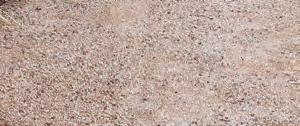









SUSTAINABLE
LOW-WATER GARDENS


TERRA COLLABORATES WITH AN EXTRAORDINARY TEAM OF DESIGNERS, MANUFACTURERS AND ARTISANS ACROSS THE GLOBE TO CREATE EXCEPTIONAL OUTDOOR FURNISHINGS. TURN YOUR OUTDOOR SPACE INTO A PERSONAL SANCTUARY.





















Yesterday a sycamore tree in my backyard that had been barren for months unfurled dozens of tender new leaves. A nascent tangerine tree that had been scorched by a heat wave revealed clusters of buds that now number in the dozens—and, if we’re lucky, will yield buckets of fruit next fall. The wildflowers came back: the first blossoms of blaze-orange California poppies, hints of native purple lupines, lavender-hued flowers peeking from a thicket of Cleveland sage—the thrilling pointillist signs of the coming spring. Yes, these plants have reawakened in California for hundreds of springs, but only in mine for two years because I made the decision to be a custodian of their lineage. And in so doing I join so many people who’ve decided to make a home in the West that’s true to place.
These seasonal surprises are not unlike the stories we tell at Sunset : the inspiring people and places that add to the enduring story of the West, at once familiar but entirely new. In this issue, inspiration takes many forms. For the homeowners of a Washington lake house, it was the video game Minecraft, whose building-block forms made it easy for them to sketch their vision of a dream home. For nursery owner Flora Grubb, it’s a low-water garden born of the droughts we’re facing, but still verdant year-round. For a group of hospitality visionaries in Oregon’s Willamette Valley, it’s a form of travel that’s sustainable and regenerative. For cookbook author Andrea Nguyen, it’s vegetable-forward versions of Vietnamese classics made healthier without sacrificing a bit of flavor. For food activists Vincent Medina and Louis Trevino, it’s a restaurant experience at UC Berkeley’s Hearst Museum that tells the story of the Ohlone people through a spectacular tasting menu of native foods. And for the owners of a century-old home in Carmel Valley, it’s a mindful remodel of this house that first appeared on the cover of Sunset some 80 years ago and now houses an orchard that will support programs for at-risk youth. One and all, they are cultivating a new definition of what it means to live in the West. —Hugh
CHAIRMAN & PUBLISHER
Michael A. Reinstein
EDITOR-IN-CHIEF
Hugh Garvey
DIGITAL DIRECTOR
Sarah Yang
CREATIVE DIRECTOR
Michael Wilson
PHOTO EDITOR
Christine Bobbish
STAFF PHOTOGRAPHER
Thomas J. Story
TRAVEL EDITOR
Krista Simmons
SOCIAL MEDIA EDITOR
Kristin Guy
CONTRIBUTING HOME & DESIGN EDITOR
Christine Lennon
CONTRIBUTING GARDEN EDITOR

Deanna Kizis
VICE PRESIDENT, DIGITAL INITIATIVES
Matt Gross DIGITAL PRODUCER/NEWSLETTER EDITOR
Nicole Clausing
LIFESTYLE CONTRIBUTOR
Camille Styles
SENIOR DIRECTOR, PRODUCTION Jamie Elliott
Sales
SVP, MEDIA SOLUTIONS
Mort Greenberg
VP, PARTNERSHIPS
Kathleen Craven
HEAD OF TRAVEL
Pamela Coffey
HEAD OF OUTDOOR
Kristi Rummel
SVP, REVENUE OPERATIONS
Kelly Facer
DIRECTOR OF AD OPERATIONS
Mindy Morgan
ACCOUNT MANAGER
Cammeo Murray
Marketing
CREATIVE DIRECTOR
Stephen Kamifuji
HEAD OF CUSTOM EVENTS
Tracy Seng
Sunset Media International Corporation
BUSINESS DEVELOPMENT
Tom Griffiths
Graydon Sheinberg
Media International Corporation. All rights reserved. Reproduction in whole or in part without written permission is prohibited. No responsibility is assumed for unsolicited submissions. Manuscripts, photographs, and other material submitted to P.O. Box 15688 Beverly Hills, CA 90209 can be acknowledged or returned only if accompanied by a self-addressed, stamped envelope. For assistance with your Sunset subscription, call 1-800-777-0117. sunset@omeda.com
Garvey, EDITOR-IN-CHIEF



Founded in 1977, and renowned as the originator of the iconic splatter design, Crow Canyon Home is a woman-owned and family-run housewares company dedicated to honoring our connections to each other and the planet. Crow Canyon Home is the gold standard for heirloom quality enamelware that is multifunctional, stylish and made to last.
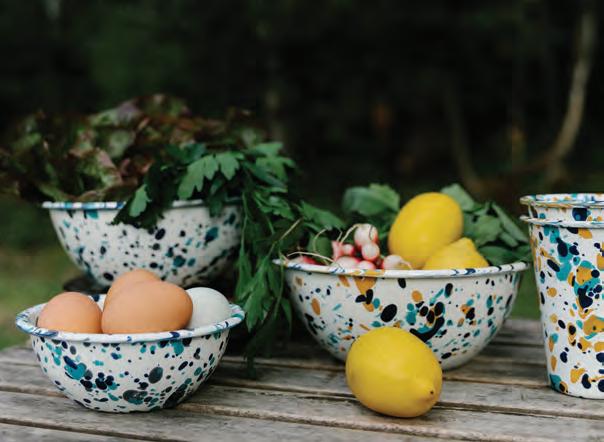

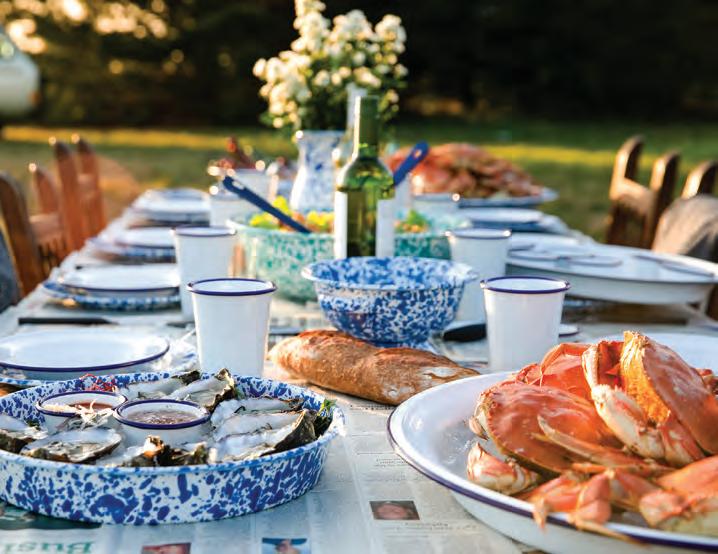

Liberate your houseplants this spring with these tips on styling your outdoor spaces, from plantfluencer Hilton Carter’s new book, Living Wild.
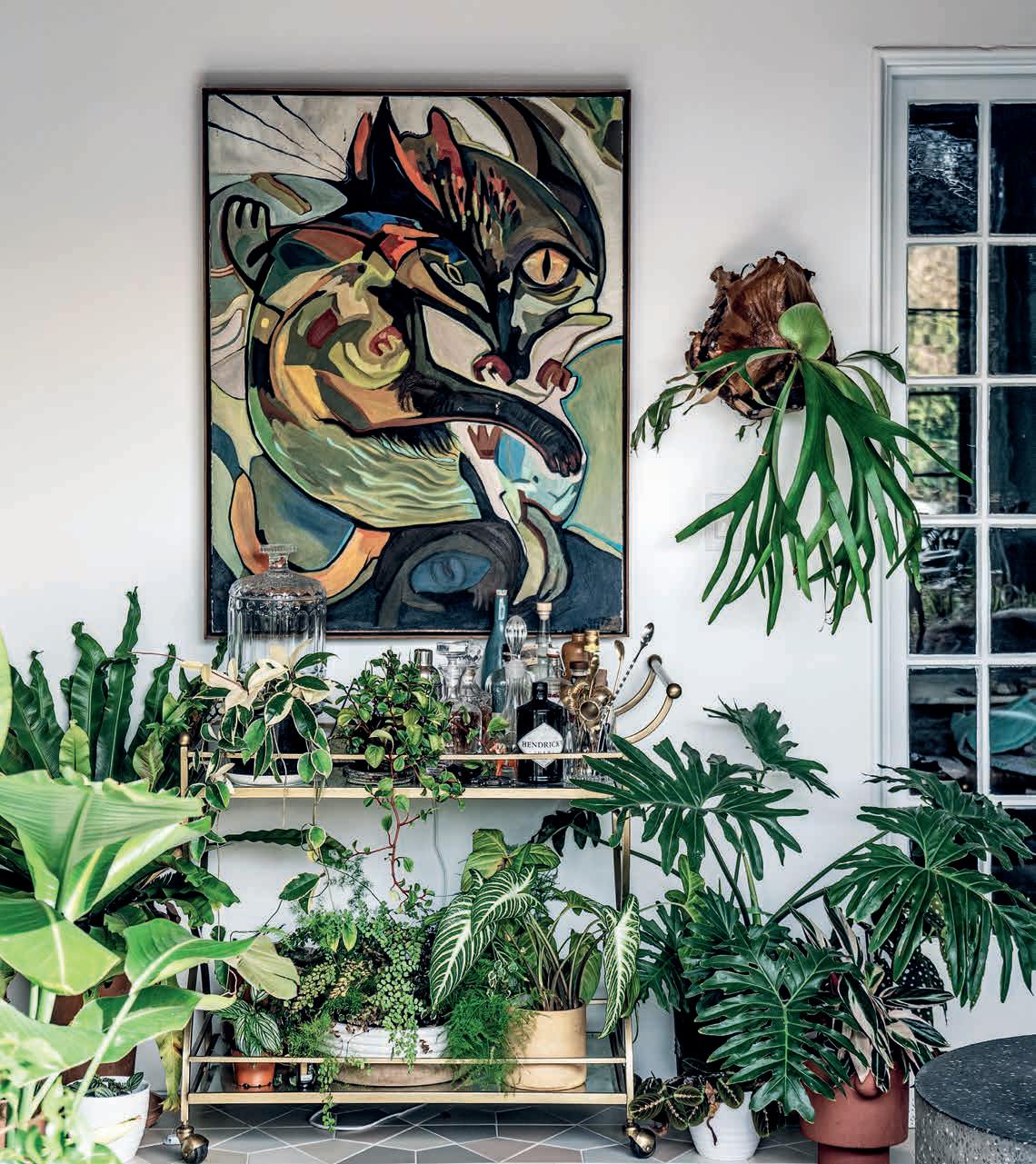
It should come as no surprise that before he became a social media “plantfluencer” with a thriving plant styling business, multiple books to his name, and a product line at Target, Hilton Carter honed his creative skills in Los Angeles, earning an MFA in film at the ArtCenter College of Design. In the lush cinematic photographs of plants he posts on his Instagram, @hiltoncarter, each plant plays the role of a character on the stage of whatever room Carter has exactingly placed it in. The principles behind this dramatic staging are to be found in his new book, Living Wild: How to Plant Style Your Home and Cultivate Happiness. Here are Carter’s tips on how to bring your houseplants outside and turn your outdoor space into an extension of your home as winter turns to spring.
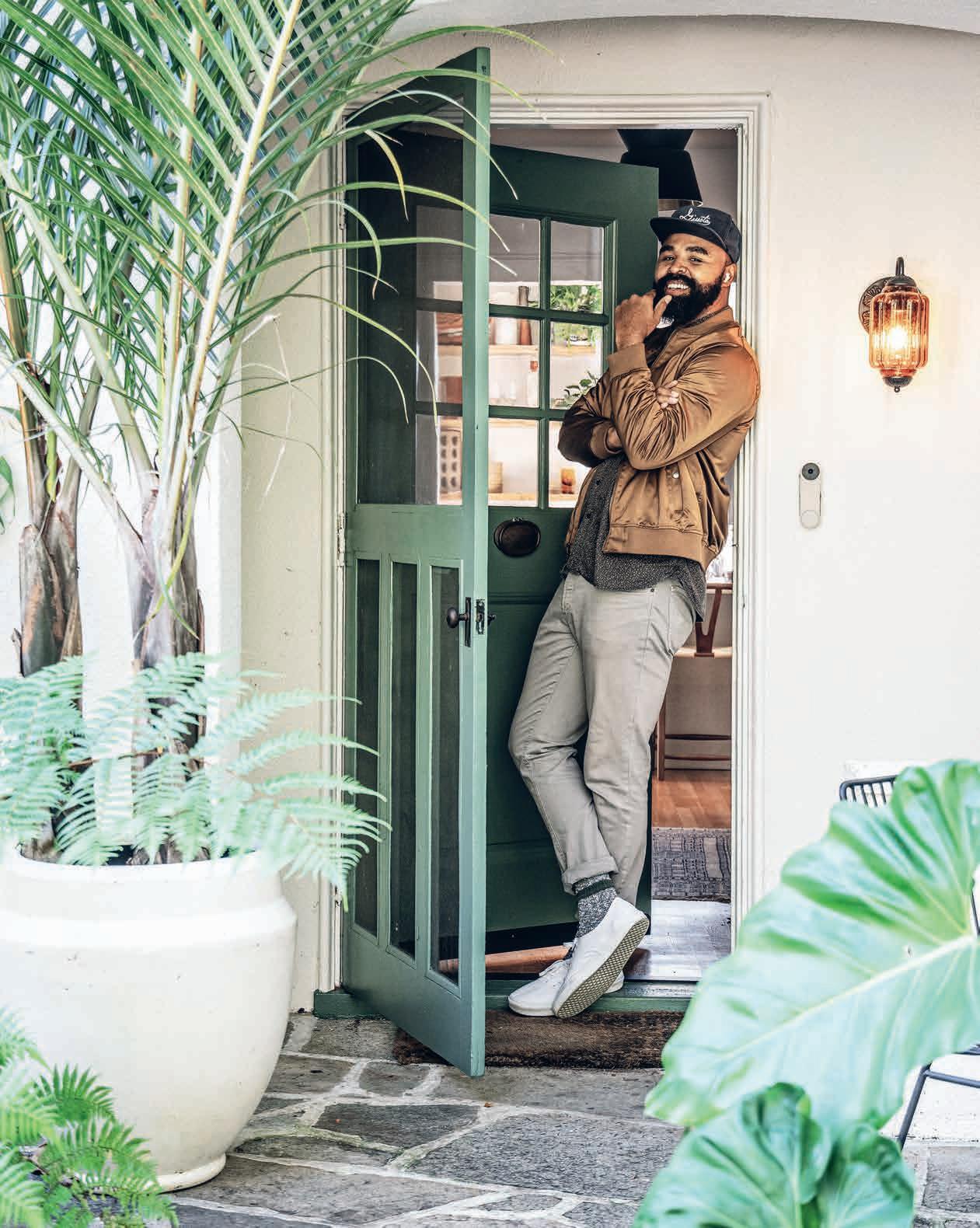
A styling concept I love to utilize is creating groupings. Here I’ve styled a group of cacti and succulents together to create a “desert” moment on the east side of our home.
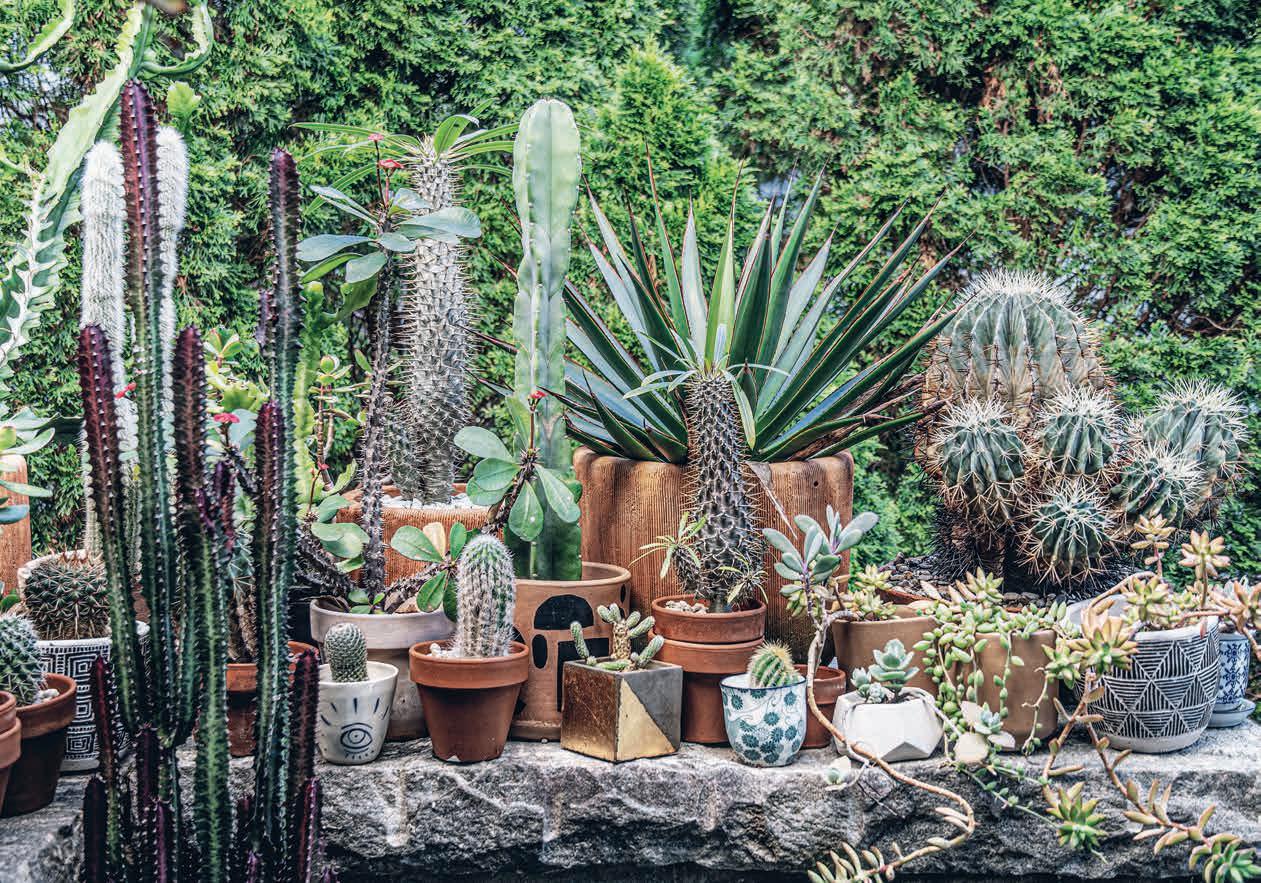
1
Make sure you’re aware of the weather forecast and what the temperature highs and lows will be. A low of above 50ºF/10ºC at night is necessary before you move your plants outside.
2
If you have directsun-loving plants like cacti, succulents, ponytail palms (Beaucarnea recurvata), or crotons, you’ll want to gradually relocate them to sunny outdoor spots. Try placing them on the eastern side of the house for a week or so before moving them to the south or west side of your home for the rest of the season.
3
Acclimatize plants slowly by bringing them outdoors under a shaded area for a few hours and then back inside for a few hours, repeating this step for two to three days before leaving them outdoors for the season.
4
The type of light your plants require indoors will still be the case outdoors. If your houseplants thrive in bright, indirect light, placing them in dappled or lightly shaded areas will be perfect. Any north-facing area of your exterior will work.
5
Beware of local wildlife that might like the taste of your houseplants. Plants like Calathea and Alocasia are tempting snacks for rabbits and deer.
6
If you’ve purchased a plant during spring or summer and have kept it outside all season, make sure to have a plan for its position once it has to come indoors.
When a piece of furniture has a striking color and pattern, placing a complementary plant beside it doubles the effect. In our sunroom, the mix of colors in the painting by Jose Mertz helps to make the bar area feel lush.
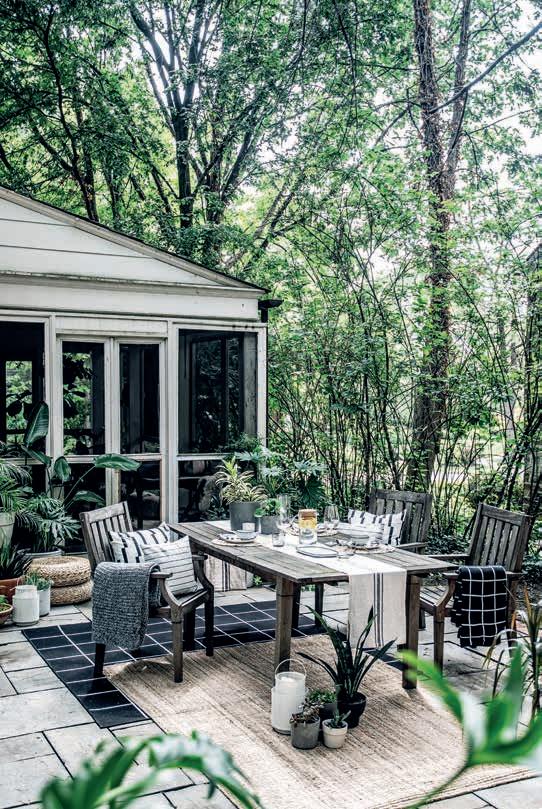
The patio should be treated like an extension of the home, so I styled Jamie and Drury’s with additional plants, lanterns, and pillows, to make a spring evening feel a little warmer. On their patio table, the centerpiece is a Song of India (Dracaena reflexa) and a Peperomia obtusifolia






A perfect warm weather getaway to Medford, Oregon, where water-based adventures and fine wine experiences flow all season long.
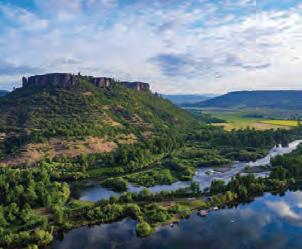

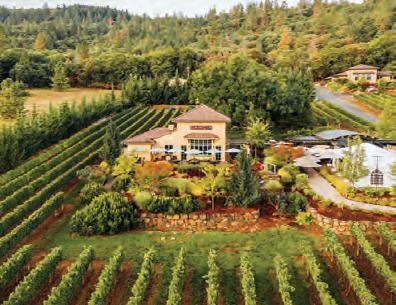

Come spring and summer, Oregon becomes a warm weather wonderland that beckons travelers with promises of cooling evergreen forests, high deserts, rushing rivers, and rugged coastline blanketed in greens and bursts of flora. It is also home to one of the most diverse and rewarding destinations in the West: Medford, the accessible beating heart of southern Oregon’s Rogue Valley, where traffic is a memory in the rearview mirror and an international airport makes navigation a breeze. This is where I spent a week immersed in its undulating foothills, horseshoe-shaped Table Rock islands in the sky, and bustling waterways. With the sparkling new Compass Hotel by Margaritaville serving as my base of operations, I embarked on a taste test of Medford’s adventures spanning water, earth, and sky.
The Medford region is a mecca for outdoor recreation, much of it centering on the water. Fly fishing is a staple of the Rogue River, but for adrenaline-seekers, whitewater rafting and high-speed options, such as tours led by Rogue Jet Boat Adventures, hurl and spin passengers through stretches of river flanked by overhanging trees, historic homes, and a smorgasbord of wildlife. “Theodore Roosevelt once stayed in that home there,” my boat’s guide said, motioning toward a charming cottage that now sits backdropped by a colossal home boasting designs worthy of a rustic resort. “And over there is Jim Belushi’s house,” he continued, slowing his speed to prompt a 360-degree spin that sent each guest row into a chorus of excited screams. A midpoint pitstop landed our boat at Discovery Park owned and operated by the tour company. Here, a lake, outdoor bar, game areas, and a floating music stage marked the beginning stages of what Jet Boat Adventures will soon turn into a completed glamping site and recreation area.
If remaining firmly planted on solid ground is preferable, the Rogue Valley offers hiking suitable for all levels of outdoors enthusiast. My first on-foot trek plunged me into a dome of Douglas fir on my way to Mill Creek and Barr Creek Falls, the 173-foot and 242-foot showers, respectively, that cascade from a sea of forest. Next was a short climb of a Medford staple, the Table Rock Plateaus. Over millennia, erosion of volcanic rock from the rush of the Rogue River has created islands in the sky that contain their own ecosystems on largely undisturbed surfaces, including a protected species of fairy shrimp that only exists in its
springtime mud puddles and millions of wildflowers, one of which only grows here. The dwarf woolly meadowfoam occurs only on the tops of the two Table Rocks and nowhere else in the world! I concluded my outdoor portion with a nighttime drive to Crater Lake National Park, where I sat, as one of only a handful of late-night visitors, and gazed in awe at a dark sky, shooting stars, and a rising Milky Way that, thanks to dark sky preservation, could be easily spotted with the naked eye. Crater Lake National park is not only the only National Park in Oregon but also the deepest lake in the nation.
For the vinous explorer, Medford is a wine wonderland too, a claim it holds thanks to geological features that encourage remarkable diversity from one vineyard to the next despite geographical proximity. Kriselle Cellars, for example, the pride and joy of owner and engineer Scott Steingraber, benefits from sun-drenched, breezesmothered plots that brim with round river rock and silts. The complex land makes the property’s 25 acres of vines produce grapes rich in depth, character, and terroir. Minutes south of Medford, 2Hawk Vineyard and Winery, operated by owners Ross and Jen Allen alongside Winemaker Kiley Evans, benefits from 30 vined acres of the oldest, predominantly volcanic soils that distinguish the Rogue Valley, some of which can be found in only one other location in the world— the Rhône River in southern France. And just 9 miles west of 2Hawk, Dan and Cindy Marca’s ethereal winery Dancin is a breathtaking plot enveloped by cedar, oak, and pine that thrives on the region’s topographical diversity and cooler climates and yields Chardonnay and Pinot Noir, the latter of which is harvested at more than a 3-to-1 ratio in the Rogue Valley due to the region’s conducive climate.
Whatever the activity, whatever the season, there is a welcoming aura among Medford’s residents that permeates, silently enhancing each experience with a hospitality that encourages personal reflection weeks after being its subject. By the end of my trip I came to understand that it is the region’s sense of community that comprises the heart of its identity. And as they did with me, its locals are eager to share it with you. —J.D.
SimkinsThe Sunset Subscription Box delivers the Best of the West straight to your door!
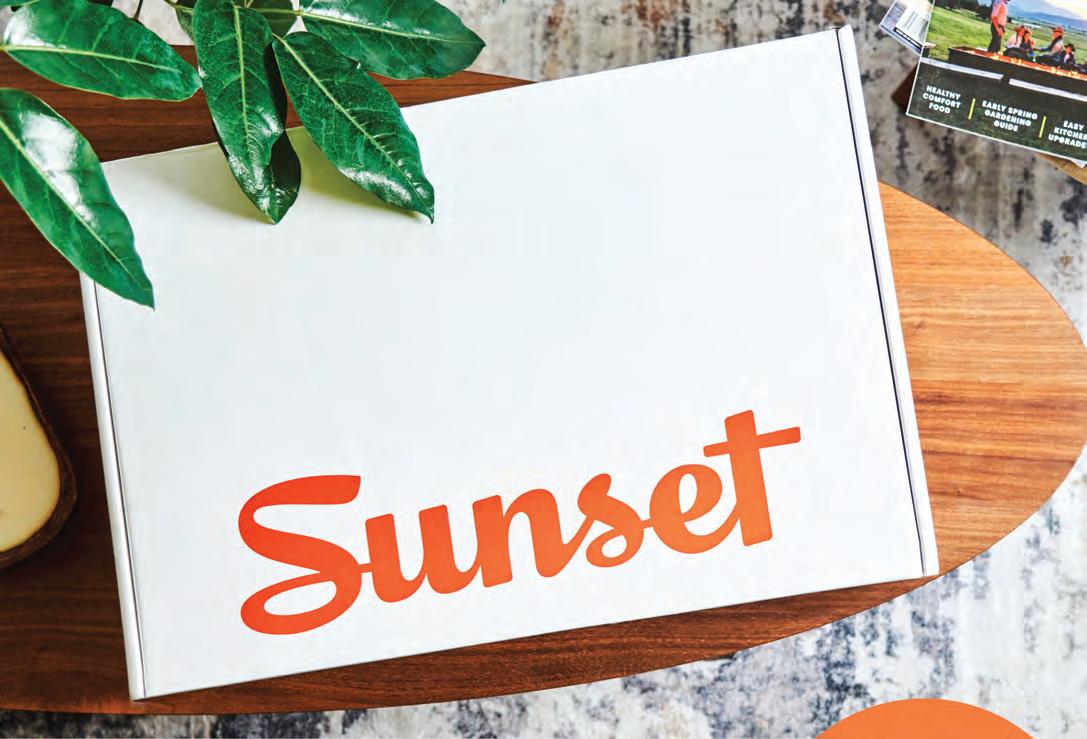
Every three months, you’ll get a box full of home, design, food, and gardening products curated by Sunset editors to help you make the most of every season.
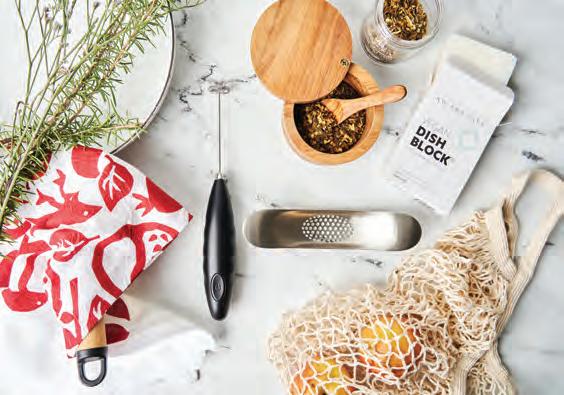
You can choose the box that fits your style and price point, then get ready to be surprised and delighted by what you find inside!
Our next box is full of products for an epic summer: think grilling, camping, and al fresco entertaining.
Past boxes have included goodies like an acacia salt cellar, block printed hand towels, French market bags and more.
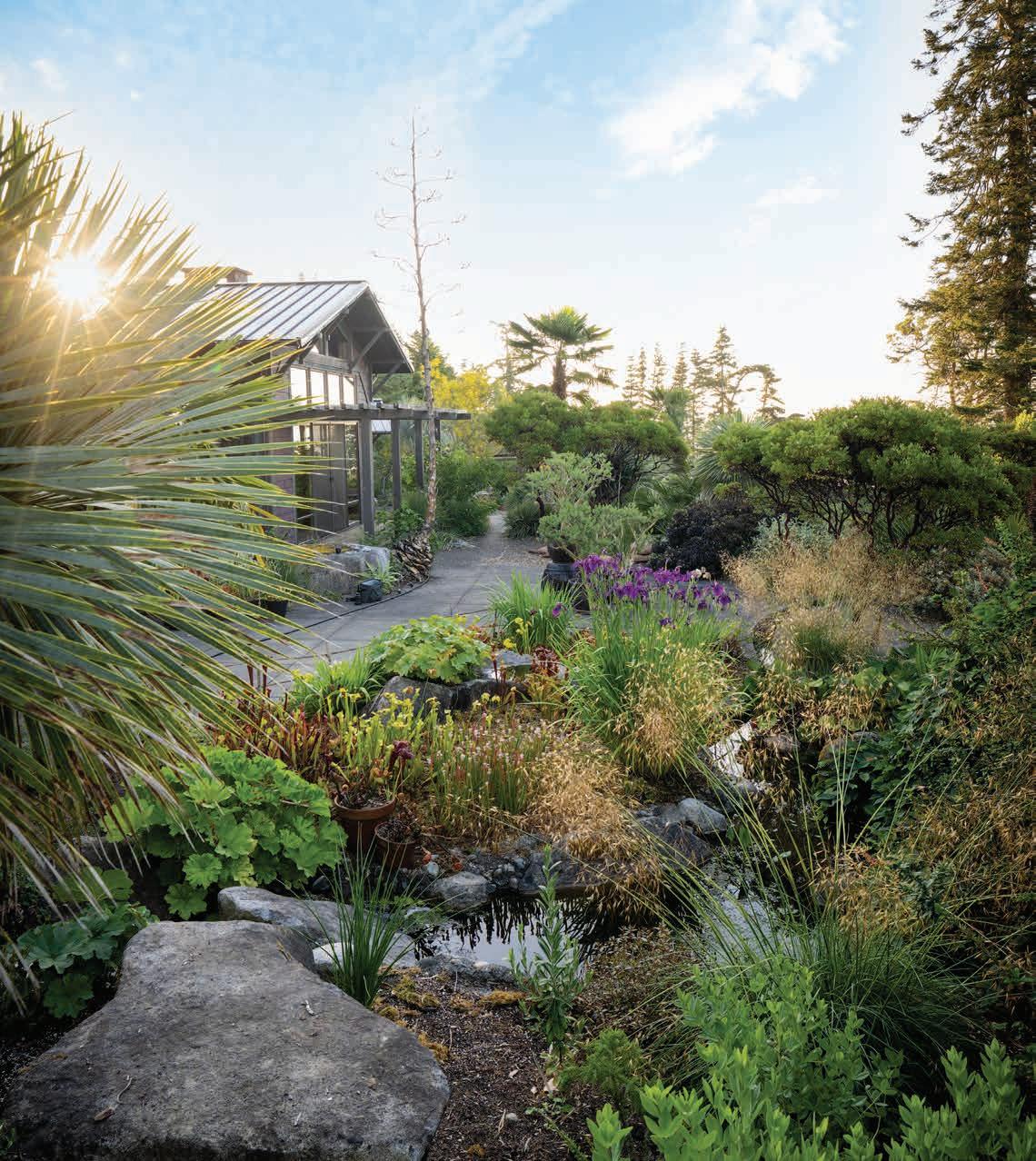 Story by DEANNA KIZIS • Photographs by THOMAS J. STORY
Story by DEANNA KIZIS • Photographs by THOMAS J. STORY
hen I think of a plant hunter —as in, someone who goes to places like South Africa, Vietnam, China, and Nepal to find rare species and bring them back to the United States— I imagine a swash-buckling Indiana Jones type running through the mountains complete with hat and whip. And to hear famed plant collector, horticulturist, and botanist Daniel Hinkley tell it, there is a bit of daredevilry to the job. “I’ve had hard treks, bad knees, bee stings, and leeches hanging from my neck,” he says. “But if I am lucky, plant collecting offers me a bit of seed, and the resulting plant possesses all of the memories associated with it.”
When he’s not covered in leeches, Hinkley can be found in his famed garden, Windcliff, in Indianola, Washington, which extends across six-and-a-half acres on a south-facing bluff high above Puget Sound. It is a garden of astonishing beauty—the culmination of a plant man’s incomparable eye
and vast expertise on how to nurture living things.
Hinkley fell in love with plants at the age of 5. He remembers his first time sowing seeds of morning glories and gourds with his father, and although he can’t explain what exactly the attraction was, he soon promoted himself to head vegetable gardener. This in a family that grew up during the Great Depression and, frankly, didn’t understand why he couldn’t just buy canned beans if he wanted them so much. By high school, Hinkley was collecting houseplants and orchids while studying what grew around him in Northern Michigan. Multiple degrees in horticulture soon followed.
In the late eighties Hinkley opened the world-renowned garden and nursery, Herons wood, in Kingston, Washington, with his then-partner, now-husband, Robert L. Jones. This is when Hinkley began to make his mark. Eager to showcase rare finds—and to follow in the footsteps of his Victorian plant-hunting heroes, George Forrest and E.H. Wilson—he took three months off to search for plants in South Korea. He says he did it because he was drawn to do it, and soon found plant hunting came naturally to him. “I’ve always had that travel bug, so travel and looking at plants was a given for me,” Hinkley says. “It always astounded me that I could be anywhere in the world and people could come up to me and say, ‘What is there to do around here?’ And I’d be like, ‘What are you talking about?
Look at the forest that’s all around.’ ” He says he still feels that anywhere he goes he has entertainment—all he has to do is look out the window and stare at the plants.
When I first communicated with Hinkley, it had to be over email because he was plant hunting in Vietnam on two surgically replaced knees that “got him up the mountains.” I told him it’s hard to imagine how one could procure the seeds of an undiscovered plant from the midst of an entire jungle, but Hinkley says it’s not exactly like that. He has an idea of where to look; usually it’s a place that’s least explored. In this case, he was in an area that was only recently opened to botanists because it was heavily mined during the Vietnam war. There he found a brand-new species of loropetalum (evergreens related to witch hazels) and magnolia—discoveries that, he says, “thrilled him.”
Plant hunter Dan Hinkley and his husband, architect Robert L. Jones, worked together to create Windcliff.
Ninety-nine percent of what Hinkley does happens after he’s collected the seeds of what he suspects is a “new” plant. (I use quotation marks, because, as he points out, the plants are already known to the people who live in the area—they’re just new to us in the West.) First, Hinkley gets the seeds to the USDA. Then, if approved, he has to germinate them, and then he has to bring them to flower, which could take 20 years if it’s a tree. Finally, he needs to find an expert in the genus to look at the plant, confirm that it as an interesting prospect, and send a sample to yet another expert, usually at a university. Only with careful confirmation can he declare he’s found a plant that’s “new to us.”
Which brings us to Windcliff, the personal garden Hinkley started when he sold Heronswood over two decades ago. All around the property are specimens that Hinkley collected over decades of plant-hunting adventures, from
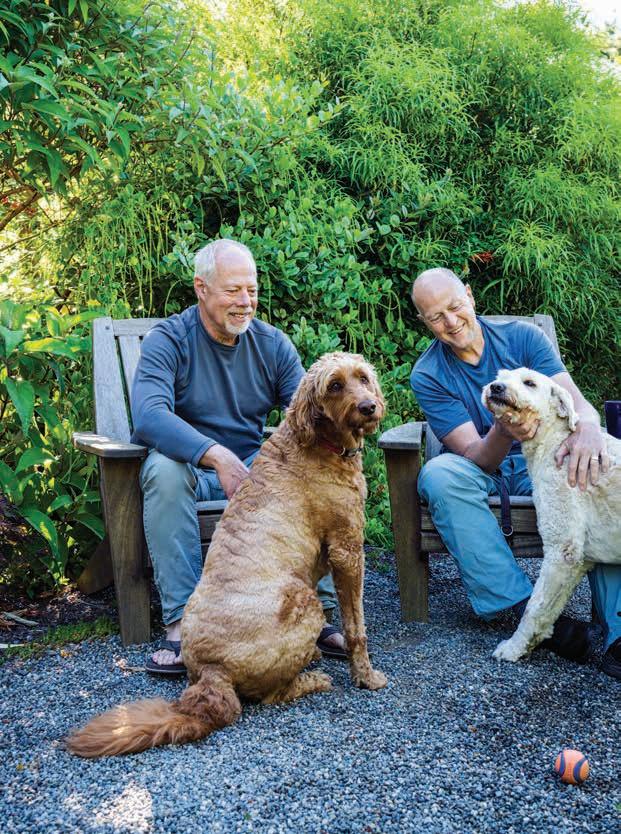
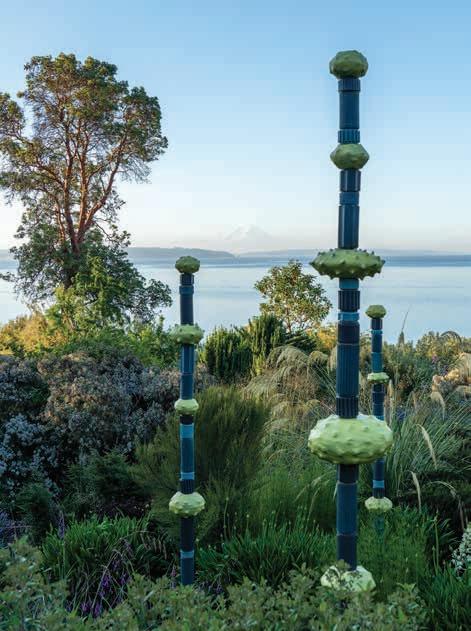


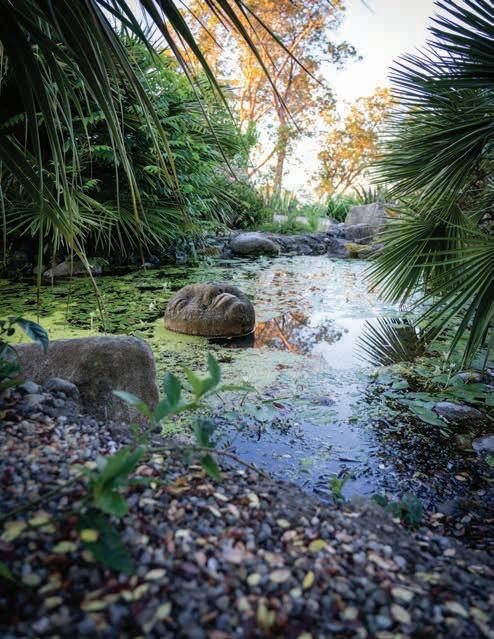
giant-leaved Gunnera tinctoria, which he found in Chile in 1998, to Geranium x oxonianum ‘Katherine Adele’, a hearty and pink-petaled plant that he named for his husband’s mother. Geographically speaking, the garden is carefully arranged, but in a casual way. (This isn’t the gardens at the Palace of Versailles, dieu merci.) To the north is woodland, a meadow, and an arboretum; to the south one can find a pond, a bog, terraces, Hinkley’s beloved vegetable garden, waves of violet agapanthus, and a heavily planted bluff with enormous fir trees that frame the sea. It’s a place positively packed with plants and a living laboratory of sorts, since Hinkley plants his finds in the garden to see how they do.
To create Windcliff, Hinkley commissioned a “council ring” by mosaic artist Jeffrey Bayle, which acts as the heart of the garden, a place where friends gather for fireside chats. He then tackled a third of an acre at a time. Jones, who is an architect, created the terraces and designed the house, while Hinkley relied on his mind’s eye for plant placement, rather than mapping everything out. When designing a garden, he considers textural differences in foliage, height differences, fragrance, seasonality, and overall balance. He also isn’t afraid to go against conventional wisdom, like when he decided to interrupt the expansive view of Puget Sound with plants. “If one has to work a bit for a beautiful view, it makes it more beautiful,” Hinkley

Counterclockwise from top left: Hinkley uses Cortaderia fulvida flowers as a grass; a new hybrid, Alstroemeria ‘Indian Summer,’ which is native to the Southern Andes; The foliage of a hardy ginger, Hedychium maximum and a developing seed head on a Magnolia sapaensis, both collected by seed in northern Vietnam in 1999.
says. “I do not feel it is necessary to sit in a BarcaLounger and survey my entire property.”
Surprisingly, Hinkley doesn’t employ a large staff to maintain the garden; he does it himself with the help of his employee of nine years, Eduardo Montes. To finance the maintenance, Hinkley sells plants out of his nursery, which can only be shopped in person. The online catalogue is worth a read. Of Acer griseum, a tree of wild origin, Hinkley writes that it’s so beautiful “you should plant it for yourself and your children.” Agapanthus ‘Jamaica Kincaid’, meanwhile, flowers with “a blue somewhat deeper in color than the perfectly blue skies you once remembered a long time ago.” Fortunately, although plants can’t be shipped, visitors can see the garden and shop the nursery at Windcliff three days a week by appointment.
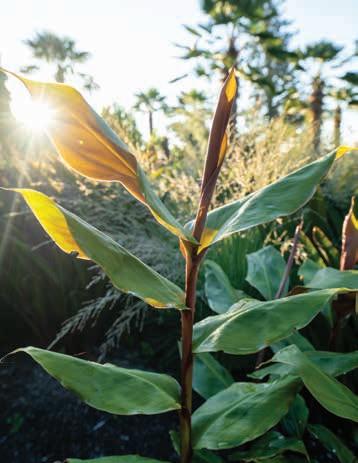


Although I still can’t help but imagine plant hunters as hacking through acid-green jungles to chop down large plant stalks by racing rivers, I have been convinced that it is, in fact, not quite so cinematic. Hinkley looks for plants not in spring but in the fall, when they have gone to seed. “I feel at age 70 the number of autumns I’m going to get to do is starting to diminish, but I still want to do it,” Hinkley says. “Even though I can be completely exhausted by the garden and by propagating, the next day I’m in it again. The fuel cells never stop pumping.”
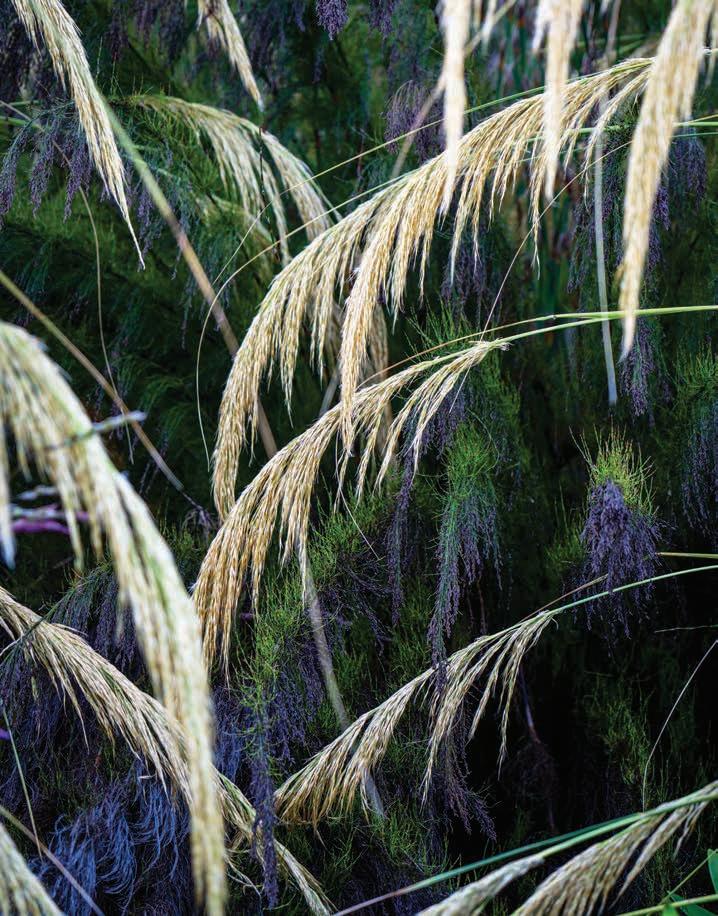
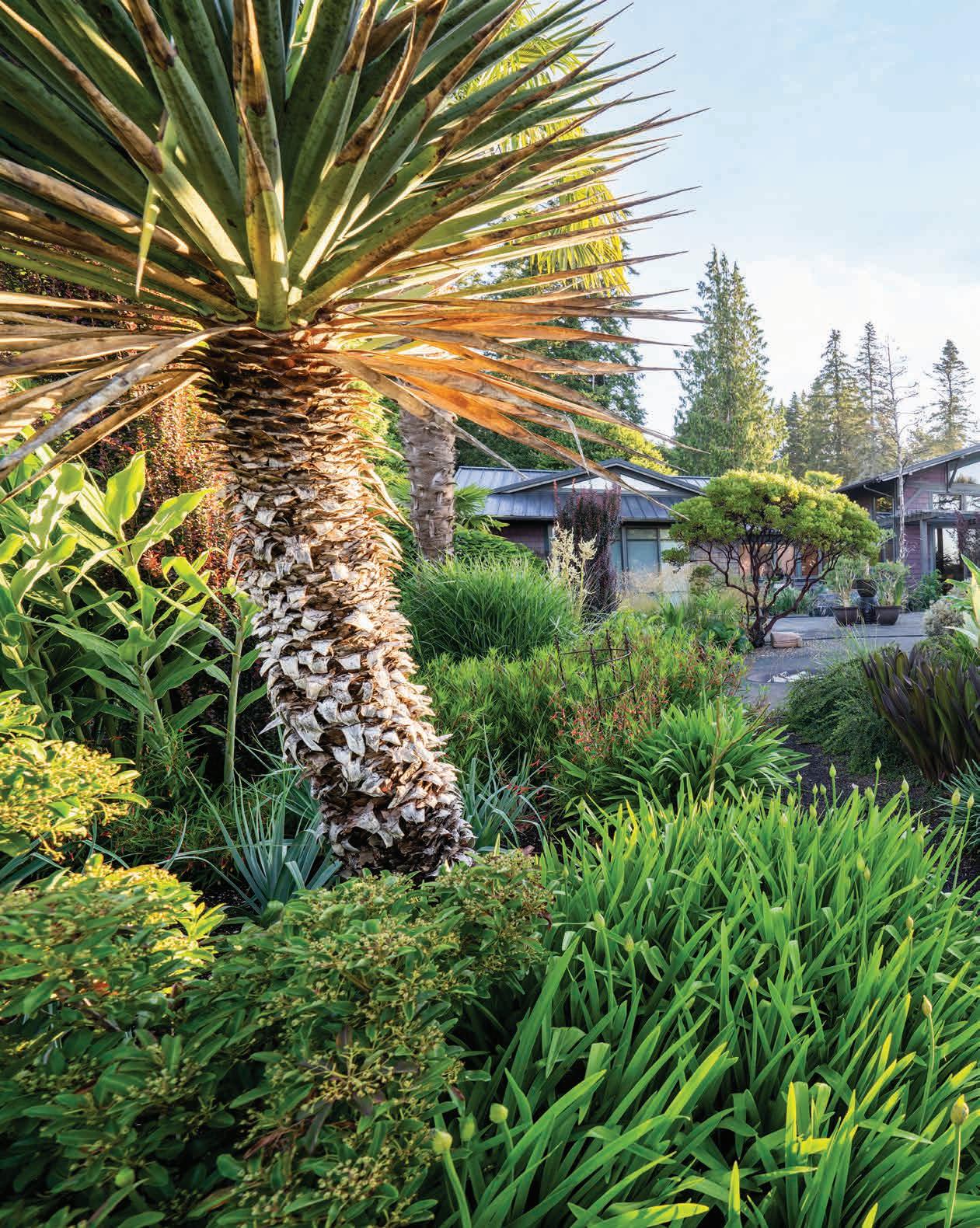
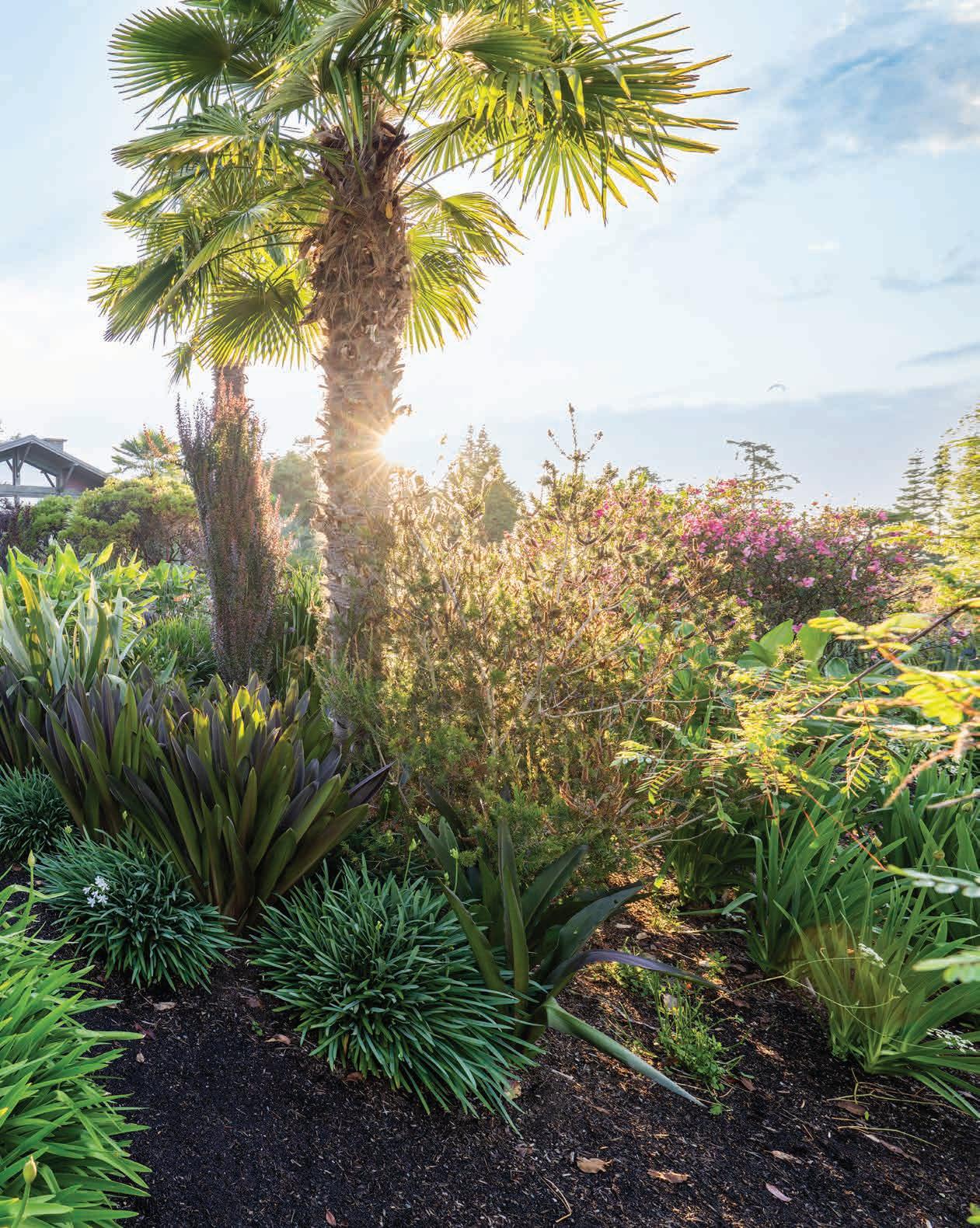
“Anywhere Hinkley travels as a plant hunter he has entertainment. All he has to do is look out the window and stare at the plants.”


PLANTSMAN DANIEL J. HINKLEY has been lauded by one prestigious horticulture organization after another, and is something of a rock star on the botanical lecture circuit. Martha Stewart calls him a “horticulturist extraordinaire.” Meanwhile, Jonathan Pedersen, CEO of plant grower Monrovia, says, “There are plant hunters, and then there is Dan Hinkley. His importance to the world of gardening cannot be overstated.”



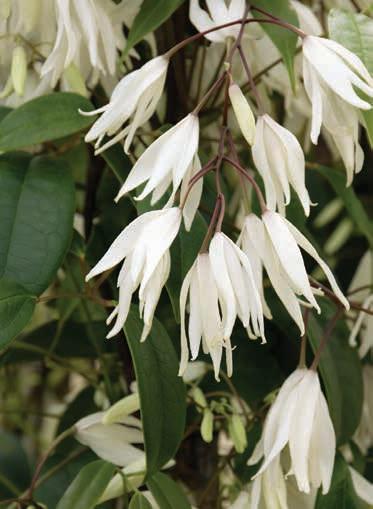
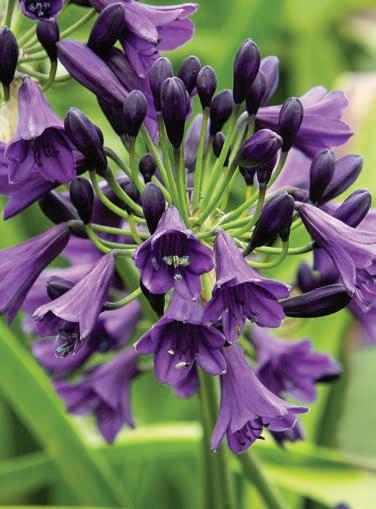
Perhaps because he is a famous plant hunter, Hinkley is careful to point out that his expeditions are entirely aboveboard. “When many people hear what I do, their immediate assumption is that I smuggle seeds back in my suitcase,” he says. However, he has all the necessary permits to bring seeds or plants out of a country and into the U.S., and he avoids plants that are bio-invasive with help from the University of Washington. Here, six of Hinkley’s discoveries that you can buy from Monrovia’s Dan Hinkley Collection.
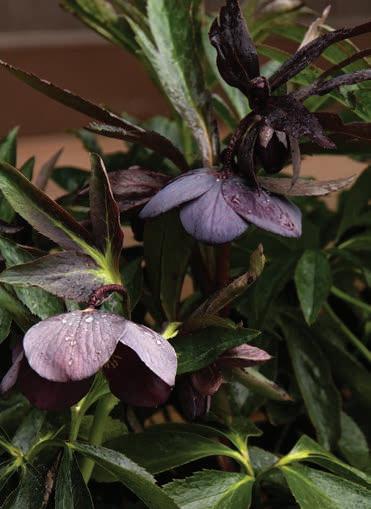 fig.1
Windcliff Slatey Blue Hellebore Native to Asia
fig.1
Jurassic Pterodactyl Anthurium otophorum Native to Japan and East Asia
fig.1
Purple Potion Agapanthus From South Africa
fig.1
Orange Peel Jessamine From South America
fig.1
Heavenly Ascent Holboellia Vine Indigenous to Asia
fig.1
Windcliff Fragrant Pachysandra Native to Asia
fig.1
Windcliff Slatey Blue Hellebore Native to Asia
fig.1
Jurassic Pterodactyl Anthurium otophorum Native to Japan and East Asia
fig.1
Purple Potion Agapanthus From South Africa
fig.1
Orange Peel Jessamine From South America
fig.1
Heavenly Ascent Holboellia Vine Indigenous to Asia
fig.1
Windcliff Fragrant Pachysandra Native to Asia
Nothing influences the feel of a home quite like the materials from which it’s made. So, when it came time for Camille Styles to refine the exterior of her Malibu home, she looked to the natural beauty and durability of California redwood, sourced from Humboldt Sawmill, for her coastal property, Sunset’s 2023 Idea House.

Choosing materials and methods that best honor the earth has been paramount for Styles during her renovation. Given that Humboldt Sawmill is dedicated to such makes the company and its redwood and Douglas-fir even more

“There are certain materials I’ve always been drawn to, and they usually come from the earth—stone, wood, linen, and clay,” says Styles. Since wood illuminates the natural raw beauty of coastal California, it was the perfect fit for the home’s exterior. “The soul of the house is surf shack vibes, and we knew that a wood-clad exterior would capture the timeless, beachy essence we were after.”
While researching domestic wood species, Styles was intrigued by the natural beauty and durability of California redwood. She decided it was the right fit after talking to the team at Humboldt Sawmill. “They shared details about redwood’s strength and natural resistance to termites and decay,” which is a consideration for coastal living, adds Styles.
Even more, the purity of the material was compelling. As the team at Humboldt Sawmill confirms, all the redwood and Douglas-fir the company offers are completely natural wood products. They’re not derived from plastics or petroleum-based sources, which makes them an ideal fit for the organic environment that Malibu embodies.
When installed, the beauty of the wood is evident, but over time it will patina to a driftwood gray tone fitting with the aesthetic Styles is hoping to obtain. As she adds, she loves the warm tones of redwood even more with age. “So we’re working with our builders to treat the wood so that it develops that beautiful grayed-out color even faster.”
compelling. The timberlands, manufacturing, and distribution operations of Humboldt Sawmill are certified to the standards of the Forest Stewardship Council® (FSC® C013133). Harvest rates for Humboldt Sawmill redwood and Douglas-fir are only about 1 percent of the total inventory of trees the company owns, meaning that the company grows significantly more trees than it harvests annually.
Architects, consumers, contractors, and developers can be assured that Humboldt Sawmill redwood

and Douglas-fir lumber and timbers are produced to the highest possible environmental standards.
And because all Humboldt Sawmill redwood and Douglasfir products are manufactured in California, their overall carbon footprint of transporting the wood to Styles’s Malibu home location is relatively low compared with materials from further away.
Styles says that the most impactful design decisions are usually the ones you agonize over, “since the final verdict can completely change a home’s appearance.” But the energy spent choosing Humboldt Sawmill redwood will prove worthwhile for decades and beyond.


The Backyard Farm Company, from Marin, California, created this English Potager garden in Novato to give high-yields of vegetables and flowers and be a pleasant space in its own right.
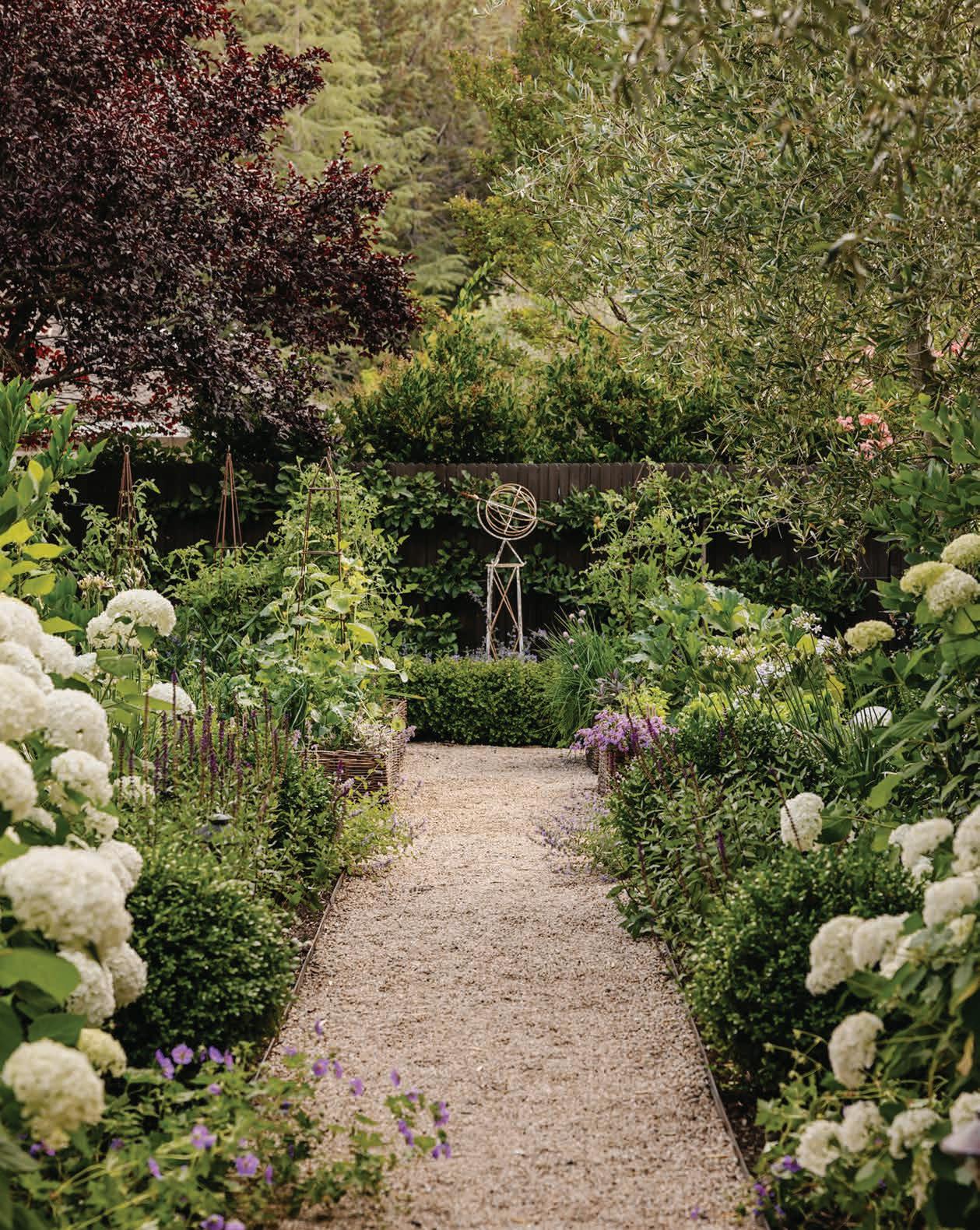
Create an herb meadow by sprinkling seeds of cilantro, dill, and parsley in sunny garden beds that are close to the kitchen for easy access.
For instant impact in warm climates, plant durable barrel cactus. Try Mexican fire barrel (Ferocactus pringlei) for red spines; for yellow, go for the ever-popular golden barrel (Echinocactus grusonii).
Plant tomatoes outside once daytime and nighttime temperatures stay above 55°.
Slugs do maximum damage in spring by mowing down tender seedlings as they emerge. Bait for them or kill them as you see them (they’re easy to spot in damp weather or after you water).
Combat powdery mildew by hosing off foliage in the morning several times a week to wash away fungus spores. Treat outbreaks with a formula of 1 Tbsp. baking soda plus 1 Tbsp. canola oil to 1 gallon water.
Use plastic baskets from cherry tomatoes or strawberries to protect newly sprouted seedlings from birds. By the time the seedlings have grown tall enough to reach through the tops of the baskets, they are no longer as tender as the birds prefer.
Check for birds’ nests before pruning shrubs and trees; leave them alone until eggs have hatched and baby birds are out of the nest.
For easiest removal, hoe weeds in the early morning
the day after watering.
Replenish organic mulch on planting beds. To prevent evaporation of soil moisture, aim for a mulch layer of 2–4 inches deep. Do not pile it around plant stems.
Divide overcrowded clumps of ornamental grasses by cutting back their tops and slicing the root ball into sections with a shovel. Transplant divisions immediately and water regularly until the grasses are re-established.
Say you’ve jumped into gardening full throttle, planted your raised beds, and then you have … problems. Who you gonna call? May I suggest the Backyard Farm Company? The brainchild of Marin, California, landscape architect Christian Douglas, this coalition of designers and farmers has all the resources you’ll need, from their “Phone a Farmer” service to e-books to a downloadable course for newbies. “The company sprung out of a desire to create a live platform for people to build knowledge,” Douglas says. “We want people to have confidence when it comes to growing their own food.”
“We want people to build on their suc
cesses,” Douglas says, “so starting with easy plants are best.” He recommends radishes, leafy greens, summer squash, and cherry tomatoes.
“Typically, an eight-by-four-foot vegetable planter box can grow a lot of food if you use arches and trellises to maximize your vertical growing space,” Douglas says. But before you go skyhigh, consider how much time you have on a week-to-week basis to tend to your plants.
Some plants do better if you start them as seeds; others grow better if you start them as seedlings. Douglas recommends direct sowing root vegetables like beets, carrots, turnips, and
legumes. Tomatoes, peppers, eggplant, and cucumber benefit from being started as seedlings first.
“We often say we feed the soil; we don’t feed the plants.” says Douglas. “It’s a bit like our immune system— weak soil makes plants more susceptible to disease and predators.” To amend the soil, add organic matter like compost, worm castings, and compost tea.
Douglas is a big proponent of making a vegetable garden stylized as opposed to treating it like a second-class citizen. He recommends investing in obelisks, trellises, plant labels, and pretty pots. Says Douglas, “Elevate your materials to make your garden important. The key is to celebrate it.”
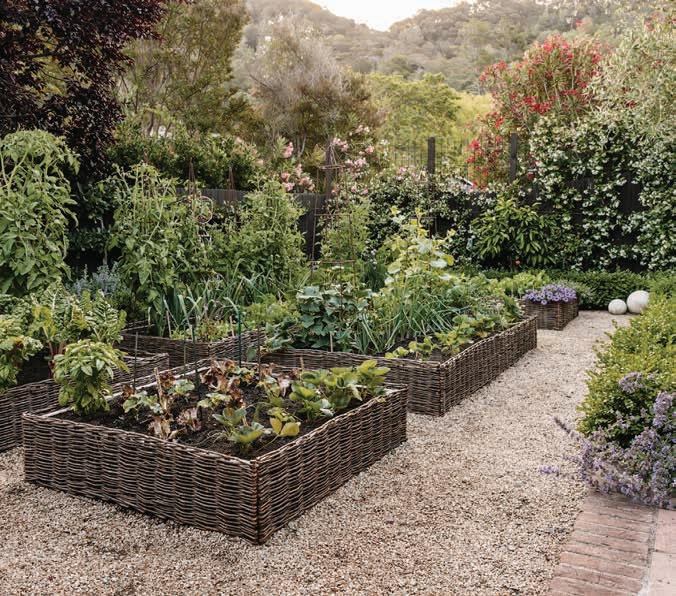
As America’s dahlia obsession continues, I’m sometimes asked how and when to plant tubers. One way is to plant them the same time you plant your tomatoes; another is after the last frost, which, depending on your area, is between April and June. Other tips for success: Stake your dahlias when you plant so you don’t damage roots later; plant the tuber a few inches deep with the crown (the part with the eye) face up; and pinch back the top of the plant a few times over growing season, so the plant will put more energy into growing blooms.
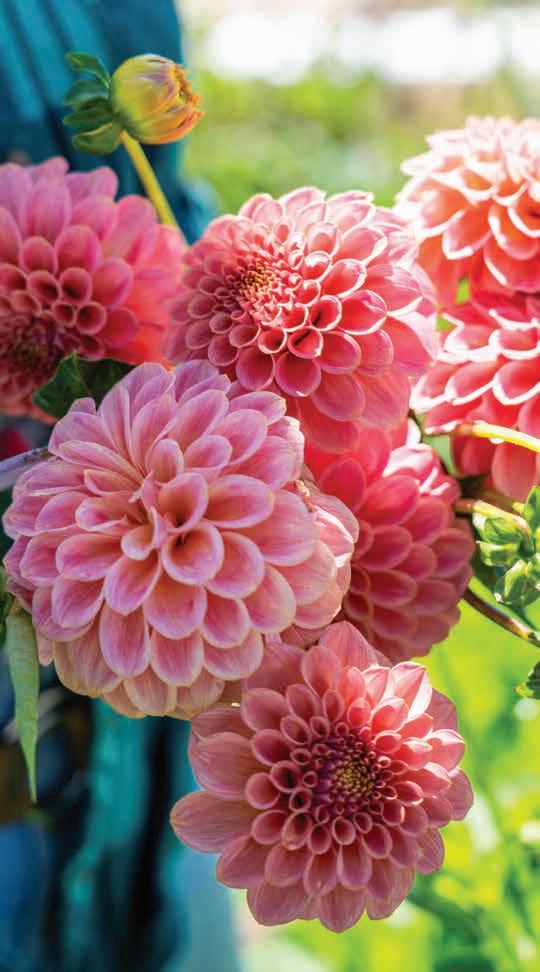
Kelly Smith Trimble, the author of The Creative Vegetable Gardener: 60 Ways to Cultivate Joy, Playfulness, and Beauty Along with a Bounty of Food ($19.99; Storey Publishing), doesn’t always view gardens in a typical way. Yes, her book is full of solid advice for the newcomer and seasoned gardener alike, but there are also gems throughout that make her work stand out.

“A garden can be really good for mindfulness,” Trimble says, recommending that you meditate in the garden. “You can sit in silence and listen to the ambient noise,” she says, adding, “In the book, I wrote about using the loving-kindness meditation because I think it’s a good starting point.” To do it, you extend kindness and love from

yourself to other beings—especially your plants. Trimble is also a proponent of letting herbs and lettuces bolt once in a while—something few gardeners do, preferring instead to pull the plant and replace it with another. “If you leave the plant, you get to see and appreciate the full life cycle,” she says. “And it attracts beneficial insects, too.”
Finally, Trimble recommends trying yoga in the garden if there’s enough room. “One of my favorite parts of writing the book is that everyone talks about their garden being their happy space,” Trimble says. “Gardening is like yoga and meditation in general. Sometimes you don’t want to drag yourself off the couch to do it. But if you do, you’ll be honestly glad you did.”

A truly inviting home designates areas for relaxation. And at its best, a well-designed bathroom can be a haven—a place to enjoy solitude and rest. In this year’s Sunset House, Camille Styles is dedicated to transforming the bathrooms in her 1950’s beach house renovation from purely utilitarian to serene and spa-like. Here’s how she’s incorporating the impeccable design and efficiency of Duravit to bring her idea to life.
Styles has a notable affinity for organic, timeless aesthetics, which she is weaving into the renovation of her beach house in Malibu. She also loves efficiency—elements that deliver utility with ease. This mix drew her to Duravit, a revered company that has been bringing bathroom solutions—from toilets to bathtubs to faucets—to homes, hotels, offices, restaurants, and more for over 200 years. “The collections deliver high-quality that convey a timeless quality,” says Styles, “with a functionality that works seamlessly and adds a sense of ease to everyday life.”



Styles’ sentiment aligns with the focus of Duravit, which is to enhance daily life through outstanding design and smart functionality. Our days begin and end in the bathroom, points out Kerry Rudd, VP of Sales - National Wholesale for Duravit USA, so this space is integral to how we feel. “Duravit looks at the bathroom as the centerpiece of the home —a place to unwind, recharge, and spend some time alone,” adds Rudd. “Whether it is a product such as our SensoWash shower toilet, or one of our numerous bathtub options, Duravit upgrades our customers everyday.”

For the primary bath and powder room, she chose the Sensowash toilets from Duravit’s Soleil by Starck, a sea-inspired collection
designed by revered French architect and designer Phillipe Starck. Completing the look will be natural wood vanities from the White Tulip Collection, another series brought to life by Starck. The overall aesthetic is timeless, pulling inspiration from the natural world,” says Styles. “Duravit does this so well with its classic designs, clean lines, and organic materials.”

For Duravit, every detail is critical, from the curve of a faucet to the clean lines of a bathtub. This attention to detail is why the company has garnered some of the most acclaimed international design awards on an annual basis, notes Rudd. It’s also a reason why design-minded creatives like Styles trust not only the unparalleled quality but the beauty it adds to such critical spaces, the ones we look to for wellness and respite, day after day. “It all makes my at-home bathrooms feel like a spa,” says Styles. “Calming and serene.”
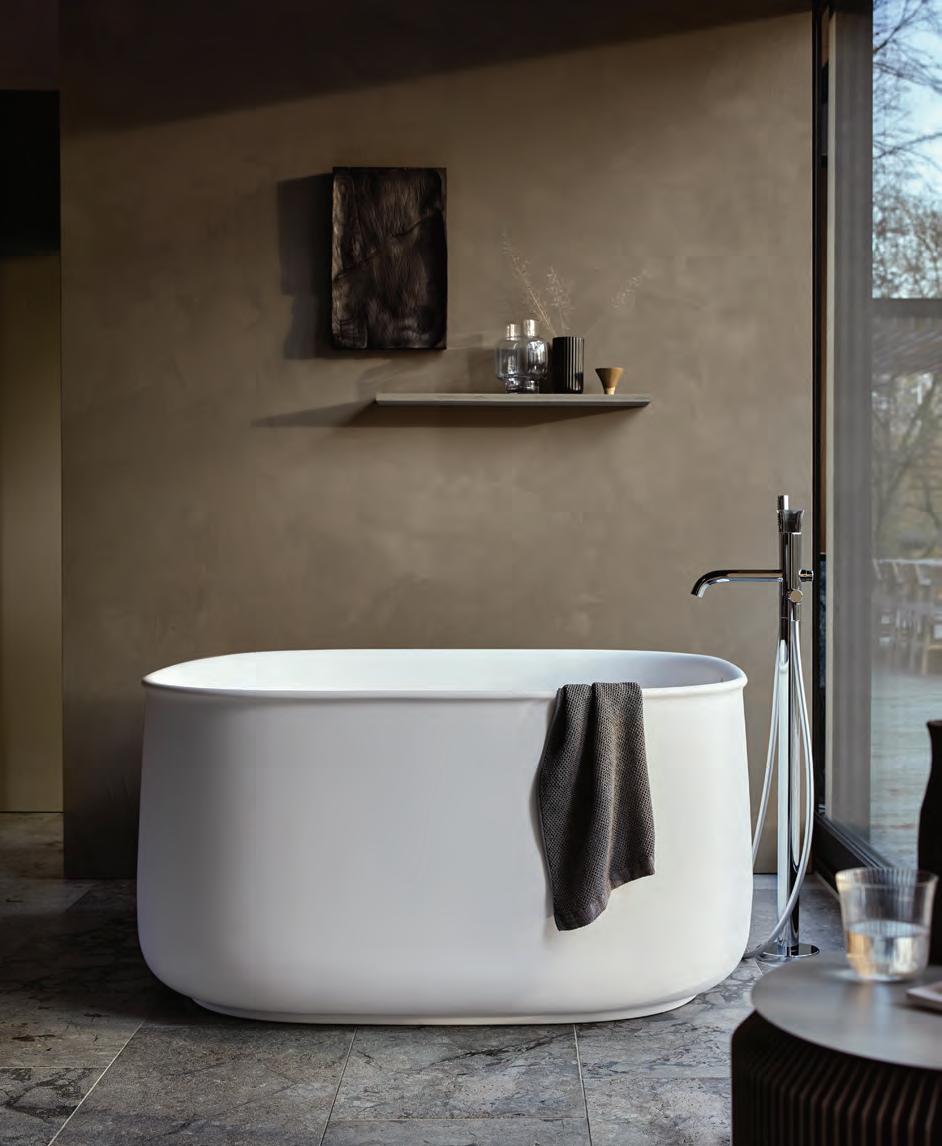
A LOVE OF DANISH DESIGN AND MODERN ARCHITECTURE INFUSED THIS LAKE HOUSE, WHICH
SPRANG FROM THE IMAGINATION OF A VIDEO GAME EXECUTIVE WITH SOPHISTICATED STYLE.
Story by CHRISTINE LENNON
Photographs by THOMAS J. STORY
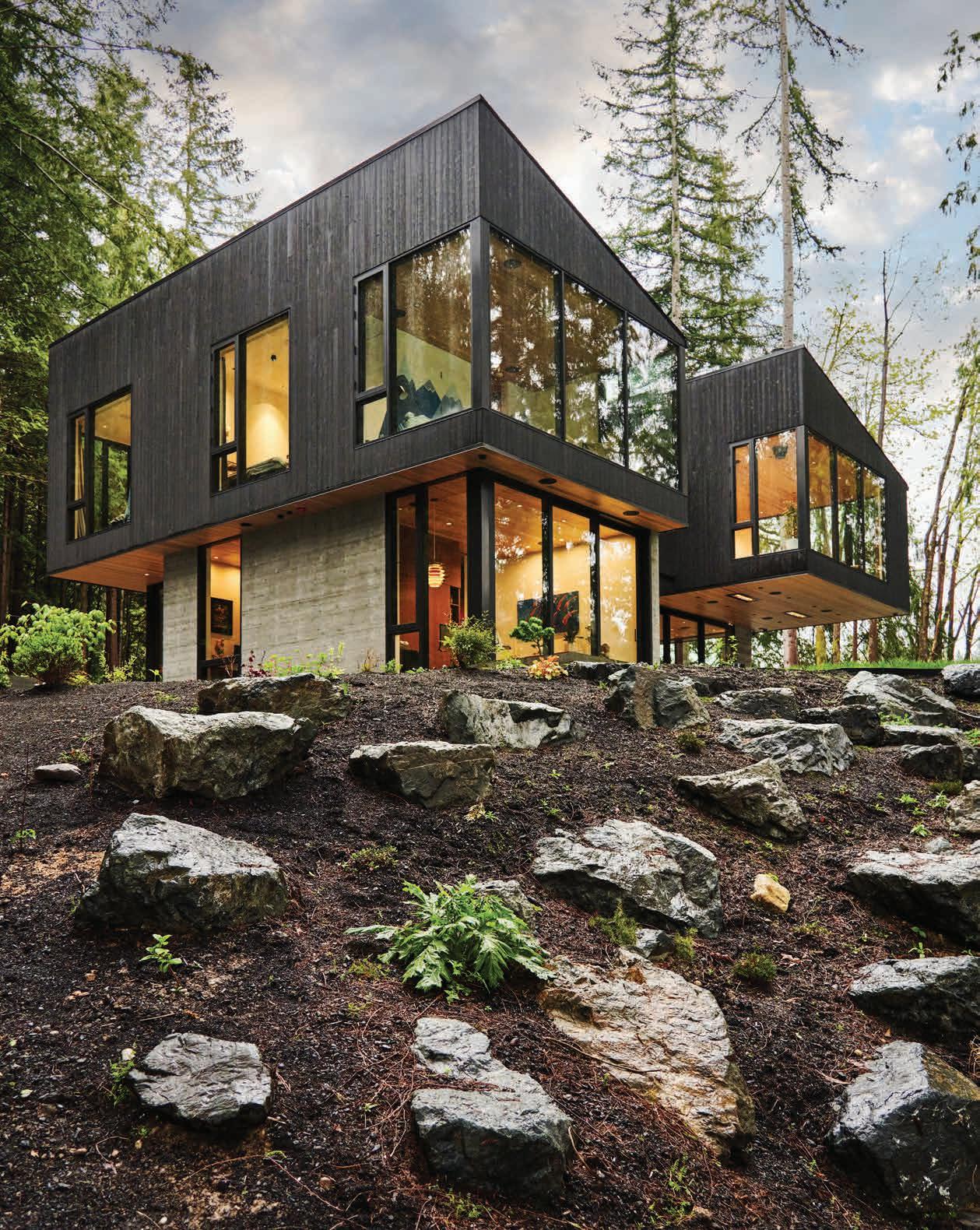
rchitect Ryan Stephenson has had clients come to him with plenty of dream-house visual aids. They’ve arrived with sketches, tear sheets from magazines, or Pinterest pages. But the Minecraft model that his clients Michael and Siobhán Persson presented him, with a dream house designed in the game’s blocky 3D style, was a first.
“At the time, I didn’t even know what Minecraft was,” Stephenson says. “And I’d never had someone come to me with a computer model of any kind. It was a unique way of expressing their thoughts.”
It’s no coincidence that at the time Michael was a top creative executive for the Microsoft-owned game. He knew precisely how to replicate the terrain of their newly acquired lakefront lot near Redmond, Washington, to design a basic
blueprint for a home that took full advantage of the site, which is a promontory with water views on three sides.
“I held up the game and said, ‘Can we build one of these?’ And Ryan took the challenge,” Michael says. “Of course, it wasn’t exactly how I imagined it, but the orientation is the same.”
The couple discovered the neglected lot, which was the former site of a Boy Scout camp, when they spotted a for-sale sign while kayaking. They knew the area well. Michael has two children from a previous marriage and an infant with Siobhán. The older boys grew up on the private lake, which is a 15-minute drive from the Microsoft headquarters, and also a world away. This parcel of land felt like a secret.
“We didn’t realize there was a cabin on the property,” says Michael. “I went to see it on a whim and discovered it had 150 feet of shoreline.”
Because of land conservation easements written to protect the lake and surrounding wetlands, there were building codes in place that prevented new construction. The pre-existing cabin allowed them to build a new, environmentally sensitive home.
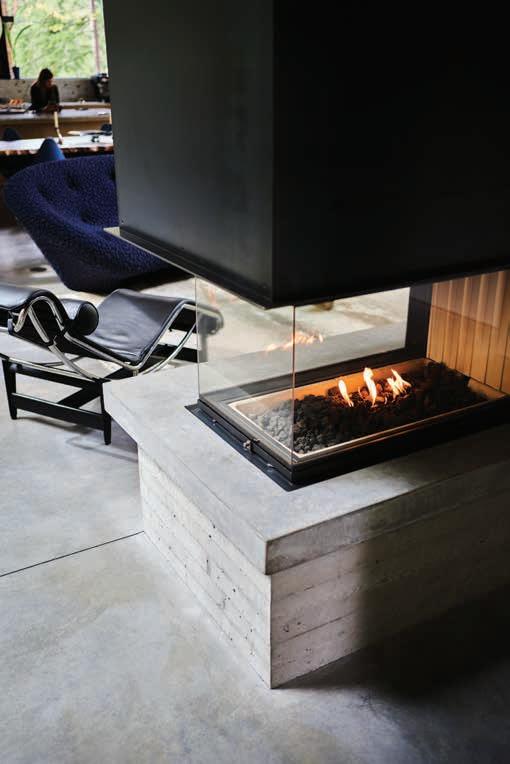
“We worked one step at a time,” Michael says. “The first survey said that it was a trash lot. Even though it’s two acres, they reported that there was no spot for a septic system because of the wetlands. It was like a puzzle. It took us almost five years to solve it.”
The basic premise, as Stephenson remembers it, was a two-story home with bedrooms on top to take advantage of the water views and the tree cover for privacy, and a living

The 150 feet of lake frontage presented many opportunities and challenges for the Perssons, who were committed to developing the land—home to beavers, bobcats, and bald eagles— in an environmentally sensitive way.
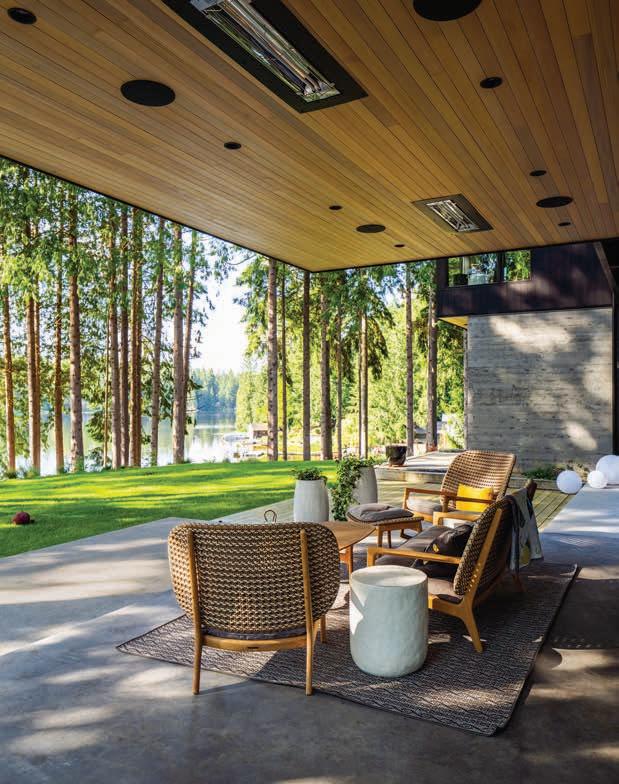
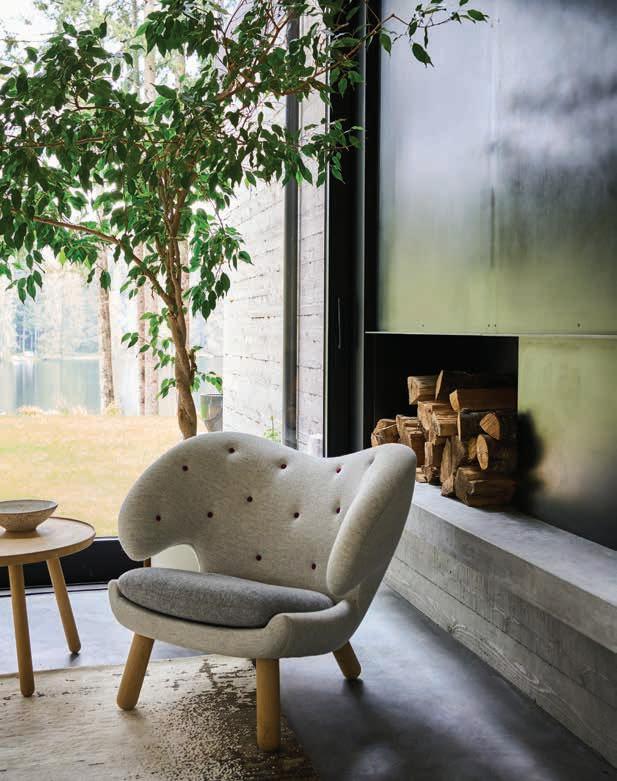
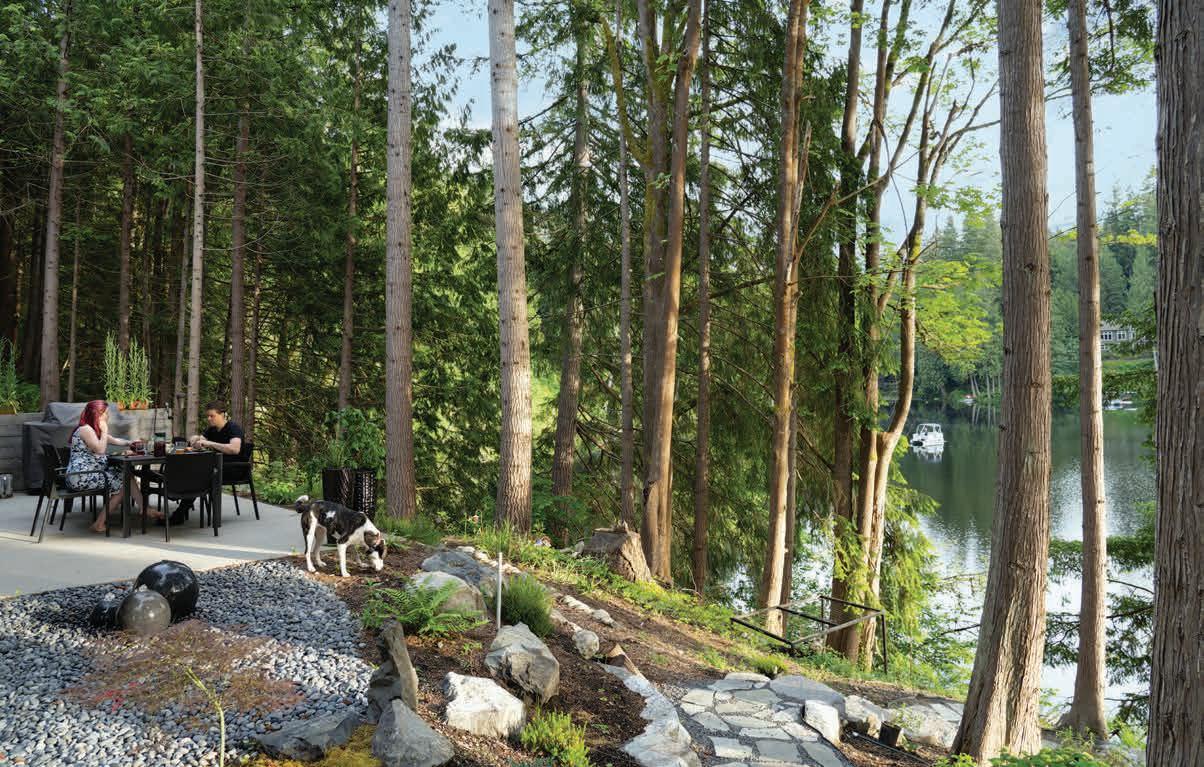 Equipped with built-in heaters and protection from the frequent rain, this outdoor patio functions as a second living room.
Pelican chair by Finn Juhl.
Equipped with built-in heaters and protection from the frequent rain, this outdoor patio functions as a second living room.
Pelican chair by Finn Juhl.
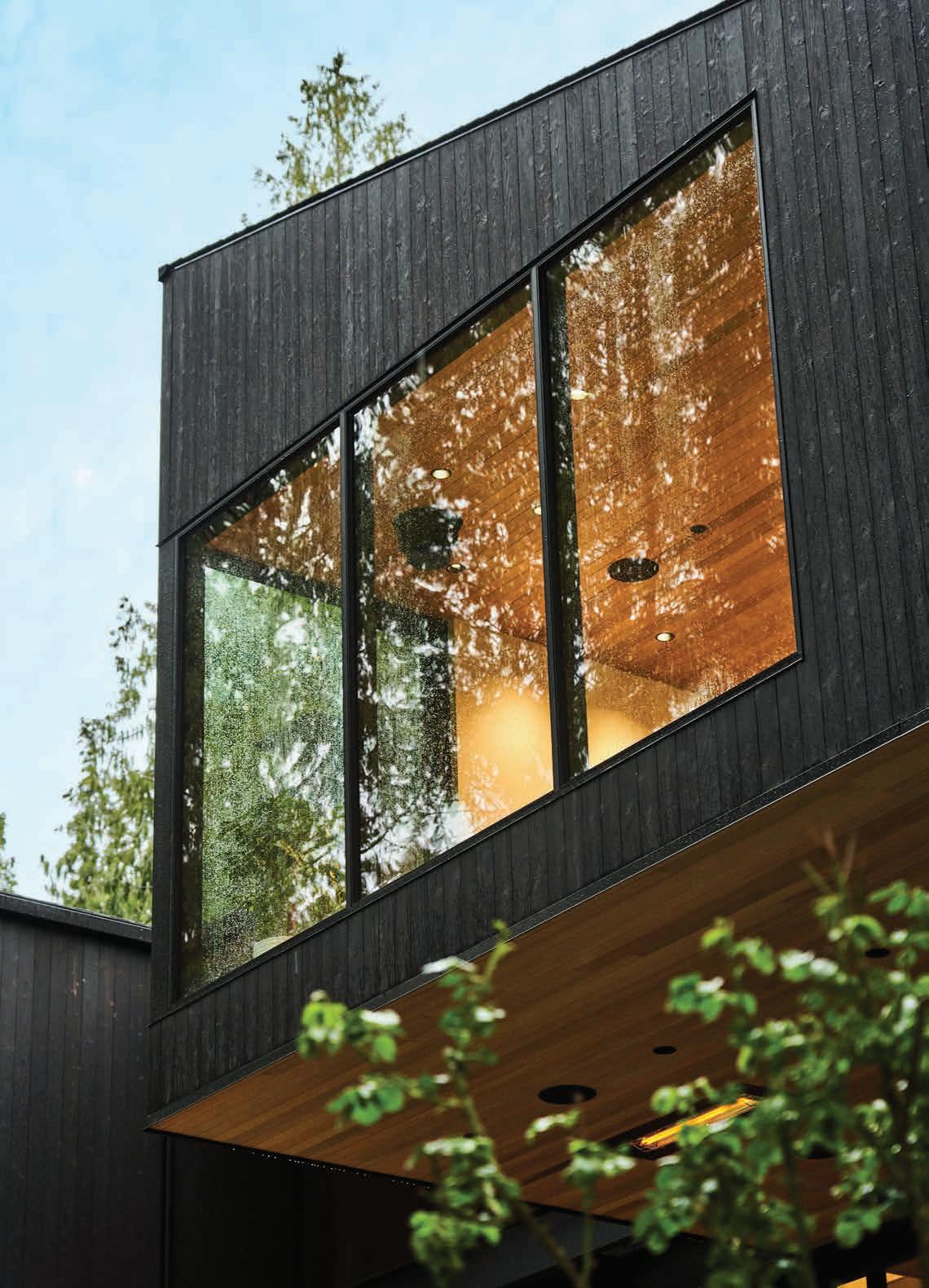
area below with outdoor access, all centered on a courtyard. Their goal was to create some transparency, so you could stand at the front of the lot and look through the home to see the water. They wanted space for native plants and rustic pathways, and a vegetable garden for Siobhán, who recently received a master gardener’s certificate. The lush, green rural surroundings reminded Michael of his native Denmark and his family’s quiet lake house in Sweden, and Siobhán of her childhood in Canada.
“We didn’t remove a lot of trees. We just limbed existing trees so we have privacy upstairs and never feel too exposed to the lake, but unobstructed views from the first floor,” Siobhán says. “We wanted windows to surround our bedroom, so you sit up in bed and you feel like you’re in nature. The house is sited 40 feet above the lake, so you feel like you’re hovering above it. It has a very calming effect.”
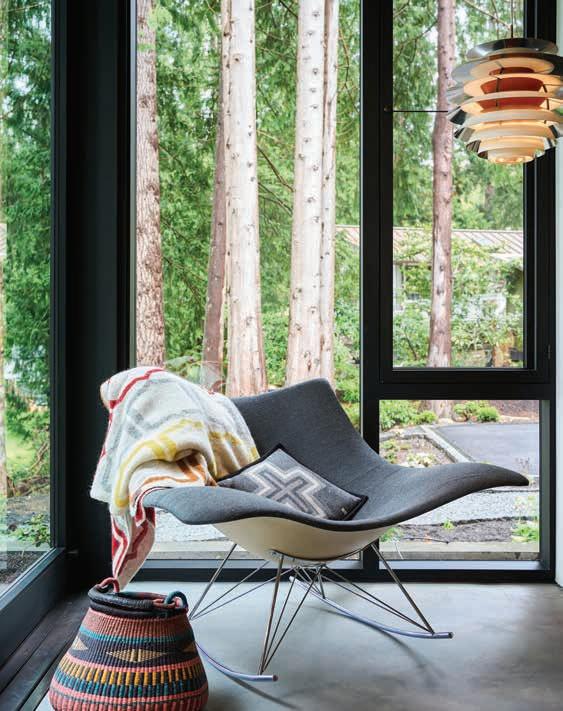
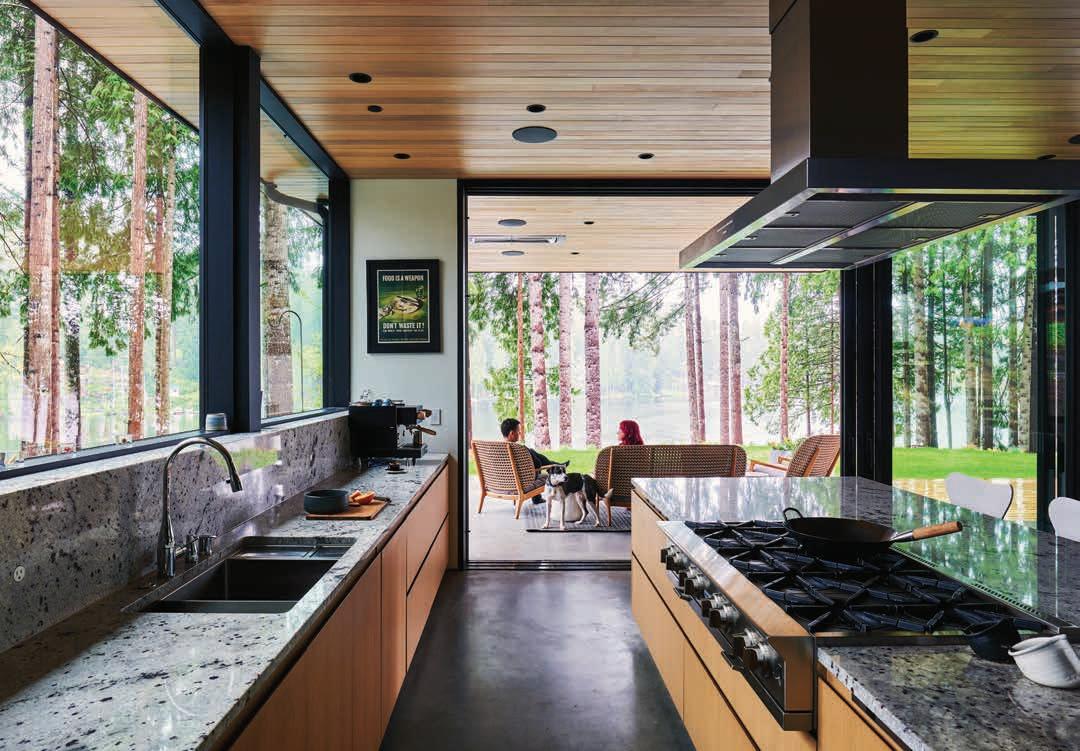
The Perssons refurbished the two existing docks and hired engineers to develop an intricate septic and filtration system to catch any contamination before it seeps into the lake. Protecting the beavers that are busy at work below the house, the nesting bald eagles, and the bobcats that make occasional appearances was a top priority.
“We tried not to take shortcuts, and find a smart,
E Kitchen countertops in a unique “Nordic Winter” granite create a little drama in the sleek kitchen.Because the house sits well above the shoreline, the Perssons maintain their privacy—despite the floor-to-ceiling windows. The open staircase at the center of the home does not obstruct the sightline from the front of the home to the lake.
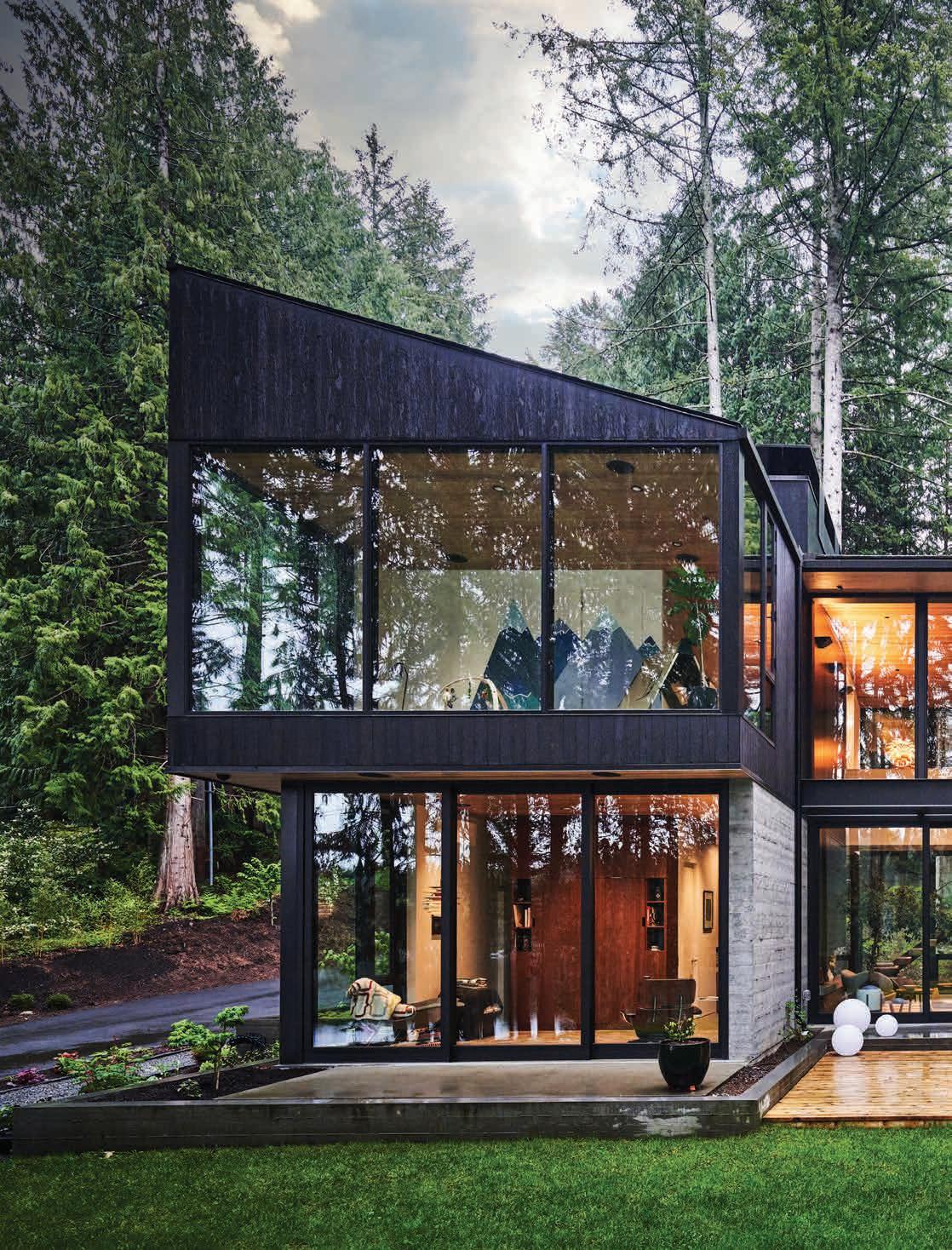
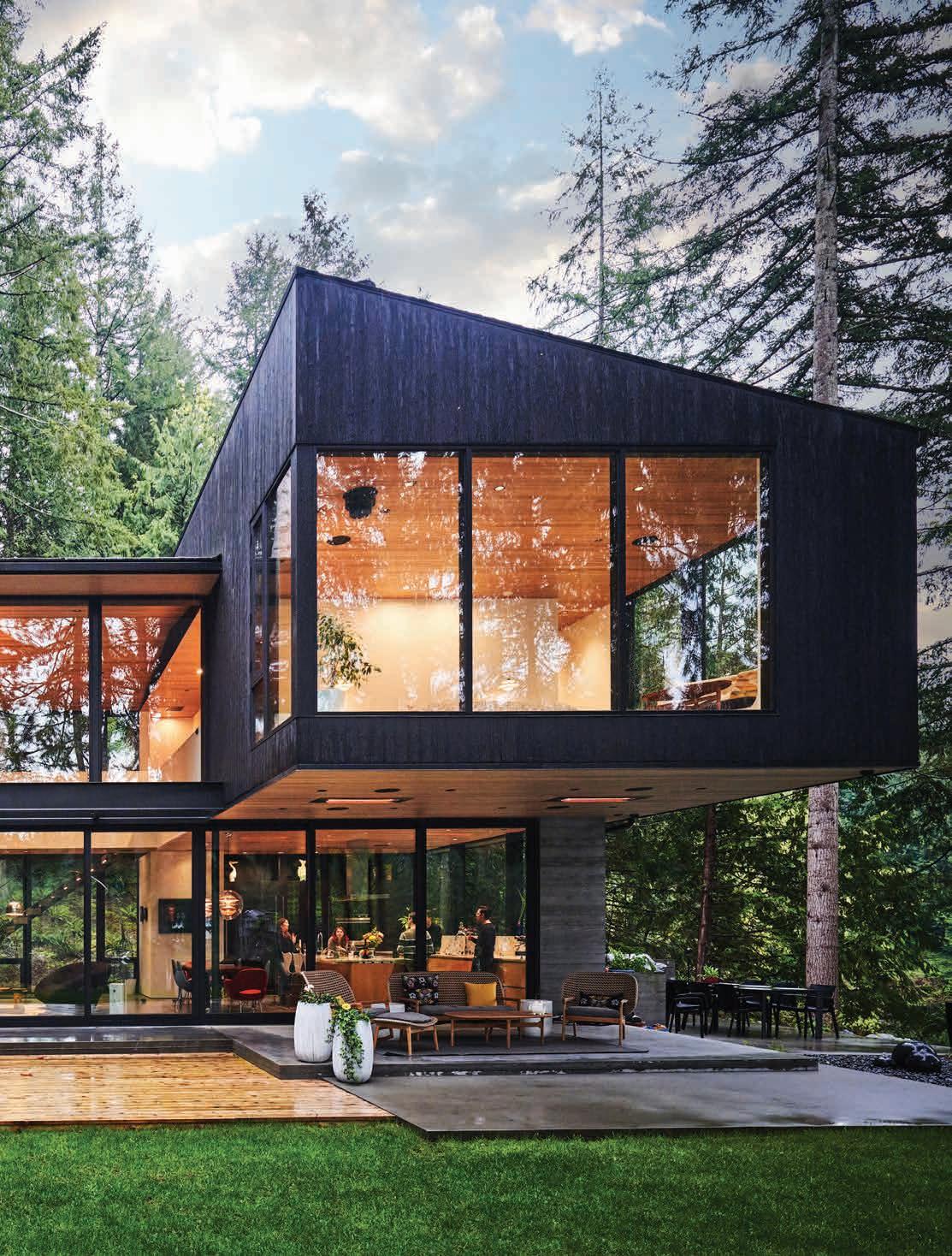

technically savvy way to do it,” Michael says. “The civil engineering aspect was fascinating. It was a real lesson on how to build something.”
If the Minecraft model was a guide for the structure, the couple’s impressive collection of authentic Danish modern furniture and light fixtures determined the interiors, which was all purchased straight from the source. The couple traveled to Denmark and scoured the less populated areas of the country to find rare items, and custom-ordered the newer pieces straight from the source.
“I grew up in a stuffy-feeling British household, so when Michael introduced me to Danish modern design, I fell in love,” says Siobhán.

There are Verner Panton globes over the dining table, and an authentic copper artichoke pendant from 1971 above the staircase.
The interior finishes are all natural materials, from a “monolithic wall” of blackened steel around the fireplace, to poured form concrete, lightly finished wood, and counter tops made of granite aptly named “Nordic Winter.” The floating staircase, which has 200-pound concrete treads that are designed to float on one side near a glass wall, was an “engineering marvel” says Stephenson, who credits Nickerson Engineering for making his drawing come to life. The custom 10-foot black walnut dining table, which is on casters so they can move it outside in the summer, was a gift from their builder.
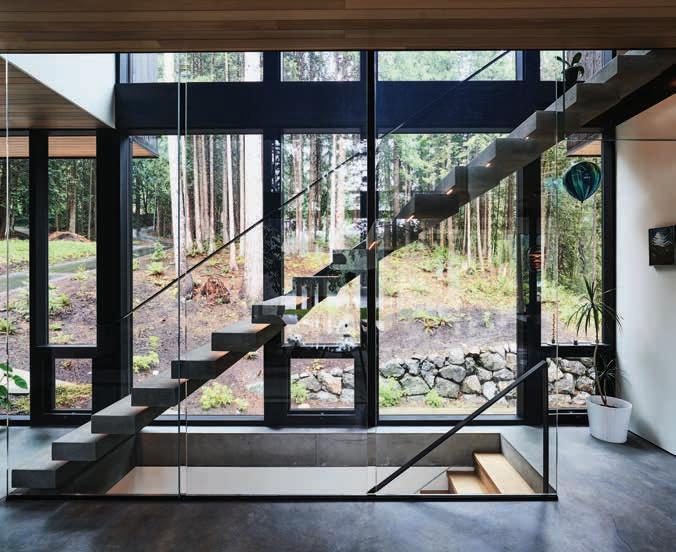
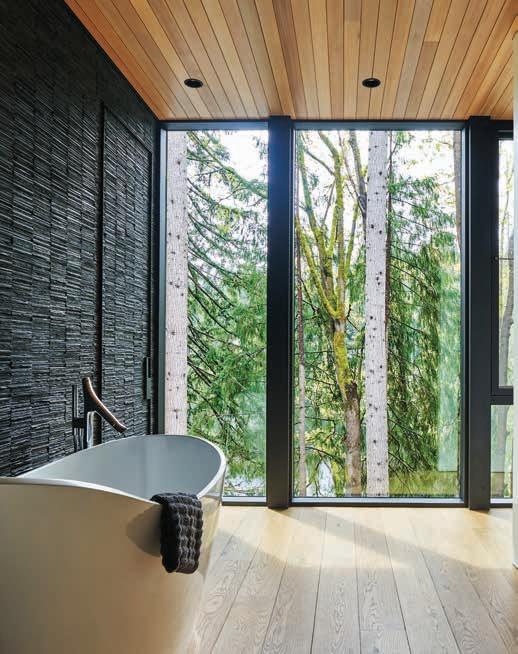
To Stephenson’s credit, he appreciated the level of detail and input the Perssons brought to the project. “Instead of coming in with broad, vague ideas, they knew that they had very specific things that they wanted for the house, inside and out,” he says. “Sometimes you create a great space and you hope that it’s well used. In this case, we knew the space would be used beautifully.”
And though Michael has moved on from Minecraft, his hope is that the game has helped spawn a new generation of architects.
“To be able to imagine those elaborate worlds, and develop that awareness of spatial relationships, it’s really inspiring for kids,” he says, “and adults.”
A 1942 Sunset cover house is meticulously restored, recreating the romance of an early California ranch home, capturing the splendor of the Carmel Valley, and reclaiming some of the mid-century magic of life in the West.
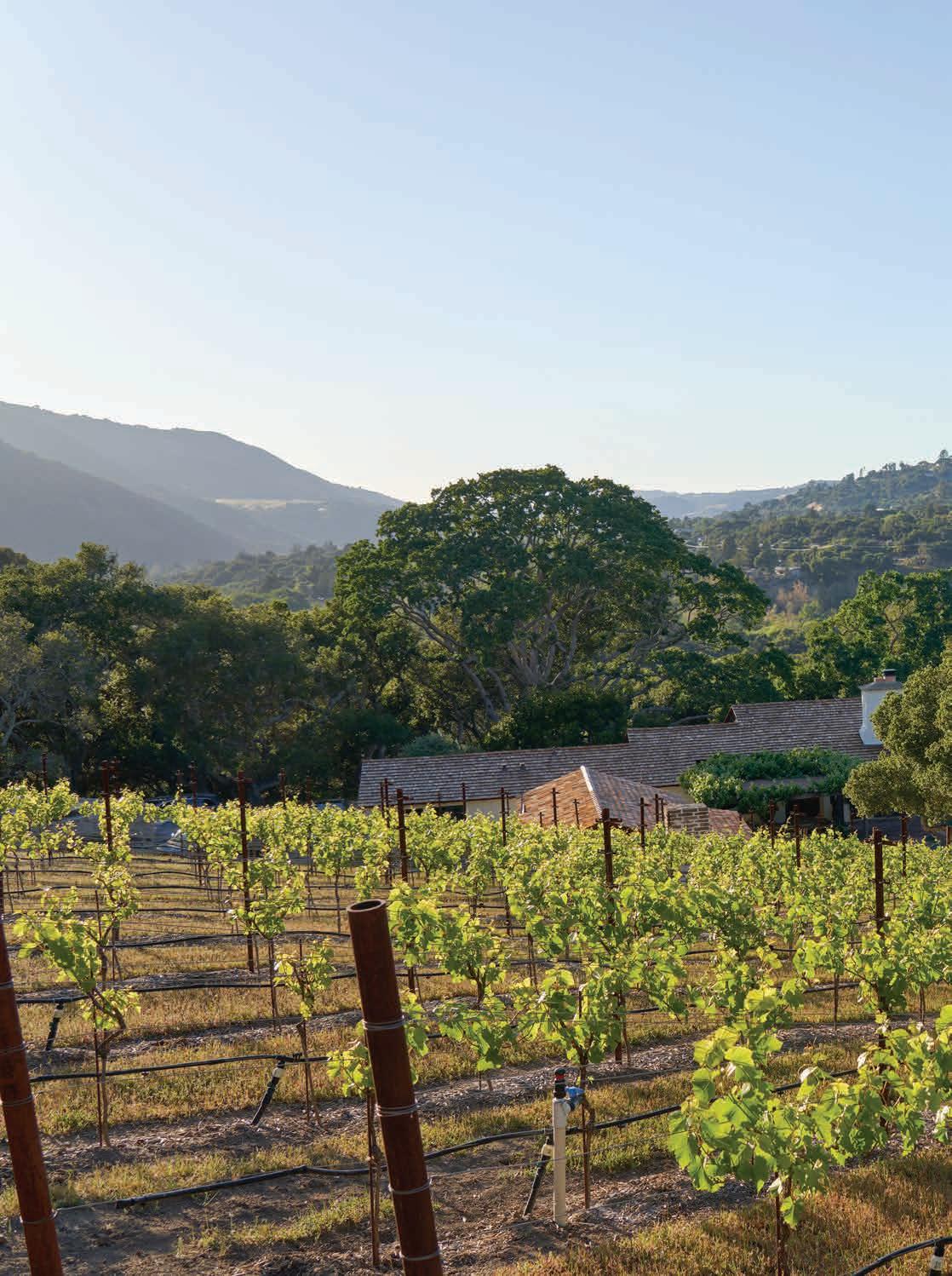 Story
CHRISTINE LENNON
by
Story
CHRISTINE LENNON
by
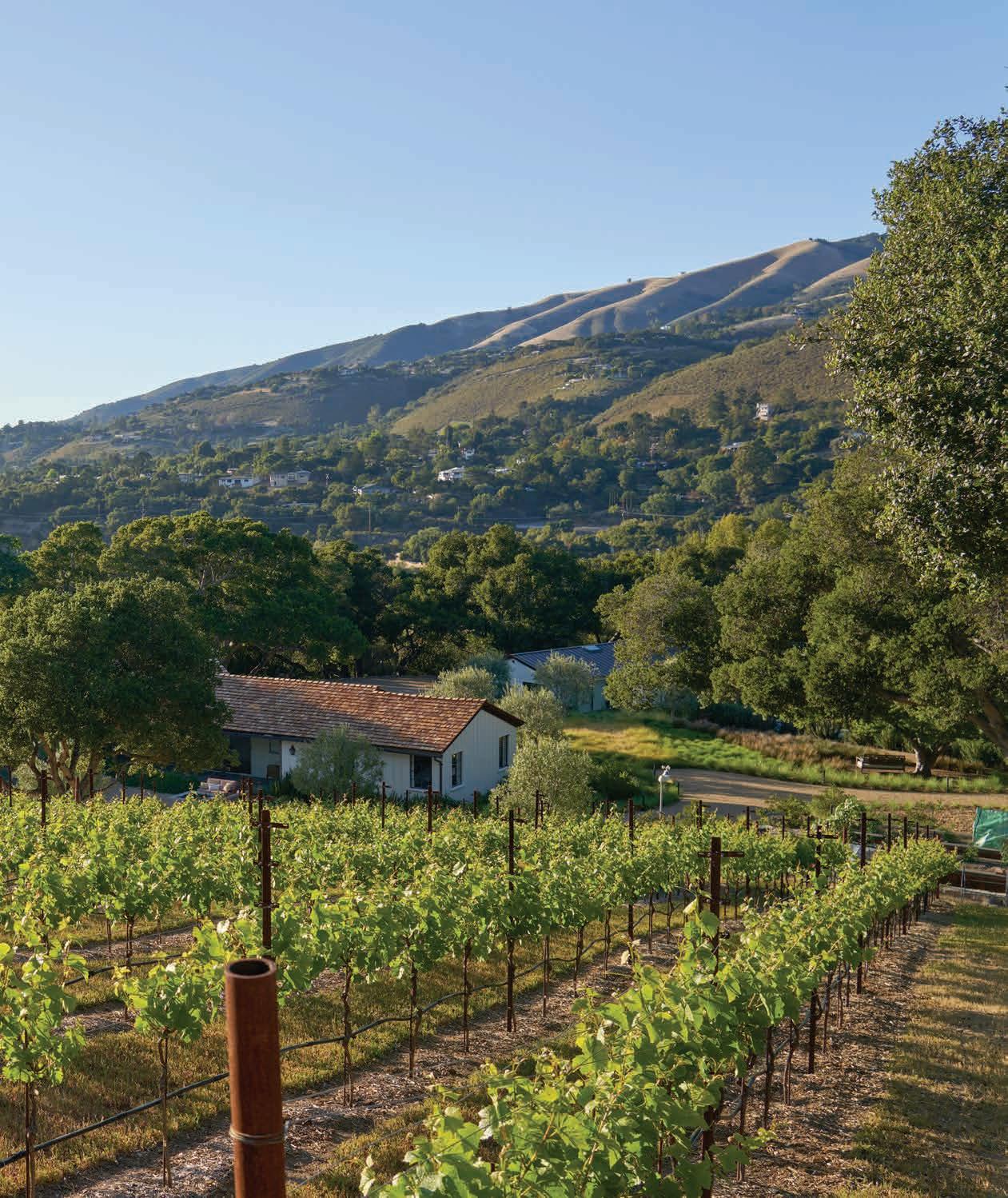
 Landscape designer Michael Bliss integrated new stone pathways into the landscaping and helped the new owners maintain the existing original details, like the courtyard and covered walkways.
Landscape designer Michael Bliss integrated new stone pathways into the landscaping and helped the new owners maintain the existing original details, like the courtyard and covered walkways.
Jeff Webster and Kimberly Clemenson began their search for a home in which to spend their retirement years enjoying the pleasant microclimate of the Carmel Valley, they knew their expectations were almost absurdly high. They wanted substantial acreage and charm, an opportunity to create a “gentleman’s farm” with an expansive vegetable garden and orchard, and to create the kind of welcoming retreat that their adult children couldn’t wait to visit. The biotechnology executives from Thousand Oaks were eagerly preparing for their next chapter, when they could suit up in their garden gear and get to work, planting grapevines and fruit trees and enjoying the sunny days, cool nights, and majestic coastline the region is known for.
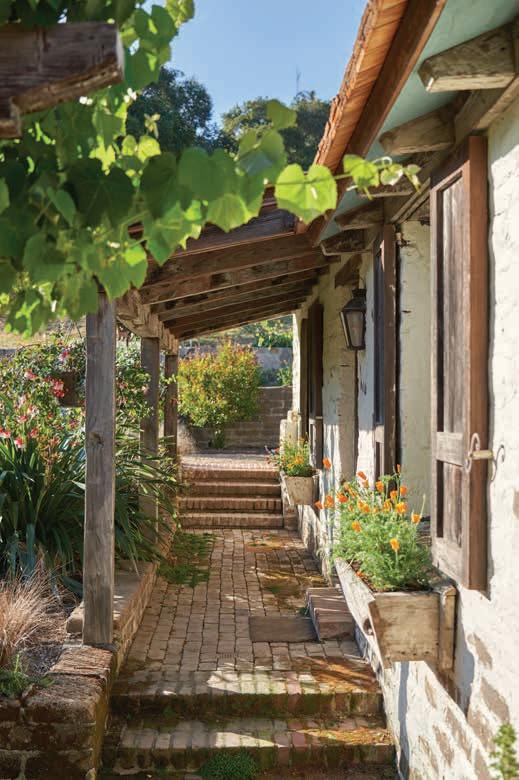
“I was born here in Carmel, and I have family here,” Webster says. “And we’d had a home in Pacific Grove for years. We always knew that this is where we would land.”
“It just took us a few years of searching to find the perfect spot,” Clemenson says.
The day they set foot in the house you see in these photos, which was wildly overgrown and crumbling from over 40 years of neglect, it required some creative thinking to come to the conclusion that this was the lucky break they were waiting for. The house, which sat on a nine-acre parcel, was designed and built by Hugh Comstock in 1939. Comstock (1893–1950) created the “fairytale” architectural vernacular of nearby Carmel, building quaint cottages that combined redwood timber framing and adobe styles. When Webster and Clemenson squinted a little, they could see their dreamhouse, with a sparkling pool surrounded by lavender and oaks.
“Parts of it were falling down after four decades of essentially no maintenance, with outdated knob and tube electricity and all original fixtures. There’s original-great and originalnot-so-great, and we were faced with a lot of both,” says Webster. “It was a dilemma,” says Clemenson. “We knew it would take years to restore it, at great expense. Ultimately we decided it was too unique to pass up.”
They purchased the home from a man who’d lived there since 1976 and allowed him to stay in residence for a
year while they took stock of what was on the property, consulted with architects and landscape designers, and planned the restoration. During that time, they peeled back layers of history of the property and learned that they’d acquired so much more than a house. It was a slice of California history, a former Sunset cover star that was once home to the boy who inspired one of America’s most beloved cartoon characters. And it was the beginning of the most creatively satisfying phase of their lives.
Back in December of 1942, the Sunset editorial team was tasked with the nearly impossible job of putting together a lifestyle magazine that celebrated home, garden, and entertaining in the West—in the middle of World War II. Faced with austerity measures and the uncertain fate of thousands of troops, they needed to connect with their readers in a meaningful way by showing them a version of the American Dream that was worth fighting and sacrificing for, and encourage them to invest in war bonds, at least in part as a way to develop innovative building materials for the homes of the future.
This Carmel Valley home was what they chose to feature on the cover, knowing it would tug on their audience’s collective heartstrings. It had been built for the Wolferman bakery family of Kansas City. Fred Wolferman had made a name for himself, and a small fortune, selling his famous English muffins. The vacation house he commissioned represented
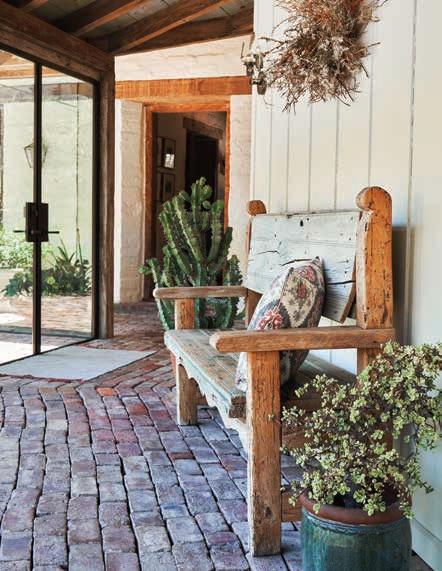
E Lush carex grass and ferns and ornamental trees line a new stone path that connects the driveway to the main house.

F Original redwood planks from 1942 were reused wherever possible, maintaining the integrity of the materials and blending the old with the new.
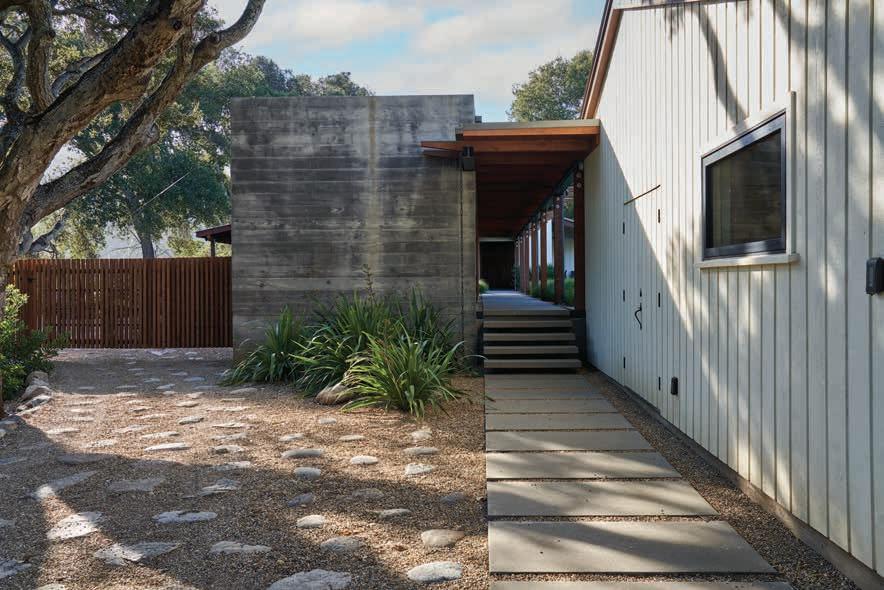

the best of California, and a glimpse of the future.
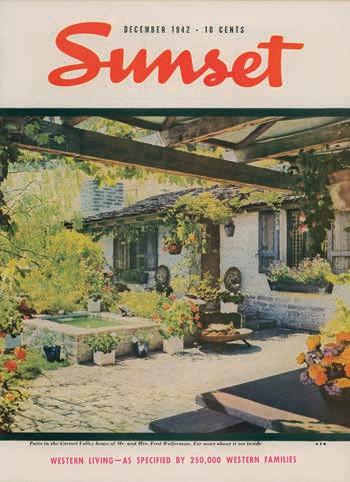
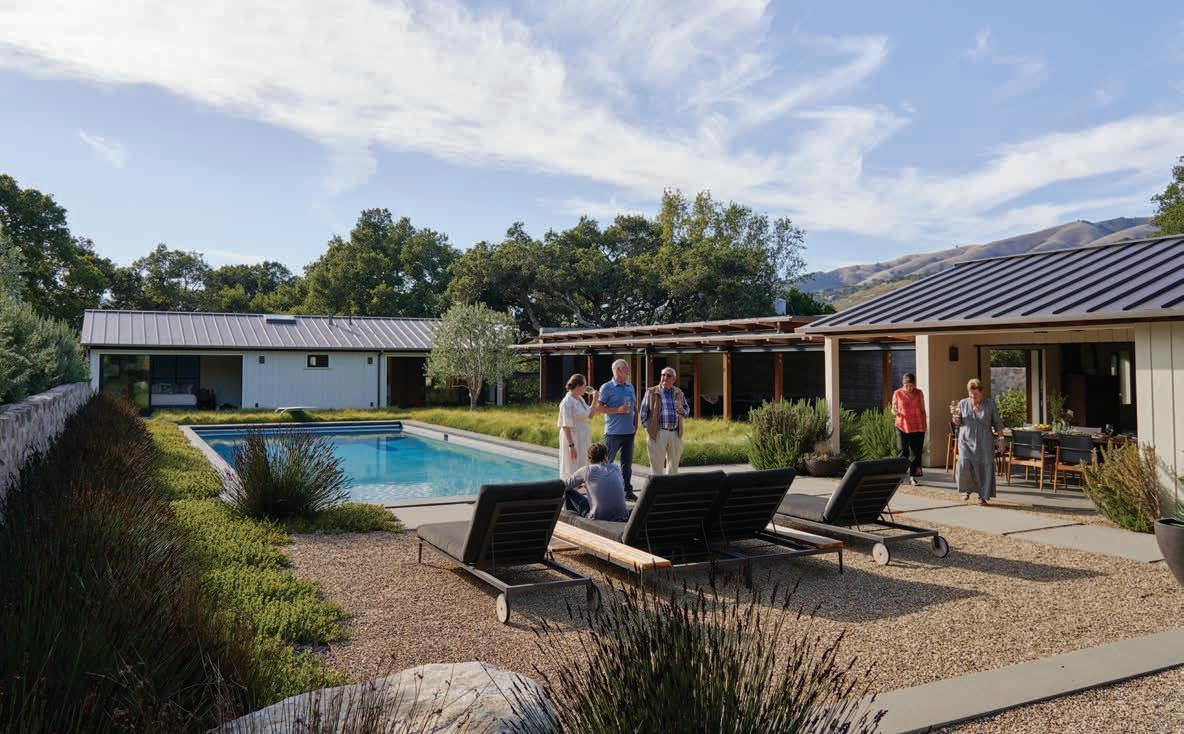
“This West of ours has always been a glorious promise,” the Sunset editors wrote in the story that accompanied the black and white photos of the home. “Always it has been the land of great abundance, fragrant with ripening fruit, splashed green and gold with limitless forests, grasses, and grains. And always it has been that exciting mystery—the very edge of America, an entrance to the Seven Seas… More and more we are learning how to build this West of ours into our homes. Our homes—they are the flags of America. They are the symbols of the kind of living we are fighting for.”
The house opened up to the great outdoors, and the bedrooms were accessed by exterior walkways. The main house was framed in local redwood to support the adobe block construction, which was all formed on the property. Comstock had started developing this building method in the late 1930s knowing that war was coming, traditional materials would
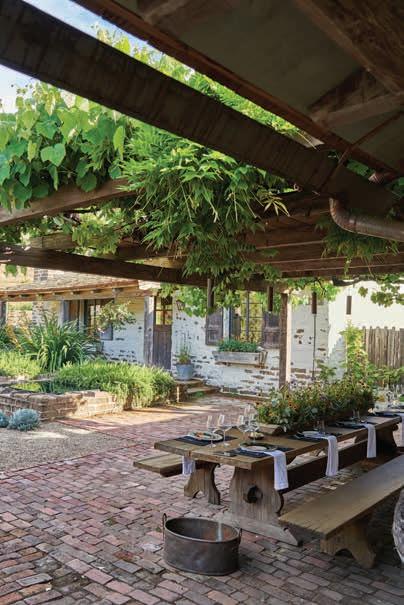 The Clemenson-Webster family enjoys a sunny day poolside, outside the farm kitchen. The diving board was originally installed in 1950.
Despite the decades of use and massive renovation, the patio that appeared on the cover remains unchanged.
The Clemenson-Webster family enjoys a sunny day poolside, outside the farm kitchen. The diving board was originally installed in 1950.
Despite the decades of use and massive renovation, the patio that appeared on the cover remains unchanged.

 Lounge chairs are perched in front of an old well outside the guesthouse.
Lounge chairs are perched in front of an old well outside the guesthouse.
The garden was designed to be enjoyed and lived in.
 An oak tree is at the heart of the family’s multigenerational dream house.
An oak tree is at the heart of the family’s multigenerational dream house.
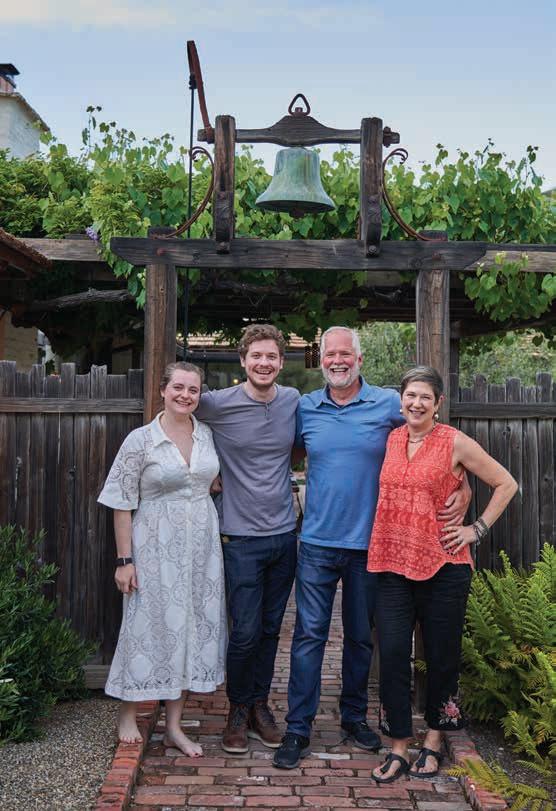

 Webster and Clemenson and their children, Bryce and Tias. Below, original redwood beams frame the living room.
Webster and Clemenson and their children, Bryce and Tias. Below, original redwood beams frame the living room.
be scarce, and he would need to rely on local resources. In the shady central courtyard, there was a three-bytwelve-foot dining table fashioned from a continuous slab of wood, a fountain, and a young grapevine. The surrounding property was studded with specimen oaks, and the design, according to the Sunset staff, celebrated the “nearness and kinship with the rich soil of abundance.” There was a trunk room to store the luggage the Wolferman family would haul halfway across the country when they made the long journey to California every year. The floors were made of locally

sourced brick. The outdoor pavers were Carmel stone.
In the 1950s, the Wolfermans sold the ranch house and its surrounding acreage of rolling golden hills to cartoonist Hank Ketcham, the creator of Dennis the Menace. When Ketcham’s son, Dennis, was 4, he completely wrecked his bedroom in the house during his scheduled naptime. His mother, Alice Ketcham, announced to Hank, “Your son is a menace.” Within three years, there were 30 million readers of the comic in 52 countries. Ketcham’s team of illustrators worked in the poolhouse, and were
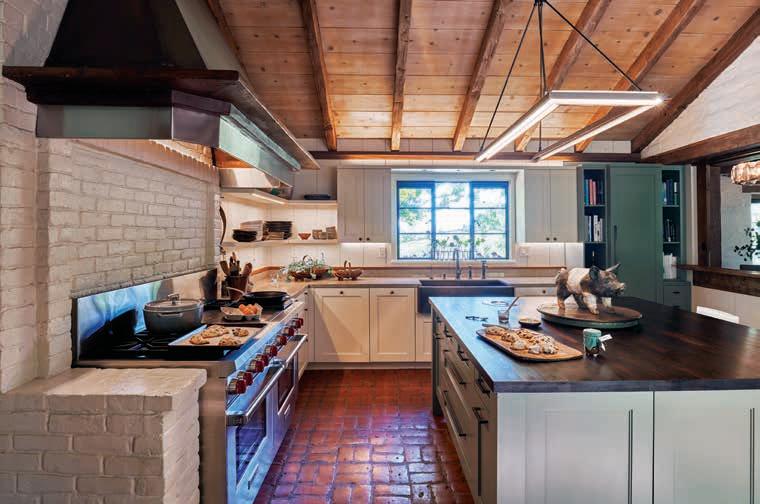
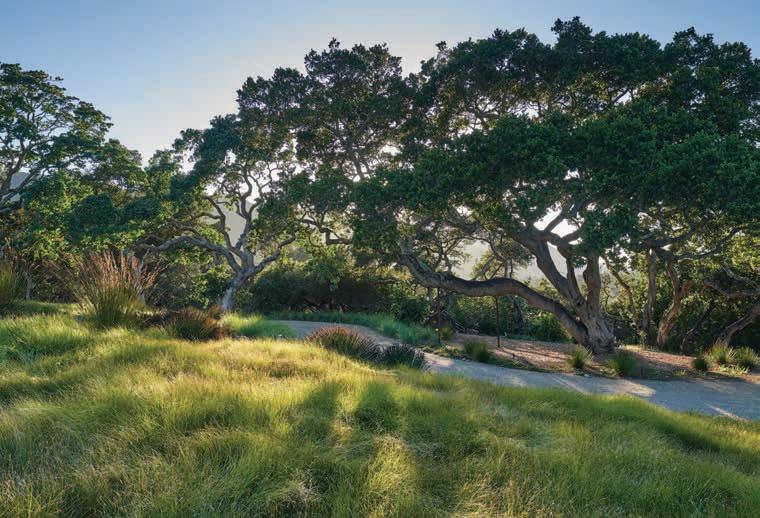 Covered walkways link the main house to the farm kitchen and an indoor/ outdoor entertaining space.
Covered walkways link the main house to the farm kitchen and an indoor/ outdoor entertaining space.
photographed perched on the diving board, which is still in use today.
By the time Clemenson and Webster purchased the house in 2015, very little of the property’s former glory was intact. The owner was nearing foreclosure, and the derelict conditions would have deterred less-committed new owners.
“We could see the bones of it were there,” Webster says. “And all of those original elements, from the windows to the hinges to the bathroom tile, were still intact. That was the amazing part. There were original redwood floors in the entry and the living room and the planks are probably two feet wide and eighteen feet long. You can’t find those anymore.”
Thus began a three-year process of scrubbing the grime off fixtures, doorknobs, hand-forged hardware, and brick floors. The primary bathroom was expanded, the trunk room
was converted to a pantry and mudroom, and the kitchen was modernized with new cabinetry, plus appliances from Miele, Subzero, and Wolf. Redwood paneling that had to be removed was reused wherever possible, like on the ceiling of the renovated pool house, which was added to the property in 1950. It now houses what they call the “farm kitchen,” where they do most of their entertaining in the summer and make jam and preserves after the harvest. They enclosed the walkways that connect the main house to the two-bedroom guesthouse, but the guesthouse itself was restored to its exact original condition.
“It just took a lot of tender loving care,” Webster says. “It helps that we worked with a contractor and craftspeople who cared, too.”
That young grapevine in the courtyard is now a foot thick, and last year it produced 400 pounds of grapes, which they use to make jelly for their Comstock Farm & Kitchen, a fledgling nonprofit gifting business benefitting at-risk youth that Clemenson plans to grow once she is fully retired. The twelve-foot table is still in regular use.
On the property, Webster and Clemenson planted what they refer to as the “Noah’s Ark” of fruit orchards, with two trees of any variety that will thrive here, from apricots to avocados, and 700 Pinot Noir vines. The landscape and
hardscape were conceived by Michael Bliss, with plenty of meandering pathways to wander and enjoy the beautiful surroundings. The couple moved in 2018, built a new garage in 2019, and finished the entire project in 2020—five years after the journey began.
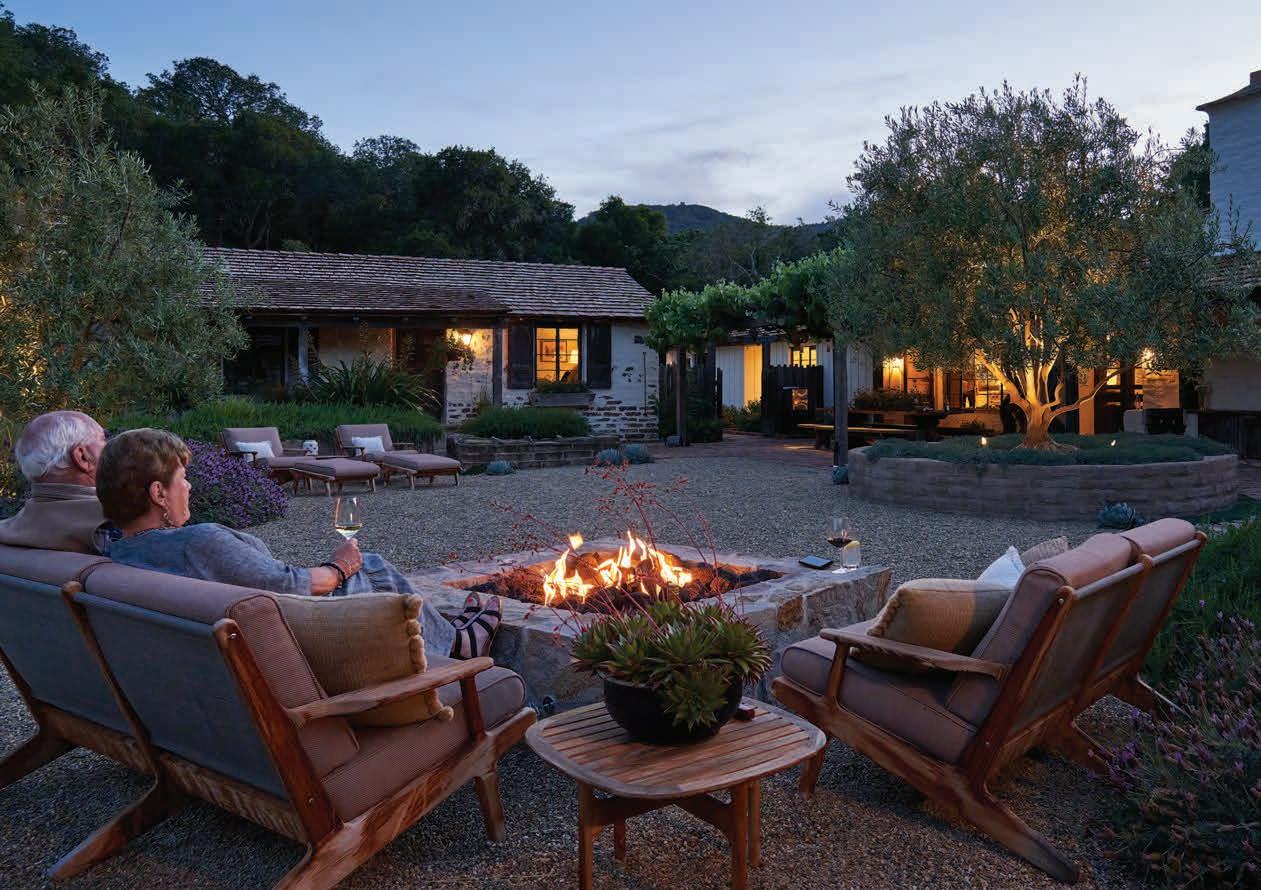
“Ever since we began the restoration in 2015, we’ve thought of how cool it would be to have the house in Sunset a second time,” says Webster. And here we are, 80 years later, celebrating a timeless house that feels tailor-made for how people want to live today, in touch with its beautiful surroundings, built from natural materials with integrity and simplicity, and designed to be enjoyed with family and friends.
“It is a spectacularly beautiful and unique place,” Webster adds. “I can’t believe I get to wake up here every day.”
E
Nearly eight years after they acquired the neglected property, the homeowners can sit back and enjoy the fruits of the (very hard) labor.
F
The nine-acre parcel is landscaped to showcase the natural surroundings, but also features creature comforts like a large pool and stone walls delineating outdoor living spaces.
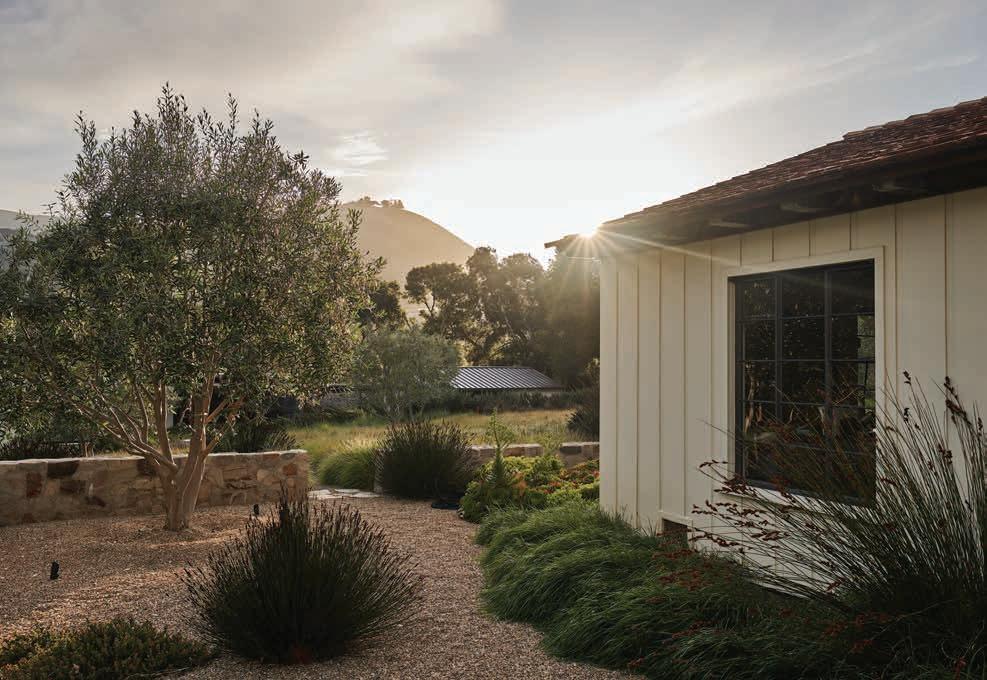

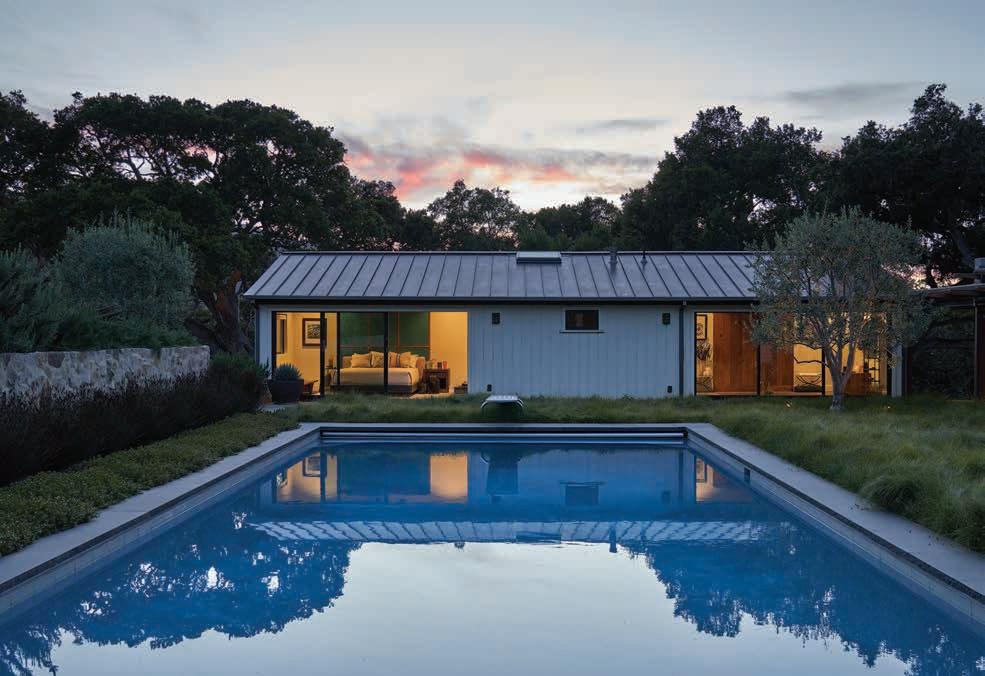
THE OWNER OF FLORA GRUBB GARDENS IN SAN FRANCISCO AND LOS ANGELES TAKES US ON A TOUR OF HER LOW-WATER BUT LUSH PRIVATE GARDEN.
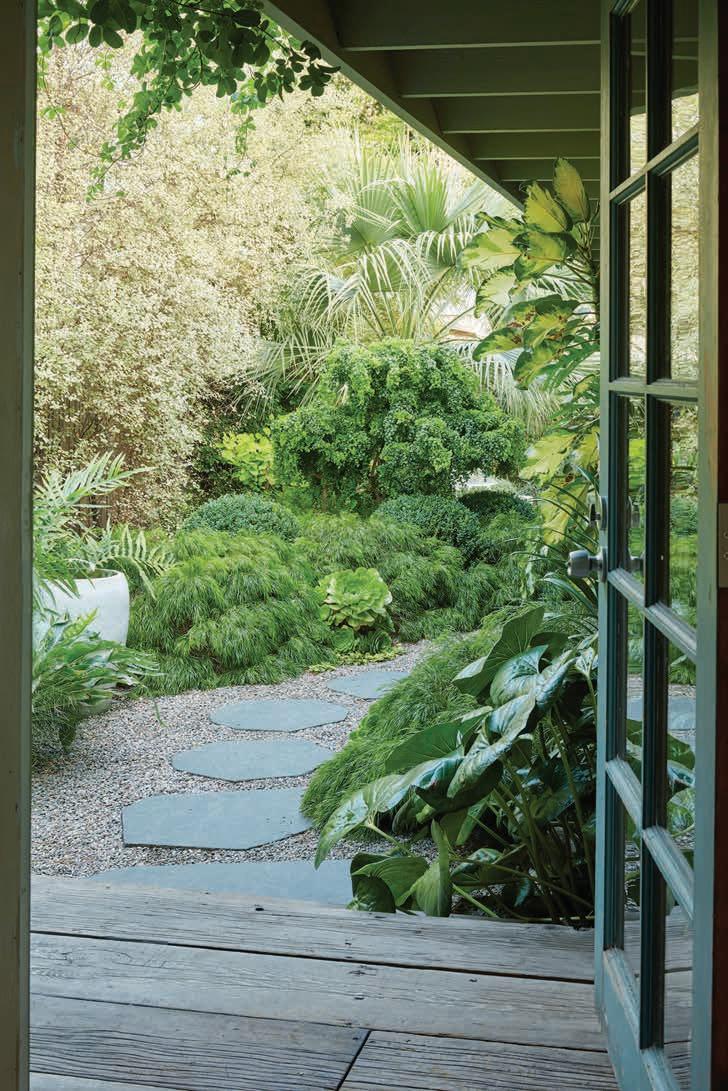 Story by DEANNA KIZIS
Story by DEANNA KIZIS
F The first problem Flora Grubb decided to attack was that the garden offered zero privacy. “The house has a giant picture window that looked straight out onto the sidewalk,” she says. Her solution was to create what she calls a “zone of privacy.” She planted a silvery Acacia cognata ‘Cousin Itt’ tree that now partially blocks the window from the street. The second layer is a Brahea clara palm, which grew in so well she thinks of it as an architectural feature. Now when you look out the picture window toward the street, you get a view of happy trees instead of people walking by.

you don’t know Flora Grubb, she’s the co-owner of a revered garden center in San Francisco, Flora Grubb Gardens, along with her own breathtaking wholesale nursery about 50 miles outside of San Diego, as well as a brand new nursery on the west side of Los Angeles. She’s also a talented landscape designer,
so when she offered to show us her home garden in Oakland, we were thrilled. We love that it’s done in the increasingly popular style of tones of green—as in, no showy flowers anywhere. And this garden—as unbelievable as it may sound for so much greenery— is all low-water plants. It seems impossible, right? Here Grubb shares the steps she took to create a garden of her own.
F Those gray stones are actually basalt, which can be harder to come by. One can, however, re-create the look by using pearl gray flagstone to make a path. To create hers, first Grubb leveled the area, then set the stones in pea gravel. The good news? “That’s the cheapest gravel you can get at any yard,” Grubb says. “It’s not fancy pea gravel. If you go to the rock yard and say, ‘I’ll take pea gravel,’ that’s what you’ll get. I find its basic gray and small size to be every-
thing you need gravel to be.”
She also made the path wider than people usually do, which makes it more welcoming. If the plants start getting too big, she’s not afraid to grab a tire iron and drag her basalt stones around until they look right again. (“These are DIY garden lady things,” she says.)

It’s also important to note that the path winds a bit. It’s not a straight shot to the house or to the garden but takes on a more naturalistic, undulating shape.

F “For me to get something that’s this well-composed involves putting the plants where I think they’re going to go, then running inside to look at it from there, and then looking at it from the garden chair, et cetera. I just really try to make sure that I’ve got all the proportions and everything just right,” Grubb says.
She jokes that maybe if she were a better designer she could just draw a picture, but for her, it’s better to move plants around the way you might move your furniture while rearranging a room in your house until it’s perfect.
Is this a risk? Yes, Grubb says, because one needs to buy a lot of plants at once, and it’s difficult to make that commitment. One way to lessen the blow, she says, is to literally drag plants around at the nursery to see how they look together. “I play around with different plant combinations at the nursery for a while before I commit,” she says. You can also ask for help. “In the garden center, figuring out which plants look beautiful together is just part of what we do.”
F One of the things Grubb is most committed to, both at her garden center and her nursery, is finding plants that have the impact of a jungle species but are low-water instead. “When you are in a drought and everything gets drier, green plants feel so refreshing,” says Grubb.
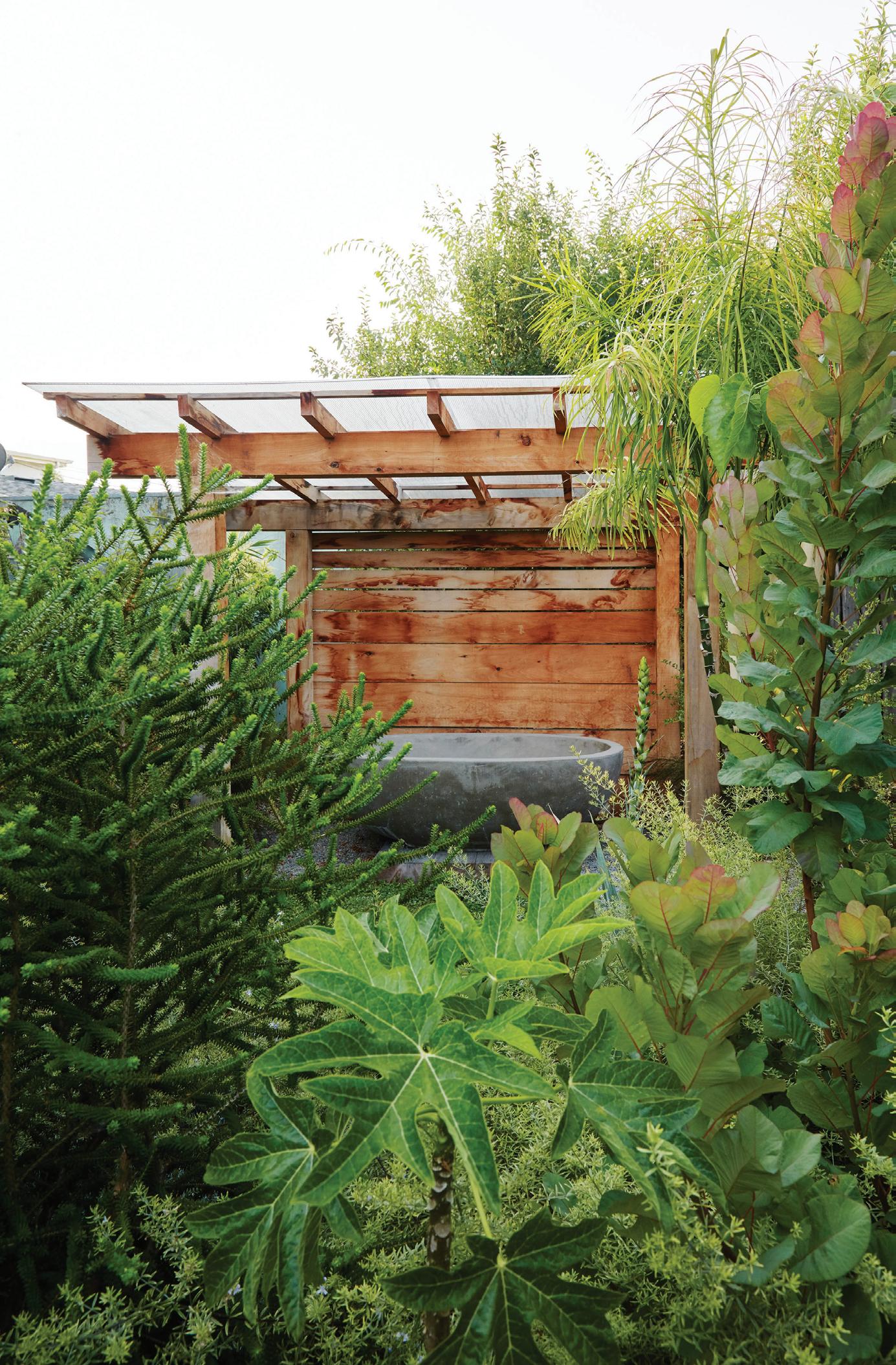
To stay drought-friendly, she got rid of the lawn and replaced
it with gravel. “Tip No. 1 for lowwater gardens is that we can’t afford to use lawns as negative space,” she says. “So, once you remove the lawn, you won’t miss green if you make sure the plants you replace it with are green.”
Meanwhile, the plants she used are evergreens, which means they keep their color year-round. “I’m always looking for truly unthirsty, evergreen
plants that are green,” she says. “While I love silver agaves, succulents, and cactuses, I want some real green in the garden.”
As a parting thought, Grubb issues a warning: Don’t try to create a garden like this if you want to be able to ramble about the space willy-nilly. “This is the garden for a true control freak,” she says. “There’s no room for half a dozen teenagers or a dog.”
Flora Grubb Gardens in San Francisco is known for its good looks, array of climateappropriate plants, and tasteful selection of garden accoutrements.
Later this year, Los Angeles will get its own Grubb-owned garden center in Marina del Rey, and it promises to be huge—literally. “The LA store is two acres!” exclaims Grubb, adding that she’ll be carrying more of everything, including an expanded collection of rarities that will thrive in Southern California. In other words, for Grubb fans, now there’s even more to love. Floragrubb. com.
F On a fundamental level, to layer green on green, you need to consider which greens match, which contrast, and how the textures work together. As with plant placement, this is all about trial and error. “Sometimes I see something in my head and think, Oh, that’s going to look great, then I put it together and see that it doesn’t,” Grubb says.
Her garden works because there’s a lot of contrast in complementary shades of green. One of the worst things you can do, she says, is place two shades of green together that almost match but don’t. It’s the same with texture: If one plant’s texture too closely resembles another, your eye won’t be able to decipher the two.
“My garden works with various shades of green all the way from chartreuse to dark green, along with some silvers which are shades of green as well,” she says. The bright grass-green ‘Cousin Itt’ shrubs work as a ground cover (and look like the character from The Addams Family) while tying the garden together.
If you’re not an experienced designer, and you want to try to create a garden that has a lot of textures and greens, Grubb suggests you print pictures of other people’s gardens (including this one) and take them to the nursery and ask, “What are these plants?”

(To get you started, some of the plants Grubb used are Buxus sempervirens, Ceanothus ‘Diamond Heights’, Leucophyta brownii, Phlebodium aureum ‘Blue Star’, and Pittosporum ‘Silver Sheen’.)
Meanwhile, if you start with a lot of plants but then decide to add more, she suggests taking a cutting, bringing it to the nursery, and finding the best contrasting green or texture that way.

F A garden isn’t simply a thing to be looked at or strolled through, but a mini universe to be lingered in. Grubb created multiple outdoor “rooms,” each with a distinct view of the garden. In addition to a bathing pavilion with an outdoor soaking tub, there’s a covered bench for napping or reading, a lounge with that affords a Zen view of the plantings, and movable wire seating that can be rearranged on the gravel to follow the sun or keep you tucked away underneath the boughs of the trees.
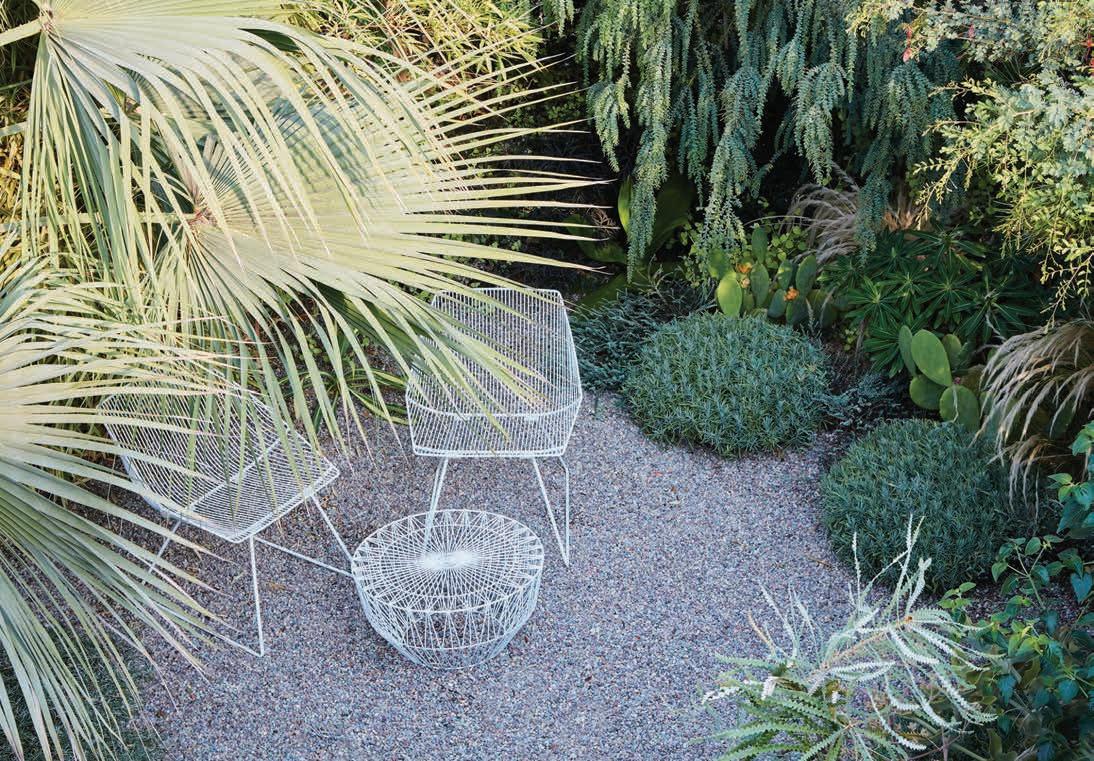
















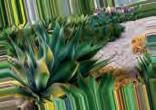




Elevate your everyday cooking with these easy, healthy plant-based favorites from Vietnamese cooking expert Andrea Nguyen’s new cookbook, Ever-Green Vietnamese.
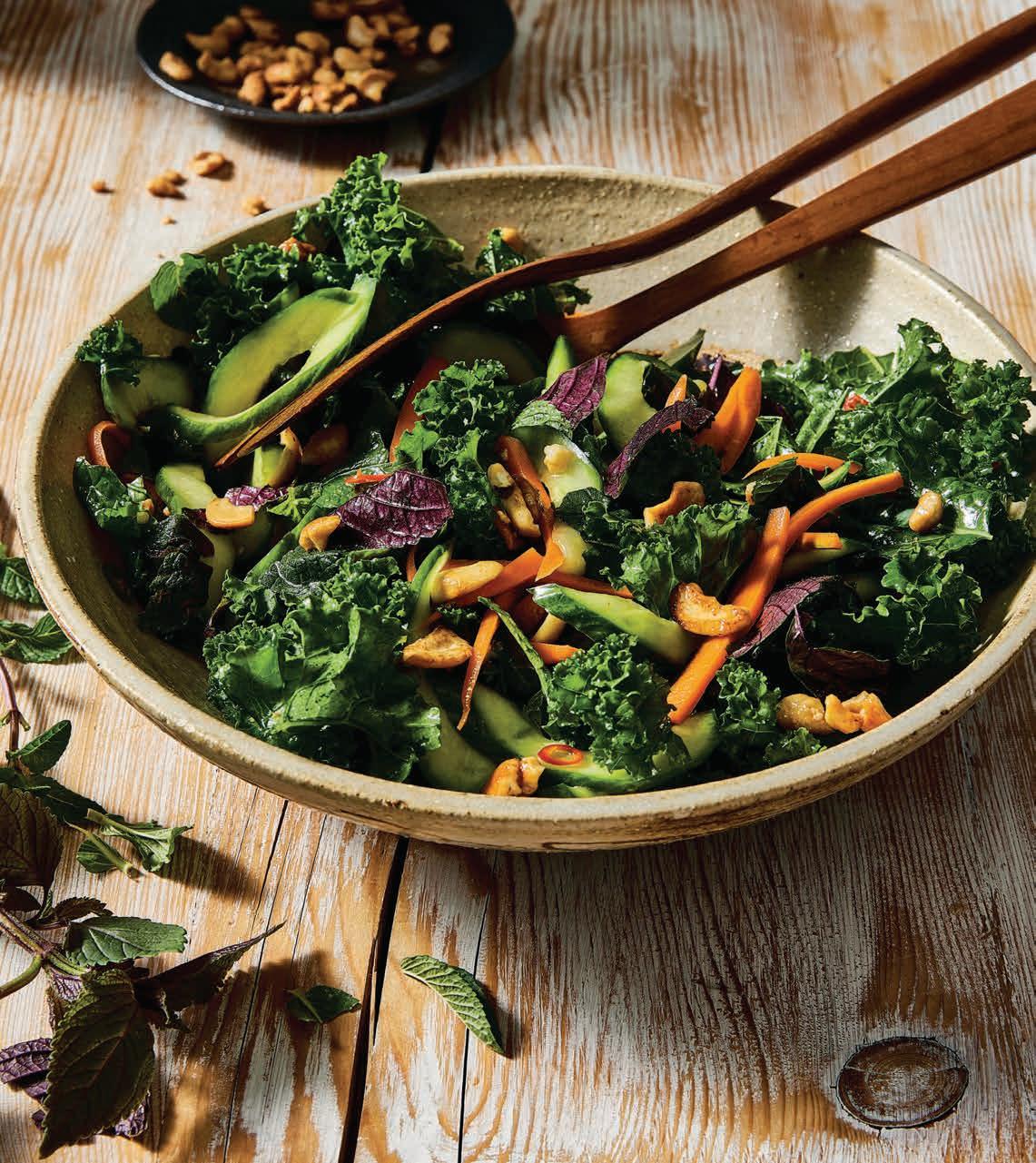 Photographs by AUBRIE PICK
Photographs by AUBRIE PICK
or decades, author Andrea Nguyen has championed unbridled Vietnamese deliciousness. Her seven cookbooks anchor the Vietnamese-American and pan-Asian culinary canon and are filled with recipes for dishes such as lemongrass pork chops, Vietnamese shaking beef, Chinese chiu chow dumplings, and hundreds of other preparations where flavor comes first. That’s a lot of recipes, a lot of recipe-testing—and a lot of eating. Such are the occupational hazards of being a prolific cookbook author. “You taste as you cook, when the dish is done, when it’s in leftover form,” says Nguyen. “And then you taste it to see how it is after being frozen.” In 2019 a health scare led Nguyen to an honest assessment of her diet, and a resolution to eat less meat and many more vegetables. The result is the excellent Ever-Green Vietnamese: Super-fresh Recipes, Starring Plants From Land and Sea, loaded with dishes on par with Nguyen’s previous efforts but with, well, less meat and many more vegetables.
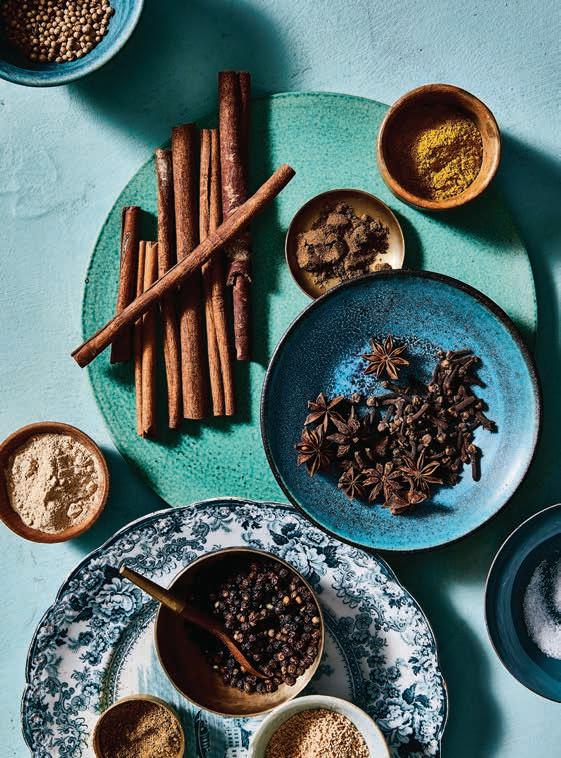
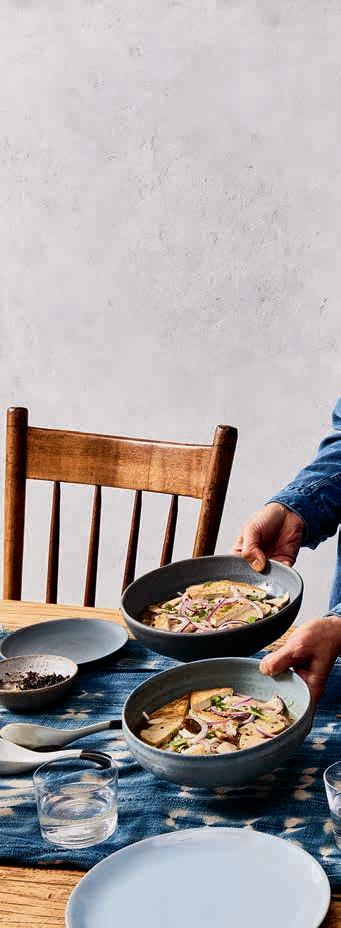
As in her other cookbooks, Nguyen plays the consummate teacher, front-loading the book with the essential pantry staples, shopping lists, and fundamentals written in an exacting yet accessible way that transform instructions into intuition (for example, the difference between “rippling and shimmering oil” and the benefits of each). You’ll find Vietnamese favorites like bánh mì, rice rolls, and stir-fries that are either vegetarian, composed nearly entirely of produce, or

While the health benefits of a plant-based diet are undeniable, cooking and eating should be grounded in joy and celebration and above all deliciousness.
with animal protein playing a supporting role: Thus shaking beef becomes shaking salmon, with a hefty dose of greens and herbs; spicy mushroom and cabbage slaw is an entirely meat-free, umami-packed alternative to Viet chicken salad.
While the health benefits of a plant-based diet are undeniable, Nguyen is quick to point out that this book is not just for health and that cooking and eating should be grounded in joy and celebration and above all deliciousness. “Vegetables are the source of so much creativity in the kitchen,” she says. “Meat you can manipulate in only so many beautiful ways, but the sheer variety of vegetables is infinitely inspiring.” Here we share three dishes from the book to inspire you, too.
Crisp g i du a leo is a classic Viet salad often served as an appetizer with fried shrimp chips for scooping. To lighten the knife workload on weeknights and turn it into a side salad to accompany other dishes, I add kale for texture and a bunch of fresh herbs for punchy notes. Make sure the kale plays well with the other veggies and tastes good when raw by selecting curly kale with frilly, tender leaves resembling a swirly skirt, not a stiff scratchy tutu. A generous amount of spicy-sweet candied nuts stands in for the meat that’s typically found in this salad. In Vietnamese, cucumbers go by two charming names, du,a leo (“climbing squash” in southern Vietnam) and du,a chuôt (“mouse squash” in northern Vietnam), so this salad may also be called g i du a chuôt. Around my house, we regularly have this salad and call it the 3C g i (cucumber + carrots + cashews).
SERVES 4
1½ Tbsp. plus ¾ tsp. granulated sugar
3 Tbsp. fresh lime juice, plus more as needed
2 Tbsp. fish sauce
1 Tbsp. plus 1 tsp. neutral oil (such as canola or peanut)
1 tsp. chile-garlic sauce or 1 Thai chile, thinly sliced
2 3 cup raw cashew halves and pieces (see Note)
1½ Tbsp. pure maple syrup (see Note)
1 8 tsp cayenne pepper or freshly ground black pepper
Fine sea salt
1 large English cucumber, or 1 lb. Japanese or Chinese cucumbers
1 small carrot
3 to 4 cups hand-torn curly kale leaves (see Note; aim for bite-size pieces when tearing from the stems)
1 cup hand-torn mix of tender herbs (such as mint, shiso, and any kind of basil)
In a small bowl, whisk together the 1½ Tbsp. sugar, lime juice, fish sauce, 1 Tbsp. neutral oil, and chile-garlic sauce to combine well. Knowing that the candied cashews will bring extra
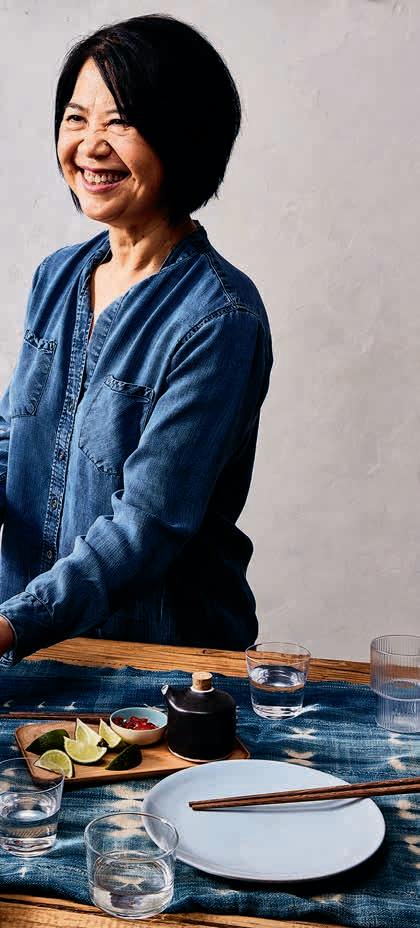
sweetness later, taste and add lime juice ½ tsp. at a time for a tangy finish. Set this dressing aside.
Place a piece of parchment paper near the stove. In a 10-inch nonstick skillet, combine the cashews, maple syrup, remaining 1 tsp. neutral oil, cayenne, and 1 big pinch of salt, stirring to coat well. Set over medium heat. After gentle bubbling begins, lower the heat slightly and cook for about 5 minutes, stirring frequently, to toast and coat the cashews in crystalline bits of maple sugar and spice. Turn the heat to medium-low to slow the cooking. When you see a whisper of smoke, pull the pan off the burner. Stir the cashews for 20 seconds to coax deeper flavor and then dump them onto the parchment paper, spreading them out in one layer to cool. Before using, coarsely chop if there are many large pieces.
Trim the ends from the cucumber and halve it crosswise and then lengthwise. Use a teaspoon to scrape out the seeds. With the cut side down, thinly slice each piece on a steep diagonal. Transfer to a large bowl. Peel the carrot, cut into thin matchsticks, and add to the cucumber. Toss the veggies with ¾ tsp. salt and the remaining ¾ tsp. sugar. Massage gently for about 2 minutes to quickly release water; if you’re not in a hurry, let them sit for about 20 minutes to weep moisture. Once a healthy pool of liquid gathers in the bowl, drain the veggies in a mesh strainer. Give the mixture a quick rinse under water, then press the veggies against the mesh with your hand to expel lingering water. Dry the bowl and return the veggies to it.
Add the kale, candied cashews, and herbs to the cucumber and carrot and then toss to combine. Pour the dressing over the salad and toss again. Transfer to a serving bowl, leaving any unabsorbed dressing behind, and serve.
Ingredients
Coarsely chopped whole cashews can be used instead of halves and pieces. Instead of cashews, you may candy walnuts or pecans. No maple syrup on hand? You could replace it with 1 Tbsp. mild honey, but the cashews will stick together as little clumps instead of finishing as individual nuggets of sweet nuttiness. Instead of kale, try escarole, which is also grown and eaten in Vietnam.
Timing
Up to 3 days in advance, prep the dressing and vegetables. Put the cucumber, carrot, and kale in a bowl and keep them covered in the fridge. Before tossing, pour out any accumulated water, then add the remaining ingredients to finish. Scale this down to a jar or plastic container to make a portable salad for onthe-go eating.
WEEKNIGHT VEGETABLE STIR-FRY
Several times a week, I rely on this versatile vegetable stir-fry to put a fast, tasty side on the table. It features a green veggie that’s cut on a steep diagonal to ensure the pieces cook quickly and absorb flavors well. One or two other vegetables play supporting roles by adding contrasting color, flavor, and texture. Simply seasoning with ginger, garlic, and salt during the steam-cooking process allows the vegetable’s flavors to brightly shine. Choose what’s freshest and in season to produce a winning dish every time. A carbon-steel skillet or wok heats up well to cook this dish in a flash; whatever you choose, have a lid handy.
SERVES 4
NOTES
Ingredients: Peel the watermelon radish if its skin is tough. Kohlrabi may be used instead of carrot or radish; peel and quarter it before slicing.
Variation: Don’t want to do a mixedvegetable stir-fry?
Use this recipe to cook 1¼ lbs. asparagus or green beans. The seasonings and cooking remain the same.

1 lb. asparagus or other green vegetable (such as celery or green beans)
4 oz. carrot, watermelon radish (see Note), or fresh mushrooms (such as cremini, shiitake, or maitake), or a combination
1½ Tbsp. neutral oil (such as canola or peanut)
3 thin slices ginger, unpeeled and smashed with the flat side of a knife
1 large garlic clove, gently smashed ¼ tsp. plus 1 8 tsp. fine sea salt

2 Tbsp. water, plus more as needed
Trim the ends of the asparagus, then slice the stalks on a steep diagonal into 2-inch-long pieces and put them into a bowl. Cut the carrot into slices a scant ¼-inch thick and 2 inches long; this ensures they’ll cook at the same rate as the asparagus. If using mushrooms, cut the stems and caps into
1 3 -inch-thick slices or tear into large bite-size pieces. Add to the bowl of asparagus.
Set a 14-inch wok or 12-inch nonstick or carbon-steel skillet over high heat on one of your largest burners and swirl in the neutral oil. When the oil ripples, toss in the ginger and garlic. Rapidly press down and stir them to release their aroma. Dump in the vegetables and sprinkle with the salt. Stir and toss for about 1 minute, until the vegetables look glossy with brighter color.
Prep: Line up all the ingredients near the stove because the cooking happens fast.
Spread out the vegetables to cover the pan bottom, add the water, cover, and then reduce the heat to mediumhigh. Let the veggies steam-cook 2 minutes, stirring midway and spreading them out again. When the boiling sounds start turning into a crackling noise (which signals water evaporation), uncover and quickly flip and stir the vegetables, about 1 minute, until no more liquid remains. If needed, turn the heat to high to hasten cooking and thus prevent overcooking. If the vegetables are too firm, add a splash of water and cook 1 to 2 minutes longer. When the veggies are done, they should look lightly glazed. Transfer to a plate or shallow bowl, discard the ginger and garlic if you spot them, and serve immediately.
CHAR SIU ROASTED CAULIFLOWER
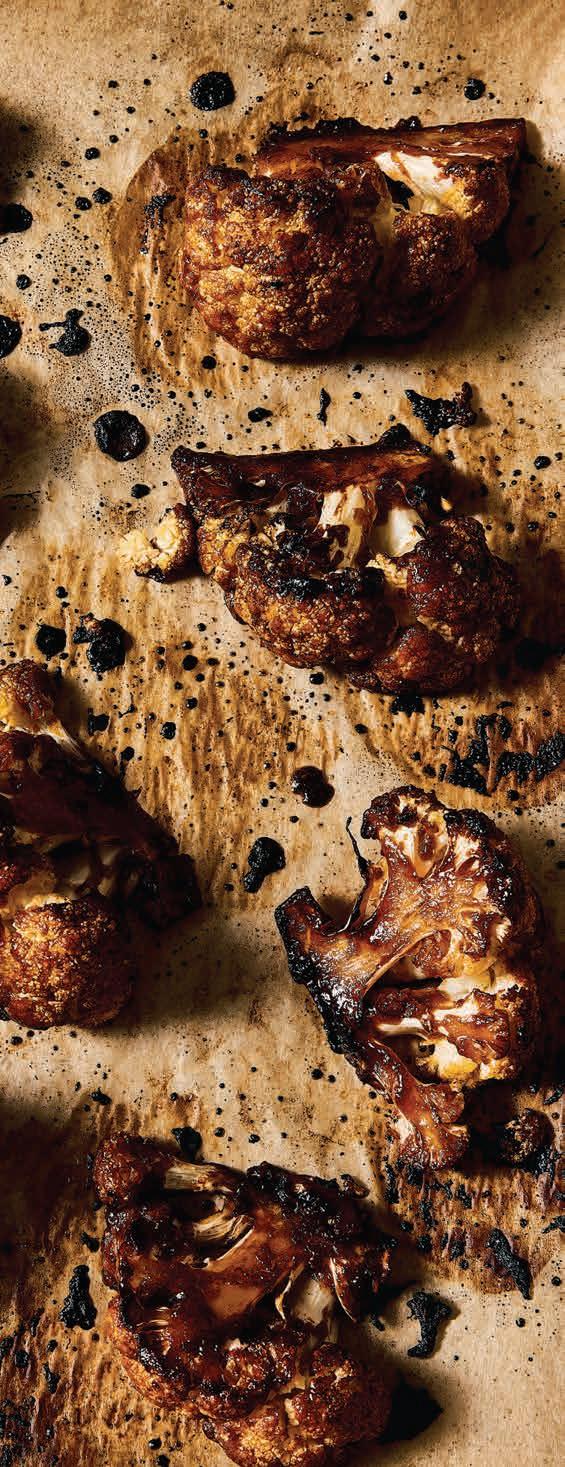
In tropical Vietnam, cauliflower is a prized cool-weather crop that’s typically stir-fried, added to soup, or pickled. Home ovens are uncommon in Vietnam, so few people roast cauliflower. In my California kitchen, however, I coat cauliflower wedges in saltysweet-spicy seasonings typically reserved for Cantonese-style char siu barbecue pork, and then high-heat roast them. The contours of the wedges caramelize here and there to develop a deep savoriness that evokes the prized edges and corners of char siu pork. Serve this cauliflower as a satisfying main dish or tuck it into bao and bánh mì.

SERVES 4
2 lb. head cauliflower
3 Tbsp. hoisin sauce
2 Tbsp. toasted sesame oil
1 Tbsp. agave syrup or mild honey
Scant 1 Tbsp. ketchup
1½ tsp. soy sauce
2 garlic cloves, minced and mashed or put through a garlic press
¼ tsp. Chinese five-spice powder
CUT THE CAULIFLOWER
Position a rack in the middle of the oven and preheat to 450°F. Line a rimmed baking sheet with parchment paper. Pull off or cut away large leaves from the cauliflower, saving them for soup or broth, if you like. Trim a slice from the core end, where it’s likely discolored. While holding the cauliflower at a comfortable angle, curved-side down, insert your knife tip into the core. As you push the knife in farther, gently rock the blade side to side and back and forth. In a few seconds, the cauliflower head should crack and naturally break into two halves (mine are always uneven). Now cut each half into 4
wedges, each no thicker than 3 inches on the uneven floret side. (Hold the cauliflower flat-side or curved-side down, whichever is more comfortable. Cut an additional wedge only if you must.) Using a dish towel, dry the wedges so they’ll absorb the seasonings well.
In a big bowl, stir together the hoisin sauce, sesame oil, agave syrup, ketchup, soy sauce, garlic, and five-spice powder. Add the cauliflower wedges and, using a big spoon or spatula, stir to coat well. Most of the seasonings should adhere. Spread the wedges out onto the prepared baking sheet, cutside down. Drizzle or smear any remaining seasoning from the bowl onto the wedges.
Roast the cauliflower for 15 minutes, use tongs to turn over the wedges, and then roast 10 minutes longer. Liquid will appear on the pan. Continue roasting 10–15 minutes, during which the liquid will concentrate, bubble, and thicken. As that happens, use the tongs or a spatula to flip the cauliflower pieces about three times so they pick up the seasonings. When done, the cauliflower should look richly browned and be tender yet slightly chewy. A knife tip pierced into the thickest core areas usually meets a little resistance. The total roasting time is about 40 minutes. To get a slightly deeper color and flavor, keep the baking sheet in place and switch on the broiler for about 60 seconds, monitoring carefully to avoid burning. Remove the cauliflower from the oven and let it rest a few minutes to develop flavor before serving. Pick
THE LEGENDARY ACTION HERO, LIFELONG ANGELENO, AND MAN BEHIND THE TREJO’S EMPIRE OF RESTAURANTS SHARES ZERO-ALCOHOL COCKTAILS IN THIS EXCERPT FROM HIS NEW COOKBOOK, TREJO’S CANTINA.
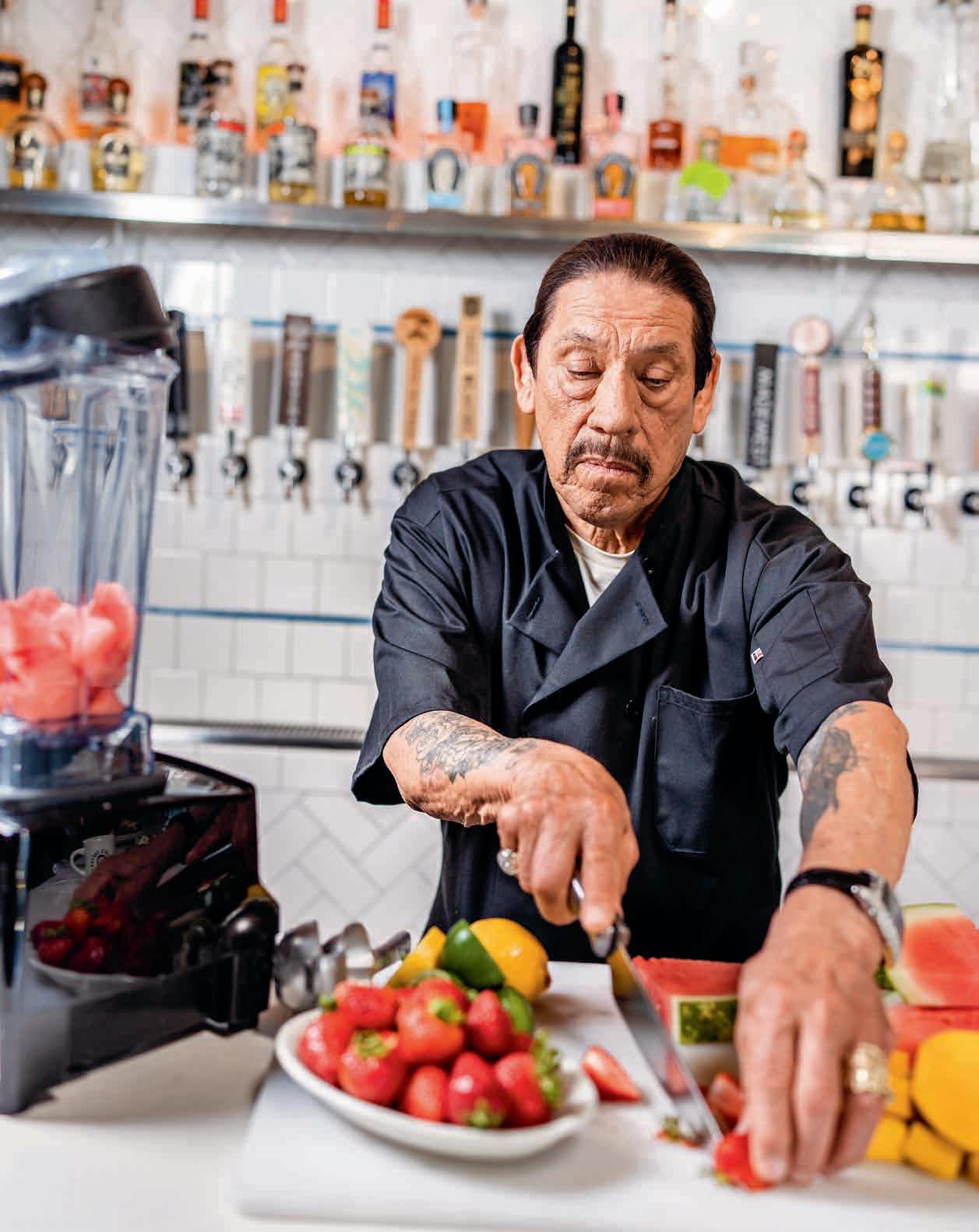
hen I stopped drinking alcohol some 50-plus years ago, I started drinking a lot of stuff that wasn’t necessarily all that great for me. Sugary drinks were pretty much the only alternative if you didn’t want to drink club soda, water, or coffee. In the penitentiary, I’d drink Pepsi, Coke, Kool-Aid, or iced tea. After I got out, my go-to drink at a party or bar would be cranberry and Sprite. When I didn’t want that much sugar I’d go for cranberry and soda. Not a thrilling menu of options.
What a difference it is for nondrinkers today. We are living in the golden era of nonalcoholic drinks and it’s hands down the best time in history to be a non-imbiber of alcohol. Not only are bartenders experimenting with booze-free drinks that have all the inventiveness and creativity of mixology, but there’s a whole range of zero-alcohol wines and“spirits” that are infused with herbs and spices and have backbone and bite without relying on ethyl alcohol. There are even a number of bars opening up that don’t stock a single bottle of booze. They’ve got the bar and the barstools, the sound system, and the cool, fun people—and they stay open late—but they don’t have the alcohol. While some folks like to call a drink without
alcohol a mocktail, I don’t think that word does justice to these new delicious creations. They’re not “mock” anything. They’re totally original, authentically delicious, and true to themselves. And they’ll never give you a hangover or a DUI!
Because you’re not going to be relying on spirits for flavor, you’re going to need to learn a few basic preparations, tools, and techniques to make the nonalcoholic drinks in this book. You’re going to be using fresh juices for natural sweetness, body, and flavor; fresh herbs for aroma; spice-infused syrups for additional depth; and sometimes even tea for tannin (that raspy bite that makes your tongue a bit dry). Making these drinks is actually a lot more like cooking than mixing liquids as you might for a margarita or Old Fashioned. And just like cooking, you can modify things to suit your own taste. Is something too sweet? Then cut back on the sugar. Is a spicy syrup not spicy enough for you? Then by all means double up on the chiles. And once you learn the principles of zero-alcohol drink making you’ll be improvising your own nonalcoholic drinks at home in no time.
I like Shirley Temple the actor a lot more than Shirley Temple the drink. And these nonalcoholic drinks developed in our Top Secret Hollywood culinary laboratory behind triplelocked doors (kidding) are some of the most delicious things I’ve ever tasted, and prove that you don’t need booze to make a sophisticated drink that tastes like a full-on celebration. Loaded with spices, seasonal tropical fruits, and balanced with infusions, these drinks will blow your mind.
Whether you’re sober, sober curious, or drinking less for physical, mental, or spiritual health reasons, I feel pretty confident that you’ll find something here that speaks to you. Some are totally original multistep project drinks you can make in big batches to sip throughout the week or share with your family and friends. Others are single servings you can whip up to toast the day, while some are based on Mexican classic cocktails. As with any recipe I’ve ever shared, I encourage you to take or leave what you want, and modify to your liking. Some people like more lime, others like it spicy, while others have a sweet tooth. Only you know what you like, so treat each recipe like an expert suggestion or starting point but not a strict set of rules. By now you might’ve picked up that I’m not a big fan of rules, but I do like delicious things. And now that I have these drinks around I will never have to drink a Shirley Temple again!
Cheers to that!

There are few foods more refreshing than a cool, crisp cucumber sprinkled with salt. Add spicy jalapeño and you have fire and ice. They both have that bright green color and fresh flavors and really work well together. It’s sorta like when you put on a great leather jacket. A second ago you were a regular person and now you’re a badass!
SERVES 4
1 medium English cucumber, sliced crosswise
1 (¼-inch) slice jalapeño
1 oz. (2 Tbsp.) fresh lime juice
4 tsp. sugar
Salt
16 oz. (2 cups) club soda
Lime slices, for garnish
1. In a blender, combine the cucumber, jalapeño, 1 cup water, lime juice, and sugar, and blend until the mixture is smooth.
2. Strain the juice through a medium fine-mesh sieve into a pint container (discard the solids).
3. Add a pinch of salt, taste for balance, and add a bit more if necessary. Cover and refrigerate until ready to serve.
4. To serve, pour 2 oz. juice mix into an ice-filled Collins glass. Add 4 oz. club soda and gently stir. Garnish with a lime slice and serve. Repeat as desired.
For more nonalcoholic drinks, along with recipes for cocktails and new takes on cantina cooking, pick up a copy of Trejo’s Cantina. $28; penguinrandomhouse.com
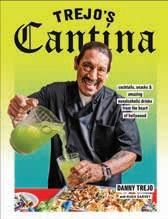
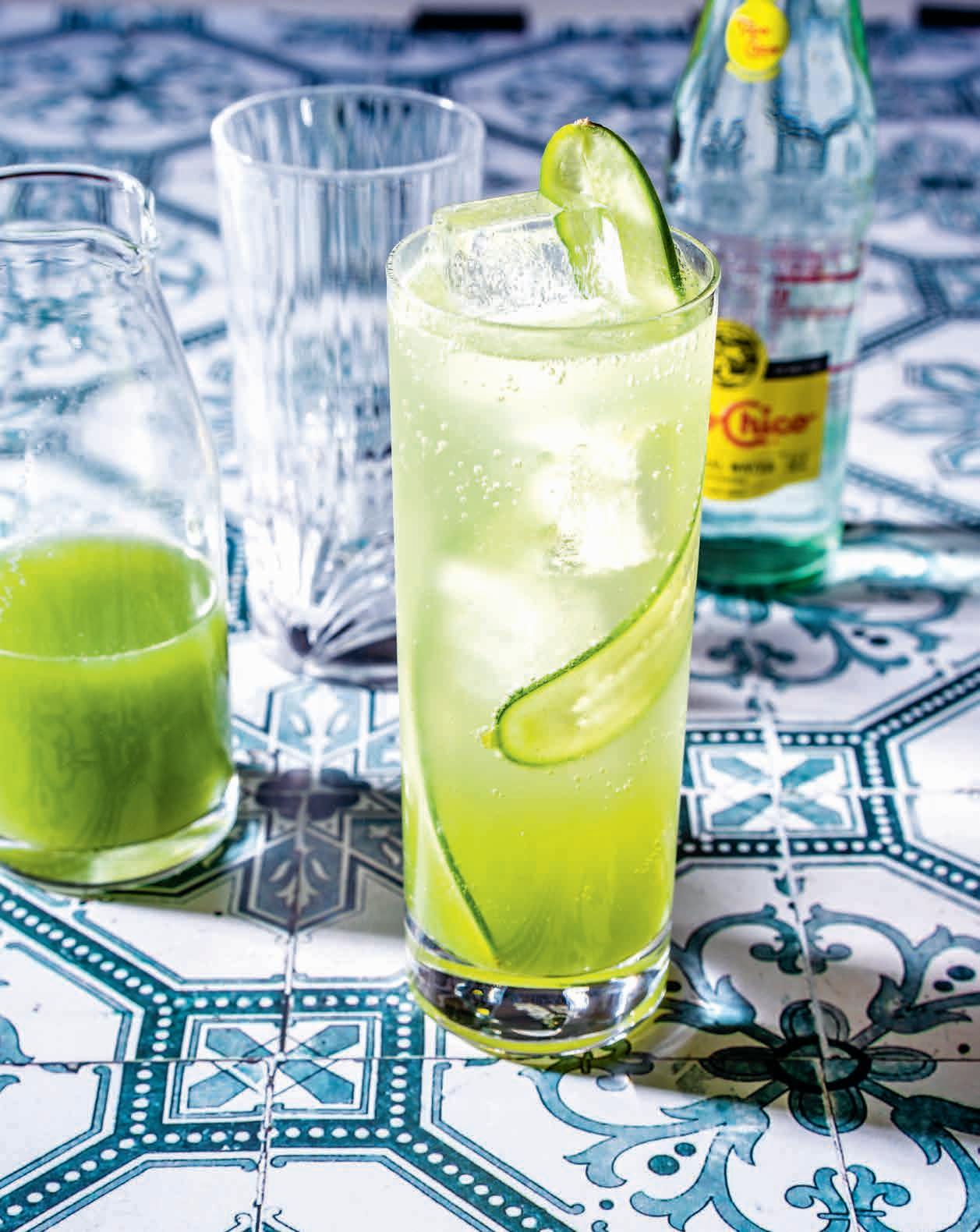
This is a low and slow recipe that takes some time to make, but the reward is worth the wait. Simply stated: You make a tea, strain it, add raspberries that will release flavors overnight, and you get a beautiful red drink that’s greater than the sum of its parts. The tangy hibiscus is a nice contrast against the sweetness of the raspberry.
SERVES 4
1 cup dried hibiscus flowers
1
3 cup sugar
½ tsp. vanilla extract
6 oz. raspberries
1. In a medium pot, bring 4 cups water to a boil. Add the hibiscus, remove the pot from the heat, and let steep for 15 minutes.
2. Add the sugar and vanilla to the hibiscus liquid. Stir until the sugar is completely dissolved.
3. Strain the liquid through a finemesh sieve into a medium bowl or large jug and set aside to cool, about 20 minutes.
4. Once the liquid is cool, add the raspberries, cover the container, and refrigerate overnight, 12–24 hours. To serve, pour into ice-filled Collins glasses and garnish with a few of the infused raspberries.
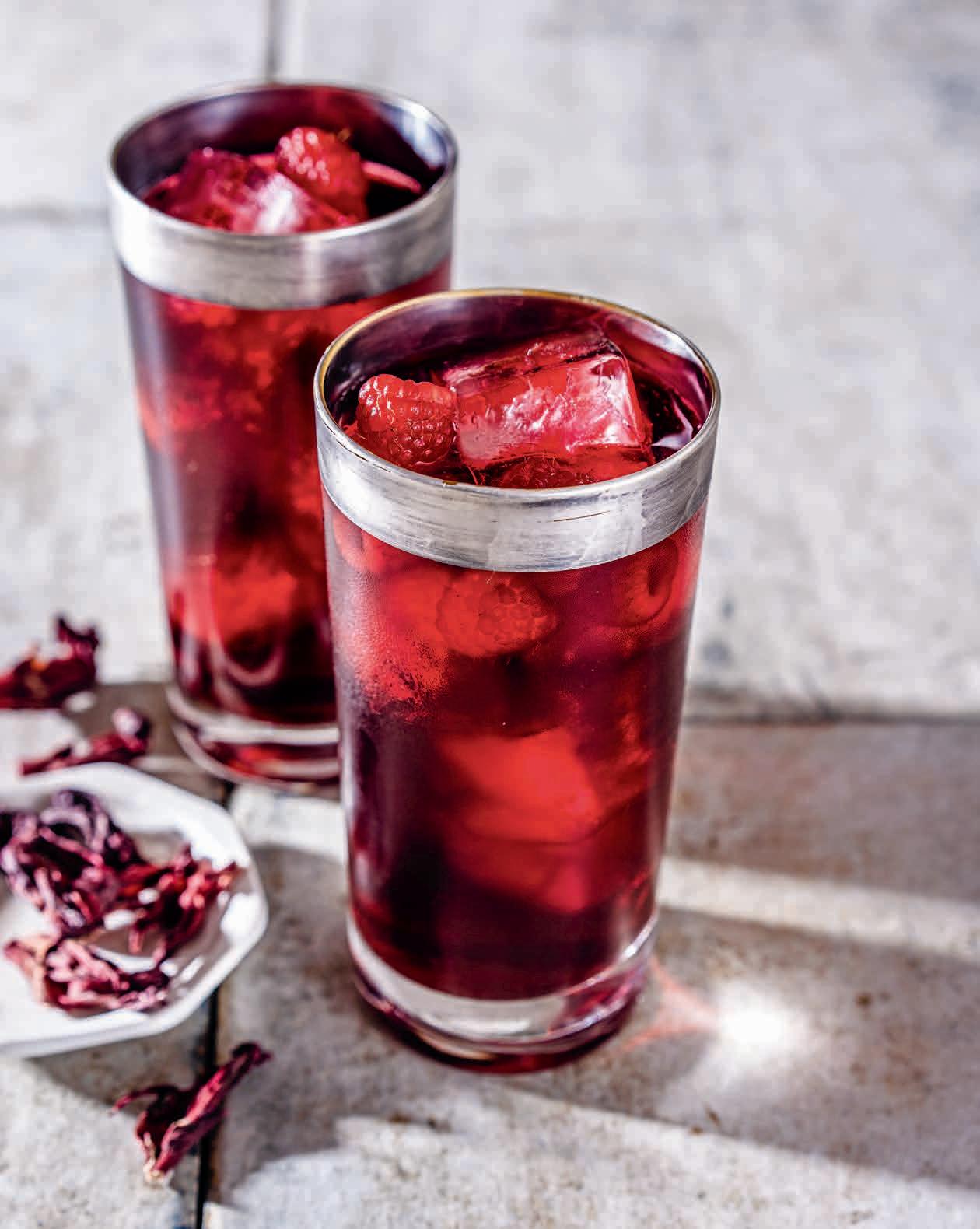
Tamarind is a huge part of the Mexican drinks tradition: You’ll find it at the agua fresca bars of taco joints and in bottled sodas across L.A. It’s earthy and sour and so good, especially when sweetened a bit, which we’ve done along with adding cinnamon and star anise. You can find tamarind pods in your local grocery in the Latin American food section or online.
SERVES 4
1 cup dried tamarind pods
½ cup plus 1 Tbsp. fresh lime juice
1 cup Spiced Syrup (recipe follows)
Salt Cinnamon sticks or star anise pods, for garnish
1. Remove the hard outer shells of the dried tamarind pods. Place the tamarind pulp and seeds in a medium pot and add 4 cups water.
2. Bring to a simmer over medium heat, then remove from the heat and let cool for 15 minutes.
3. Once it’s cooled, use your hands to mash the tamarind pulp in the cooking liquid, separating the pulp from the seeds. Discard all the seeds.
4. In a blender, combine the tamarind cooking liquid, tamarind pulp, lime juice, and spiced syrup and blend until smooth. Strain the liquid through a finemesh sieve into a 2-quart pitcher or airtight container. Add a pinch of salt, stir, and taste. Cover and store in the refrigerator until ready to use.
5. Pour into tall ice-filled glasses and garnish each with a cinnamon stick, or a star anise pod, or one of each.

THIS IS PURE HOLIDAY VIBES IN A DRINK.
MAKES 2 CUPS
¼-inch-thick slice fresh ginger
1 cinnamon stick
5 allspice berries
2 cups sugar
1. Put the ginger in a medium pot along with 2 cups water. Using a muddler, gently crush the ginger enough to break it up a bit. Bring the water to a boil.
2. Meanwhile, in a small skillet, toast the cinnamon and allspice until fragrant and warm, 2–3 minutes.
3. Add the toasted spices to the boiling ginger water and boil for about 5 minutes. Remove from the heat and let it steep for 15 minutes.
4. Add the sugar and stir until it has dissolved. Strain the syrup through a fine-mesh sieve into a large bottle or airtight container and store in the fridge until ready to use.
Long before foraging was the hot new thing and the term California cuisine was coined, native American cooks were celebrating the bounty of the land. Now a new wave of indigenous chefs and makers are evolving native food firsthand in fresh and exciting ways.
 Story by KRISTA SIMMONS
Story by KRISTA SIMMONS
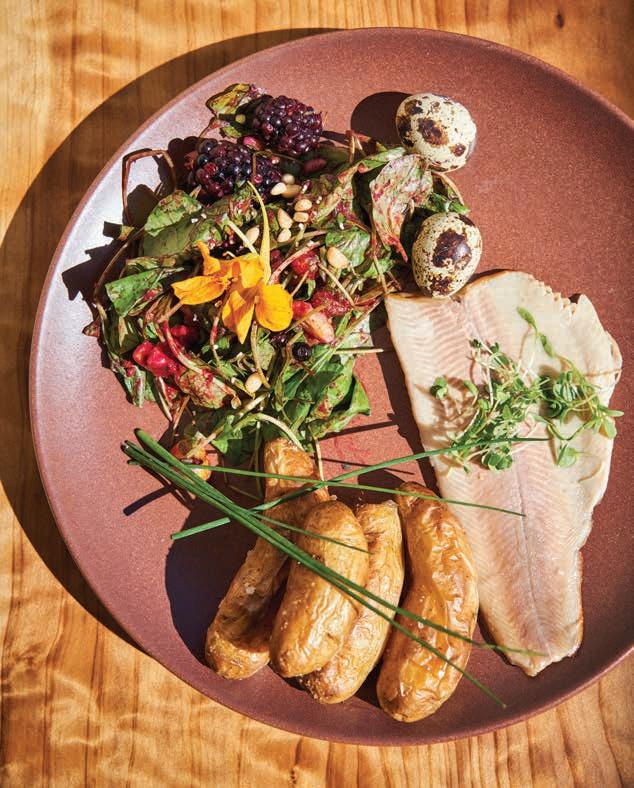

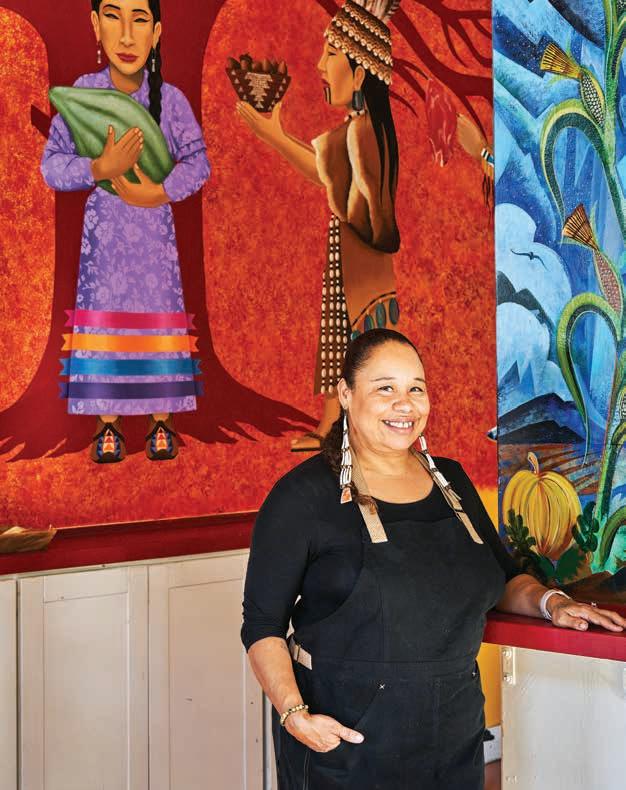

What started in 2018 as a pop-up in the back of an off-campus bookstore has become a beacon of California Indigenous cuisine, where co-founders Vincent Medina and Louis Trevino celebrate the culinary heritage of the Ohlone tribe in the East Bay.
Medina and Trevino are activists whose medium of resistance happens to be food. When they were growing up in the East Bay, there was a dearth of storytelling surrounding the resilience of the Ohlone people. With their roving project known as Cafe Ohlone, they homed in on a means of culinary storytelling that showcases the vibrance of their culture. The latest iteration of Cafe Ohlone is ‘ot · t · oy, which means “to repair” in the Ohlone’s Chochenyo language. This collaboration with the Hearst Museum at UC Berkeley is equal parts
educational installation and degustation. The journey begins by walking through a serene outdoor space alive with plants from Oaktown Native Plant Nursery and birdsong harmonizing over the speakers. In an organic minmalist space designed by t he landscape firm Terremoto, g uests enjoy a meal interspersed with Medina’s powerful voice sharing stories of Ohlone land, language, and culture.
There are several ways to visit ‘ot toy, including weekly tea ceremonies, lunch tastings, dinners under the stars, and Sunday brunch. Meals are marked by dishes like soft-boiled quail eggs, cold-smoked trout, and a bay laurel-spiked salad of indigenous ingredients—all of which sing of the surrounding land and community.
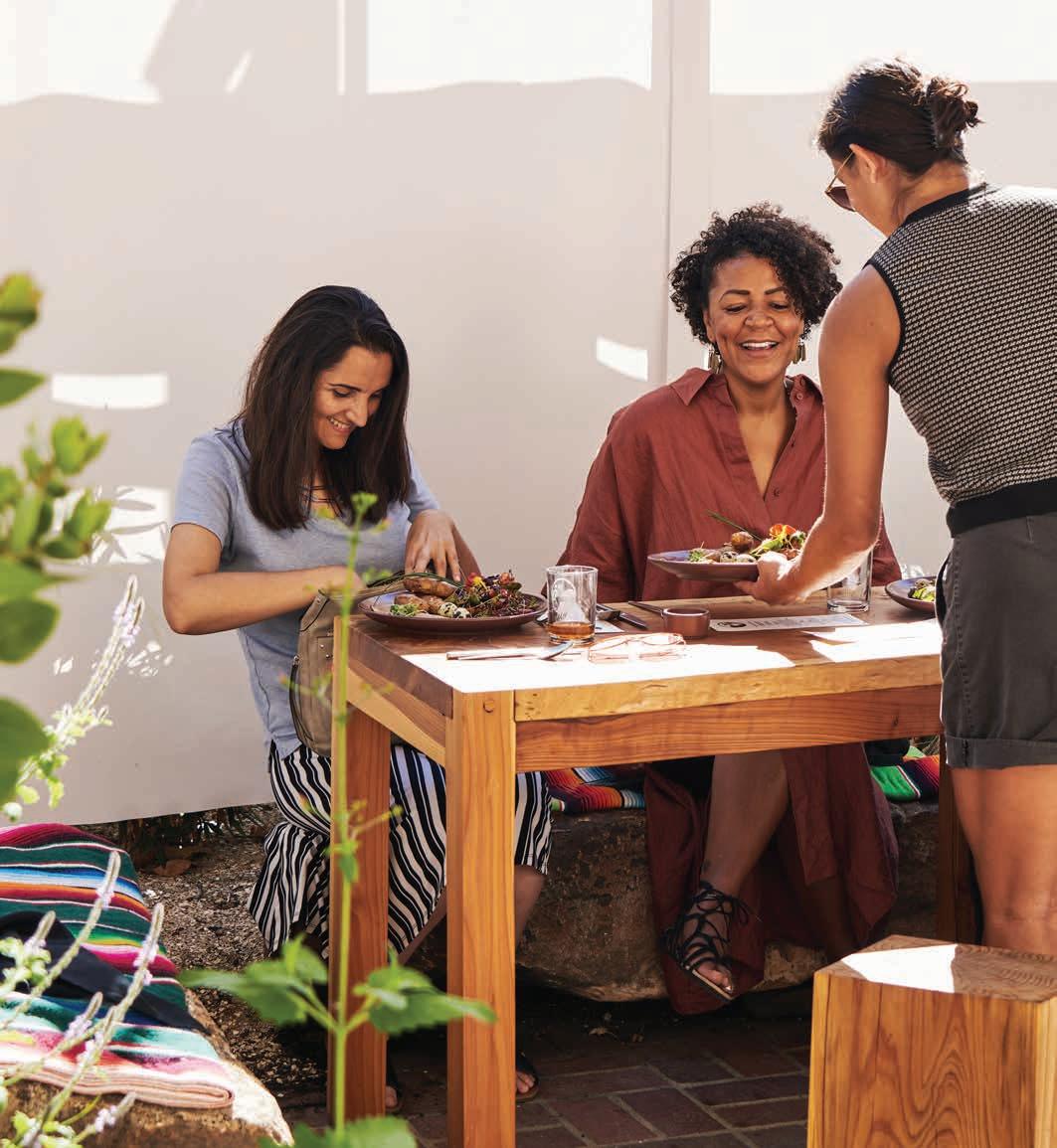
Here, Medina and Trevino share the story of Cafe Ohlone and ‘ot · t · oy.
 VINCENT MEDINA AND LOUIS TREVINO ON THE EVOLUTION OF THEIR CULTURAL AND CULINARY PROJECT AT UC BERKELEY
VINCENT MEDINA AND LOUIS TREVINO ON THE EVOLUTION OF THEIR CULTURAL AND CULINARY PROJECT AT UC BERKELEY
To start, tell us a bit about ‘ot · t · oy. What region and culinary traditions are you celebrating?
Cafe Ohlone was established in xučyun (translation: Berkeley) in the summer of 2018 as an extension of our community work through mak’amham (translation: our food), an Ohlone cultural institution focused on the continuity and restoration of our traditional culture.
Our work is specific to the eastern shores of San Francisco Bay, the East Bay, to which our community has an unbroken relationship, and where our people have always lived.
Why is this work personally important to you?
Growing up, there wasn’t much representation of Ohlone identity outside of the homes of our family because of the harm that occurred through a history of violent colonization. However, the culture continued to live—albeit practiced quietly in our homes in order to keep these traditions, and our people, safe during unsafe times.
Now we are in a time of greater awareness. With our elders’ blessings, Cafe Ohlone was developed to be a tangible space where our culture and cuisine can be reflected within our beautiful homeland.
The dishes we prepare represent Ohlone gastronomy and are specific to coastal, central California, specific to the East Bay, as well as dishes our family embraced at different periods of our history.
What is the one message or teaching that you hope diners walk away with after experiencing your food?
You include sound and language in the experience for guests, which is really quite beautiful to experience. Can you share why that’s something you like to include?
intermingled.

Every generation of us Ohlones has always been here in the East Bay. We’ve never left our land, and we never will. We want our guests to associate us with victories and strength, because our identity, culture, and presence has persevered as a result of the strength and sacrifices of those before us—our elders and our ancestors. [We want to showcase that] the Ohlone culture is beautiful and dignified, as we have always known to be true.
We want people who walk into Cafe Ohlone to be in a world reimagined, a sovereign space that reflects Ohlone culture as we see it at home, both rooted in old ways but not shying away from modernity. When guests enter Cafe Ohlone, a soundscape moves through the outdoor terrace surrounded by California native gardens where native birdsong, the sounds of Chochenyo language in song and conversation that come from the family are
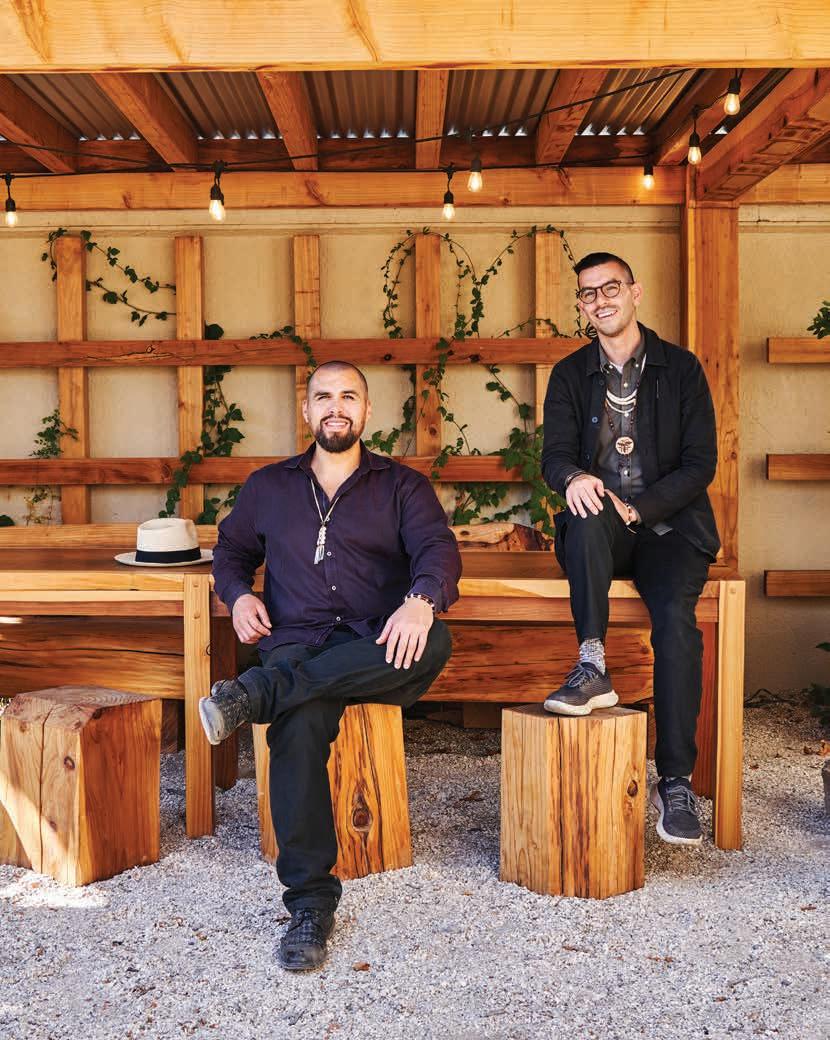
There is so much abundance in the space, and this reflects the world as we know it should be here in the East Bay. These sounds have a way of transporting people and their mindsets away from the urbanity of the street, and also reflect that our language is alive, spoken intergenerationally by elders and children alike.
In fact, Chochenyo language is growing in speakers every year, not declining. We want those dining with us to see the world as we see it, and our soundscape helps to accomplish that goal.
If there’s one ingredient or dish that you feel embodies the culinary traditions you’re celebrating, what would it be?

Well, it has to be paamu, or acorn soup. Ohlone gastronomical traditions are complex, seasonal, and hyper-localized. Acorn soup is our staple food. It accompanies every meal in our traditional culture and continues to be such a comfort food today to us. Silky and sweet, acorn soup takes about six months to prepare from start to finish.
The process begins with gathering acorn in the East Bay hills, then letting the acorns cure for months until its moisture is removed. The acorns are then shelled using family baskets that are sometimes over 100 years old to winnow their skins off, grinding them into a flour so fine it is then sifted in another basket, then leaching the tannic acid out through a slow drip for a half-day.
Finally, the acorn flour is ready to be made into soup, which is traditionally done with treated cooking stones in cooking baskets that are so finely made that they can hold water. Within minutes, boiling hot acorn soup becomes gelatinous and thick, its natural sugars caramelize until it becomes lightly sweet, and is ready to be eaten.
that means less and less spaces to gather where these beloved foods were gathered by generations before us. Climate change also is accelerating the lack of access to some foods that were common just a few decades ago. Locally and globally, climate justice is inherently connected to the well-being of Indigenous foodways.
Here on Ohlone land, we want open spaces to be protected, gathering rights for our people, and for repair to happen where harm has been done as we work to see the old ways stay strong with our elders’ leadership.
What are meaningful and considerate ways that readers can engage with native cuisines in California and beyond?
We eat paamu with everything else on our plate, similar to how rice or bread is eaten in other cultures.
Seared venison backstrap, smoked salmon, or roasted chanterelles are dipped into it, and it accompanies every bite so well. Today the family will even have it alongside tamales.
Here in the San Francisco Bay Area, a great way is to visit us at Cafe Ohlone to learn more about us, our rich culinary traditions, and our living culture. Learning directly from the people indigenous to the region in which the education takes place is paramount. This, of course, extends to all places.
Every place within the range of Sunset Magazine’s readership has an indigenous identity, people, and cuisine. We encourage everyone to respect and honor Indigenous culinary traditions as the first culinary traditions in respective regions.
Acorn is a food that has sustained Ohlone civilization for thousands upon thousands of years, a food we believe is given to us by God during our creation time, and it still sustains us today.
What do you hope the future of Indigenous cuisine is, both here in the West and globally?
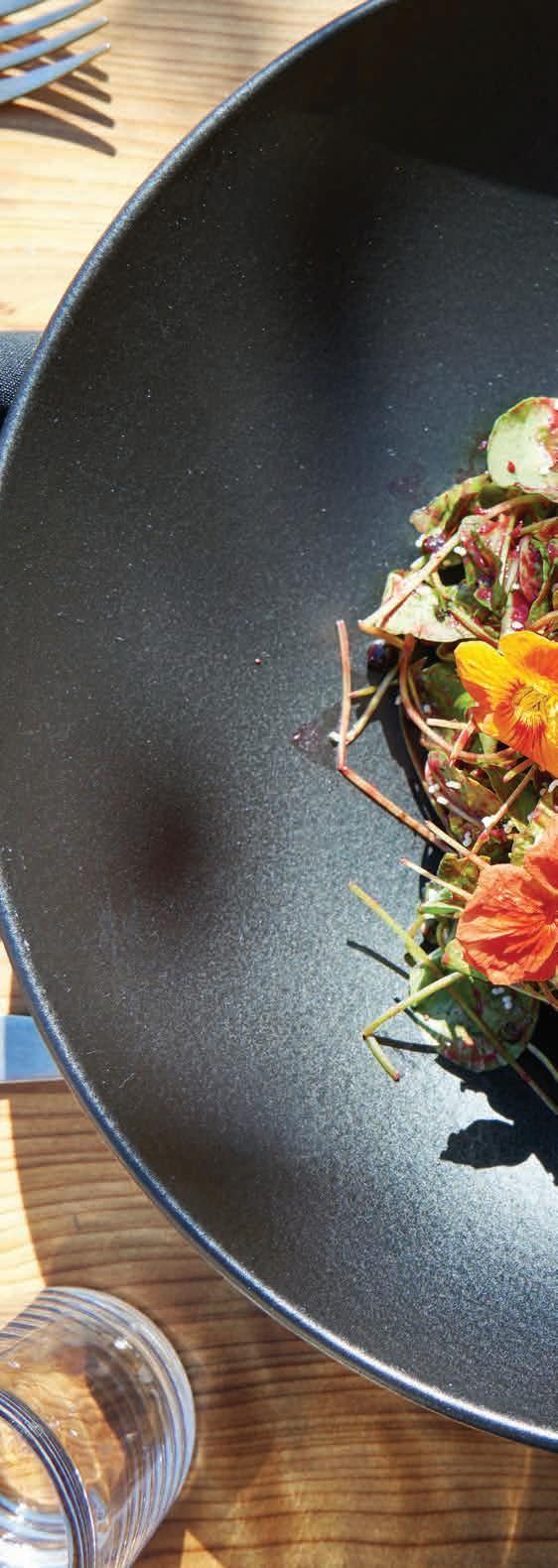
We want traditional Indigenous foods to be respected for their inherent value, and given the protection they deserve by having safe spaces to gather and have access to the foods specific to place. In the San Francisco Bay Area, there is constant development, and
Here in the San Francisco Bay Area, the culinary scene is incredibly diverse and multicultural, which we at Cafe Ohlone enjoy and celebrate. But we know that here in our homeland, our Ohlone foods, prepared by our people, are to be held in the highest esteem, because they are indigenous specifically to this place.
Our foods hold within them the beautiful reality of a world before colonization, the ways in which our family continued to live happy, meaningful, and dignified lives during even the most difficult periods of our history, the dynamic, joyful, and refined Ohlone community today, and the possibilities of a future wherein our Ohlone people, cuisine, and traditions continue to flourish.
We simply encourage mindfulness of these facts as Sunset’s readers think about cuisine.
This salad, served at a recent installment of ‘ottoy at Cafe Ohlone is one of the truest ways to taste the abundance of the East Bay. Using a wide variety of native ingredients topped with a vibrant berry dressing that’s punctuated by the herbaceous richness of California bay laurel, the salad’s flavors are at once familiar and exciting.
The recipe calls for ingredients like East Bay pickleweed, also referred to as sea beans, which can be found at specialty grocers like the Berkeley Bowl and select Whole Foods.
Use what you can gather mindfully; the real joy is experiencing the colorful array of ingredients and appreciating the land and culture from which it comes.
MAKES APPROXIMATELY 2
¼ PINTS
2 pints California blackberries
1 California bay laurel leaf (or commercially available bay laurel)
¼ cup water
1 Tbsp. agave nectar
East Bay salt to taste
1. Make the dressing. In a medium saucepan, simmer 1/4 cup water with blackberries. Add California bay laurel leaf and agave nectar. Once the blackberries simmer to bursting, remove bay laurel, and blend to a smooth purée. Set the dressing aside to cool.
SERVES 6
5 bunches watercress
3 oz. East Bay pickleweed (also known as sea beans or salicornia)
1 bunch purslane
1 bunch redwood sorrel
3 Tbsp. piñons, also known as toasted pine nuts, plus more for garnish
3 Tbsp. California black walnuts, shelled
6 Tbsp. roasted hazelnuts
2. Assemble the salad. After washing and drying berries, greens, and flowers, finely chop East Bay pickleweed, and cut gooseberries into halves.
1 pint California blackberries
2 pints gooseberries
1 pint California huckleberries
1½ Tbsp. roasted walnut oil

6 oz. dried California strawberries
6 nasturtium flowers
6 California violas
2 Tbsp. amaranth seeds, popped
3. In a salad bowl, combine watercress, pickleweed, purslane, redwood sorrel, piñons, black walnuts, hazelnuts, blackberries, halved gooseberries, and huckleberries, reserving a few of the berries to garnish individual plates.
4. Pour the prepared dressing and roasted walnut oil over the bowl and toss to combine. Add crushed East Bay salt to taste.
5. Plate the salad. Top the salad with a garnish of California blackberries, halved gooseberries, California huckleberries, dried California strawberries, toasted piñons, nasturtium flowers, and California violas.
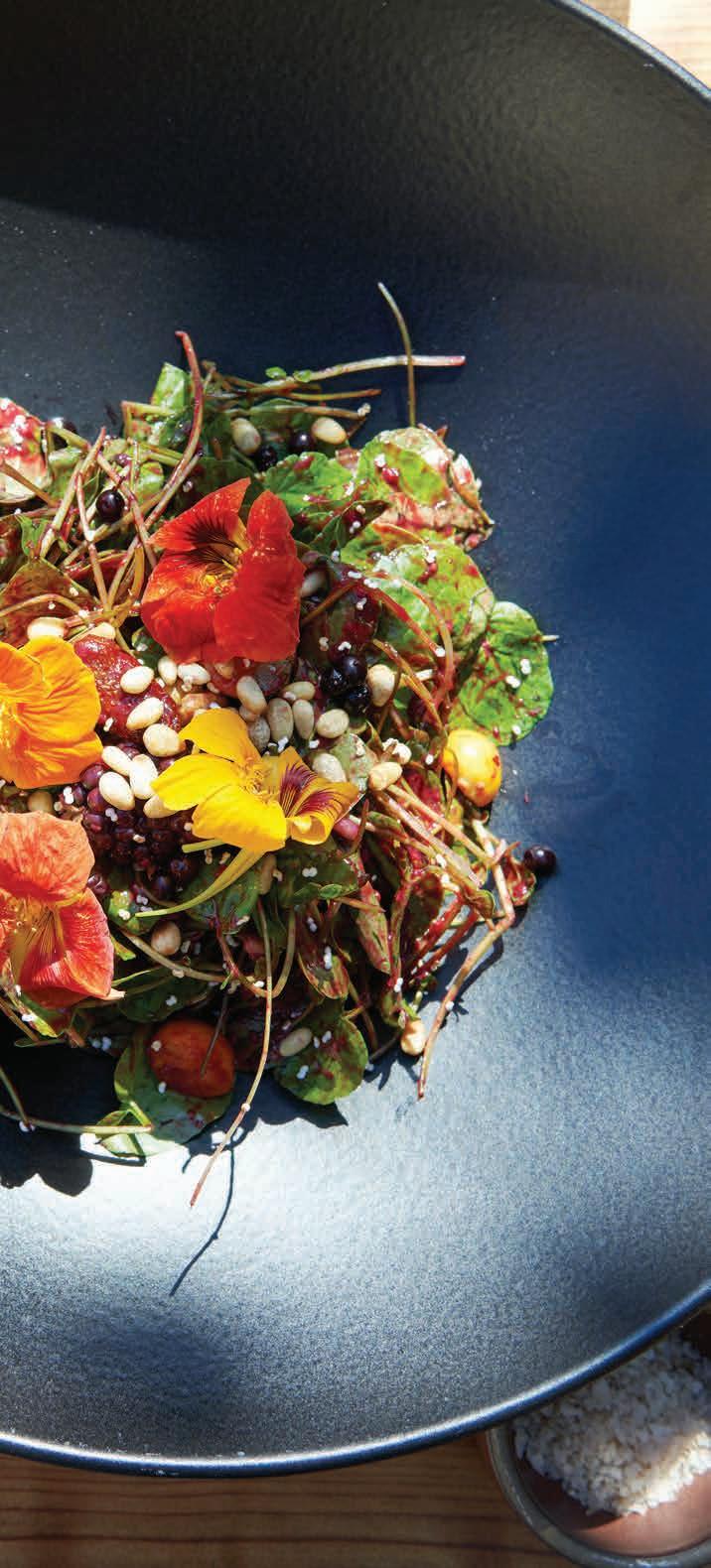
6. Add a sprinkling of popped amaranth seed and serve.

Walking into Crystal Wahpepah’s Oakland restaurant, Wahpepah’s Kitchen, is a vivid feast for all of the senses. Colorful Indigenous murals cover the walls, and the warming aroma of roasting blue corn wafts through the air. Wahpepah’s smile lights up as she speaks about the open pantry that she’s placed at the focal point of the dining room.
“Some people get excited about shopping for shoes and purses. Me, I get excited over ingredients,” she chuckles.
An enrolled member of the Kickapoo nation of Oklahoma, Wahpepah was born and raised in Oakland on Ohlone land, surrounded by a tight-knit, multi-tribal urban community. Through her dishes like three-sister veggie bowls, bison tacos, and acorn crêpes, she’s reframing traditional cooking through a modern, relatable lens with an end goal of empowering the native food sovereignty movement and educating communities on the health benefits of traditional foodways. The shelves are stocked with mason jars loaded with mindfully sourced intertribal foods used in Indigenous cooking spanning North and South America. From Kansas Kickapoo and Seneca white-corn varieties to chokecherry powder from South Dakota, her collection showcases the diverse array of products that mirror the biodiversity and beauty of the land.
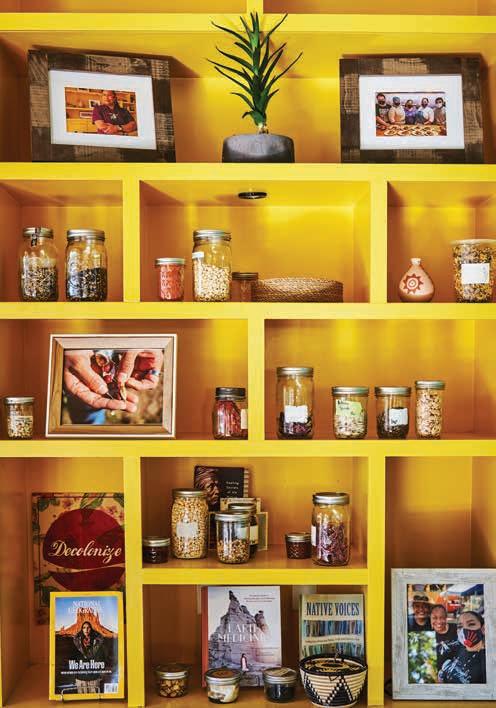

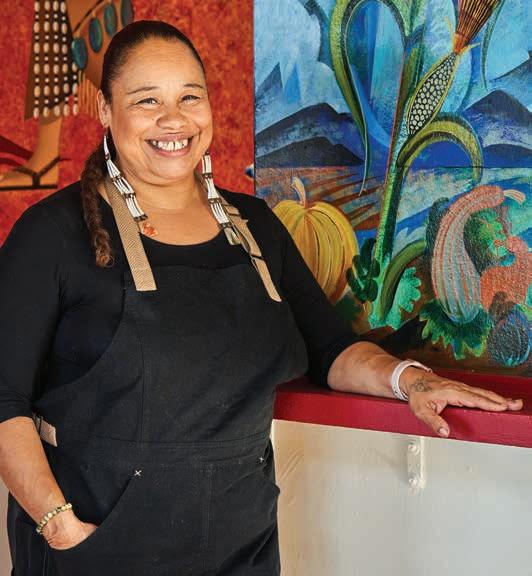
F The nuts of the California bay laurel tree are edible when roasted, and have long been consumed as a condiment, digestive aid, and stimulant. In addition to being totally rich and delicious, bay nuts also give you a caffeine-like energy boost. The aroma and flavor are somewhat similar to a cross between carob and chicory. “Roast them and prepare it just like a pour-over,” says Wahpepah. “Or purée them and try them rolled into a truffle or brownie.”


F These soft, edible seeds found in the cones of Northern Californian pines are an incredible source of nutrients, and are rich in monounsaturated fats and vitamin E. The pine’s sap is also traditionally used as a salve or ointment. Wahpepah gathers her own, then roasts them before using them as a topping on everything from soups to salads.
F “The valley oak acorn is bread, it’s life,” says Wahpepah. “Anything you can do with wheat or corn, you can do with acorns.” Processing acorn is a bit of a task; it must be washed multiple times in order to eliminate the inherent tannic acid, but it’s well worth the work. At her restaurant, Wahpepah utilizes the tan oak acorn to make a beautiful breakfast crêpe that’s topped with maple cream, seasonal native berries, and a sprinkling of maple sugar.
F Very common in the Bay Area, the leaves of the California bay laurel tree add a depth to soups and stews not all too dissimilar from bay leaves you might find at the grocery stores. While the latter will likely come from a member of the laurel family in the Mediterranean, the California bay laurel leaves are significantly more pungent and aromatic. It’s important to use the chef’s trick of consistently tasting the dish when seasoning with bay laurel, so that you can remove the leaf once you’ve reached the right depth of flavor without totally overpowering to a dish.
F Wild roses that grow throughout the Sierra Nevada chaparral are gorgeous to view when in bloom. But the real magic comes when their outer leaves fall, exposing their delicate inner delicate bud. Wahpepah uses them in her chocolate rose hip bars, made with popped amaranth, maple, rich, traditional Mayan chocolate, pecans, and hand-harvested wild rice from the Red Lake Nation in Minnesota. She also makes a rosehip dressing for salads that uses dried rose hips, Séka Hills olive oil, salt and pepper and citrus. Rose hips can also be used in teas and are incredibly high in vitamin C, making them a great cold remedy.
“The three sisters love fruit,” says Wahpepah. “For instance, right now we have pomegranates to add a pop of sweetness.” Dried fruit like dried cranberries also work well. “Don’t take it too seriously,” she says. “It all gets mixed in at the end.”

Things tend to blend well that grow together seasonally,” says Wahpepah, who is a regular at local farmers’ markets. “We add apples and beets in the fall, for instance,” she says. There are a wide variety of both winter and summer squashes to utilize, too, so use what’s in season and enjoy experimenting with different varieties.
If possible, it’s always best to use dried heirloom beans, taking the time to soak them overnight, versus canned. “I use tepary beans, an old heirloom bean, and if you can get them they’re great. They have a little more character than a pinto bean,” she says. “They’re more fresh and have a vibrance you can taste. Try to go as natural as possible. And of course, if you grow it, even better.”
Beans, squash, and corn —known as the three sisters in the Indigenous kitchen—are a living example of the culinary adage that what grows together goes together. Planting these items in conjunction, so that the beans climb the corn stalks, allowing the squash room to sprawl out on the ground, is a centuries-old agricultural tradition that not only fixes nitrogen, but protects the soil with shade during the warm summer months.
“The three sisters really represent strength, and are used across Indigenous cultures. It’s regional, and everyone has their own interpretation,” says Wahpepah. “I was raised knowing how that strength is seen not only when you plant them together, but also when you eat them together.”
Growing up in the Bay Area, Wahpepah enjoyed the combination in soups and stews, or sautéed with venison. At her Oakland restaurant, she prepares the three sisters in a modern-style grain bowl, always adorned with seasonal ingredients, maple chile oil, and a punchy vinaigrette using Séka Hills olive oil.
Wahpepah loves adding elements of spice and acid to her bowls to enliven the palate. “You have to have something citrusy to lift it up. You can even add orange or lemon,” she says. You can DIY a maple chile oil similar to what she has in the restaurant, or even add a dollop of Calabrian chile paste to kick it up a notch.
Here are her tips for making a three sisters bowl at home.
“Food can be ceremonial, and it can be a celebration,” says Wahpepah. “Always take a moment and acknowledge where food comes from and the land that it comes from. Everybody’s food has stories, and having that connection, that’s where our healing comes from.”
 LEARN TO MAKE THIS ELEMENTAL COMBINATION INTO A WHOLESOME, HEARTY BOWL IN YOUR HOME KITCHEN
LEARN TO MAKE THIS ELEMENTAL COMBINATION INTO A WHOLESOME, HEARTY BOWL IN YOUR HOME KITCHEN
Liquid Gold in the Blue Hills
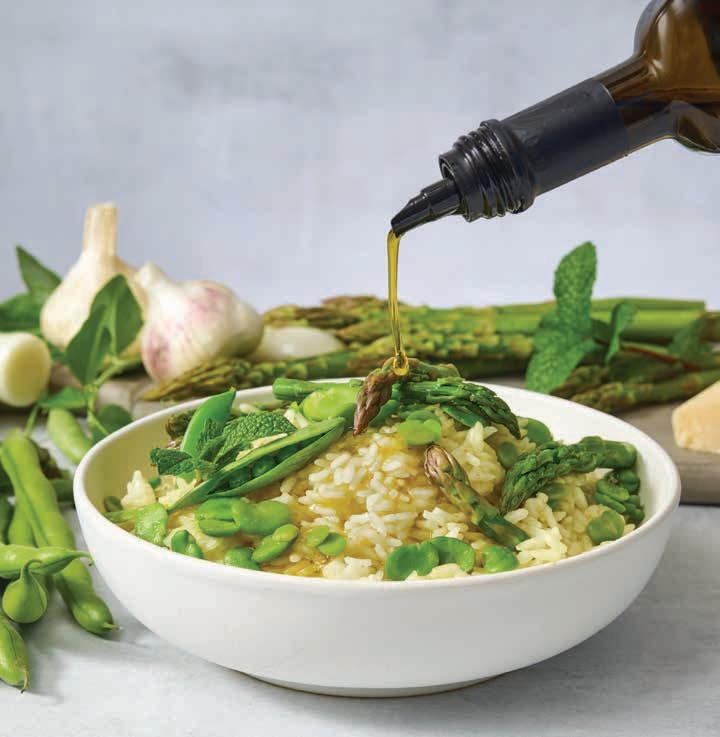
ROOTED IN NATIVE CALIFORNIA
The company started from humble beginnings, bringing just a few cases of wine and oil down the Bay Area, selling door-to-door at indie food stores and high-end grocery chains. Now Séka Hills has placement in nearly 1,000 restaurant and retail
locations, including Wahpepah’s Kitchen in Oakland.
The decision to plant olive trees, produce olive oil, and build the Séka Hills Olive Mill grew from the tribe’s desire to create opportunities for a long-term, environmentally sound investment in a region of Northern California where the tribe has resided for thousands of years. The mission is to carry on the legacy of their ancestors by tending the natural resources and land that are home to their rich culture, history, language, and traditions.
“This business lends itself to longterm sustainability. We planted our first olive grove in 2008, and we

2021 TRIBAL BLEND OLIVE OIL

expect that the grove will continue to produce for the next 15–20 years,” says James Kinter, Yocha Dehe Wintun Nation tribal secretary and property, farm, and ranch chair. “We built the mill in 2012 and expect it to be here and to continue making great olive oil for generations to come.”
But it goes way beyond simply providing the market with exceptionally delicious estate-grown olive oil. (Séka Hills has been a winner of the Sunset Pantry Awards and was also featured in our exclusive subscription box.) Far from a monoculture, the groves are set on native oak rangeland where 12 crops are being grown at any given time, from winter squash and tomatoes to chickpeas and almonds. The tribe also grazes 800 Angus cross cattle in the area.
“It also gives us the time and the opportunity to teach our tribal citizens about this kind of agricultural business,” says Kinter. Working closely with the community, he believes the brand provides opportunities for hands-on leadership and the running of the business for generations to come.
79 HOME & GARDEN 2023 • SUNSET
{ OUR PICKS FOR WHAT’S ESSENTIAL IN THE WEST }
Redwood has been the preferred building material in the West for generations. Redwood heartwood is resistant to termites and decay, and no other material matches the natural beauty of real redwood. Redwood warms residential structures inside and out. getredwood.com
Through partnerships with local growers and innovative plant breeders, Sunset Plants are customized to meet the climatic challenges of our diverse regions. Easy-care, water-wise, and full of brilliant color and vibrant texture, find Sunset Plants at your local garden center. SunsetPlantCollection.com


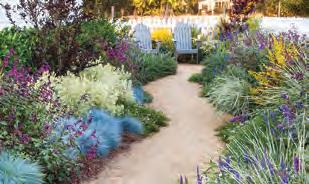
Reclaimed teak brings rustic warmth to Sea Ranch’s bold yet simple silhouettes. Sleek stainless-steel hardware offers a contemporary contrast to the rich texture of the wood, along with a touch of industrial style. terraoutdoor.com
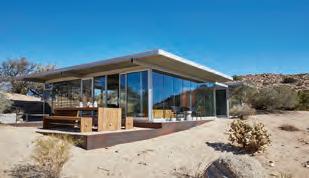
Oregon's only National Park and the nation's deepest lake is just 50 miles north of Medford in Southern Oregon. Plan your adventure now with twelve direct flights to Medford Airport or an easy road trip on the Interstate 5. travelmedford.org/crater-lake-national-park-
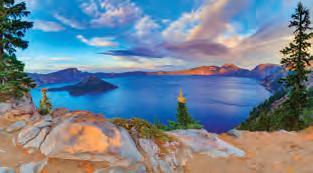
Skip the ticket line and book online! Skywalk and General Admission is just $64 for a limited time. Be sure to download the new Grand Canyon West App before you visit. grandcanyonwest.com

The Sunset Subscription Box brings the Best of the West straight to your door! Every three months, you’ll get a box full of home, design, food, and gardening products curated by Sunset editors. Choose the box that fits your style and price point, then get ready to be surprised and delighted by what you find inside! TheSunsetBox.com
A new wave of sustainable and regenerative travel is taking hold in the Willamette Valley.
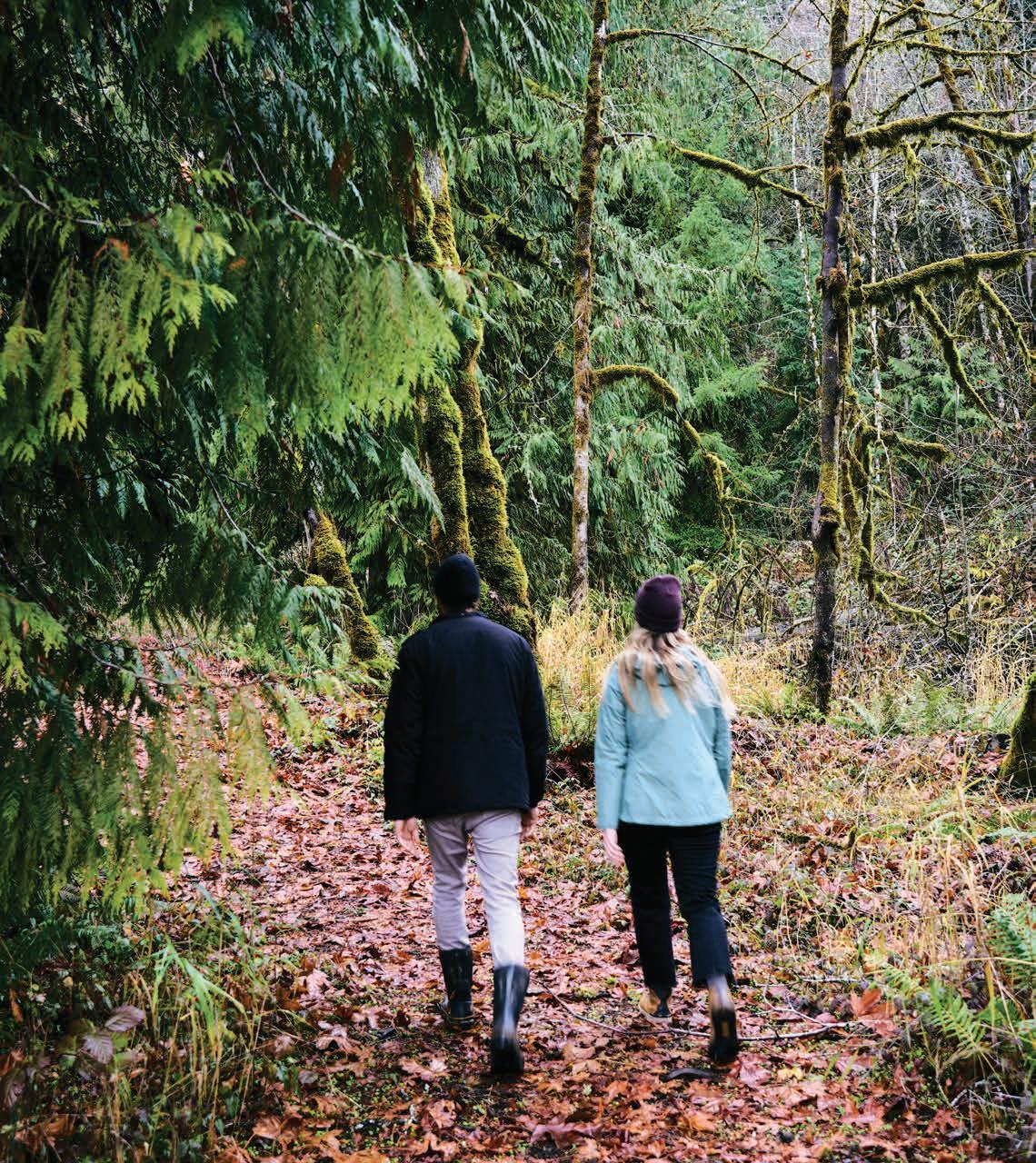 Story by KRISTA SIMMONS
Photograph by THOMAS J. STORY
Story by KRISTA SIMMONS
Photograph by THOMAS J. STORY
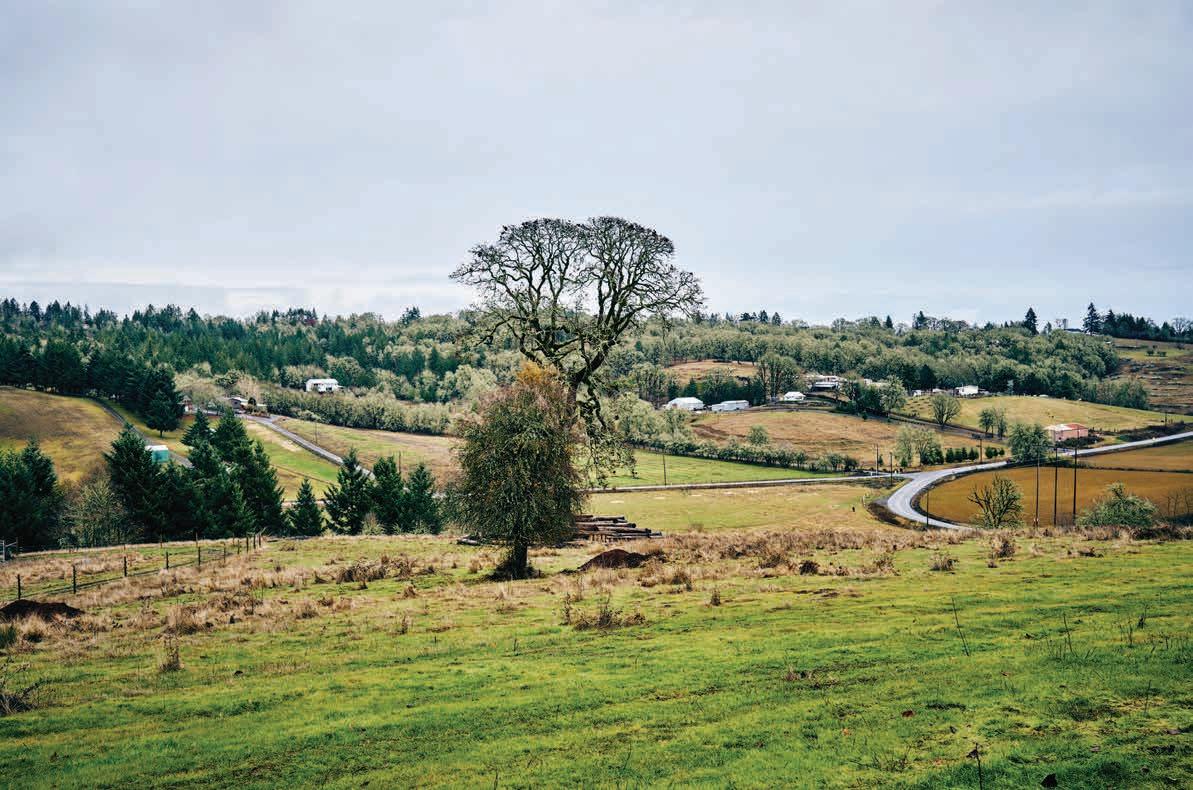


ooking out over the rolling green hills dotted with lush Douglas fir and vineyards, I swirl my glass, take in the aromas, and sip. Immediate clarity, vibrant minerality, and a smooth, round finish blanket my palate. But it’s not the Willamette Valley’s best Chardonnay I’m tasting. It’s water. Spring water to be exact. And it comes from below ground at Tabula Rasa, a regenerative farm in Carlton, Oregon, that’s raising the bar when it comes to offering engaging and meaningful experiences for travelers looking to reconnect with their inner wild, and leave the land better than the way they found it.
Founder Brenda Smola-Foti, who co-owns the farm with her husband Frank Foti, has purposefully designed her property to be not only sustainable but beautiful. It’s Biggest Little Farm come to life in the Pacific

Northwest, with multiple natural springs supporting grass-fed and -finished cattle, heritage breed hogs, and pasture-raised laying hens. There’s also a massive permaculture garden that raises pretty much every heirloom vegetable under the sun.
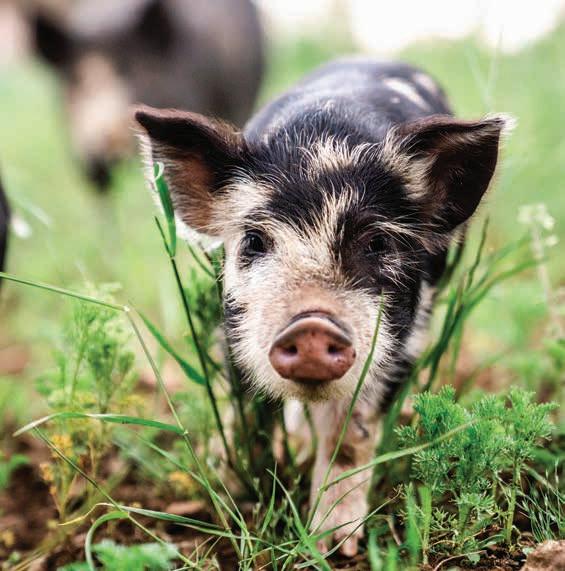
Her business is much more than a farm, though: It includes a restaurant, an Airbnb homestead, and, launching later this summer, a design-forward, eco-conscious nine-room inn. Each of the hospitality components provide entry points for travelers to experience the work Smola-Foti and her staff of six do on the farm—but it all comes back to water.
Water has been the aligning force in the journey of Tabula Rasa Farms, where Smola-Foti had for several years battled against a severe lack of it. That scarcity led her to realize just how vital it was in a region like the Willamette Valley. It came as a bit of a surprise to me when Smola-Foti described her hair-pulling journey to locate a functional well in the region. In all my visits to the region over the years, I’ve been awestruck by towering evergreen trees and an abundance of rainfall. But in fact, Oregon faces drought issues much like the rest of the West.
“The green, the trees, the water, everything about it was a draw,” says Smola-Foti of eventually making her way to the state from her rural Oklahoma ranching roots. “But in reality,
Oregon is not far behind California in terms of where we are with the drought.” That’s where permaculture came in, particularly through Zachary Weiss, founder of Elemental Ecosystems in Montana, a protégé of Sepp Holzer, an Austrian farmer often billed as the Dalai Lama of permaculture. Weiss helped her work with what the land offered, eventually installing a series of rainfall-catching ponds, terraces, and water gardens in an effort to hydrate the land for years to come. The result is nothing short of an agritopia, where there are multiple points of access for travelers to experience the delicious food that comes from the land, and various ways to interact with it.
At their restaurant, Humble Spirit, located down the hill in the quaint town of McMinnville, you can get a taste of the farm’s meat and produce. Had you walked in after a day of tasting with friends, you might not know the story, and still have a great meal. But seeing the regenerative farm in action lends a whole new level of appreciation.
The simplest dish—like crispy bits of farm-raised pork belly served with local hazelnuts and finished with sea salt and herbs—becomes transcendent when every element is respected from the ground up. The complexity isn’t in overly fussy cooking; it’s in the journey it took to get it on the plate. (When you go, get the daily
Clockwise from top left: the grounds at Tabula Rasa Farms; heritage breed piglets; the communal hub at Tabula Rasa overlooking the Willamette Valley and Mount Hood; farm owner Brenda Smola-Foti and her dogs.
“farm cut” and prepare to have your mind blown.)

Once the inn opens, there will be a taproom, but not for craft beer like many other tasting rooms in the region. Here they will serve various types of water— their own well and spring water, and city water from the municipal tap—so that guests can experience the sensory breadth of this essential building block of life.
Not too far afield, in Dundee,
Antica Terra is similarly connecting guests to the terroir of the Valley. At the sustainably minded, high-end winery, instead of having vinophiles belly up to the bar at a staid tasting room, winemaker and managing director Maggie Harrison opts to take guests out into nature, offering two different field tastings: foraging in the forest and crabbing along the coast.
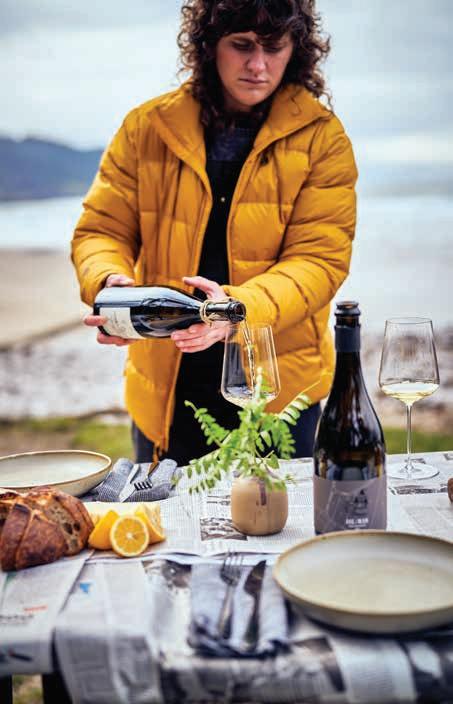
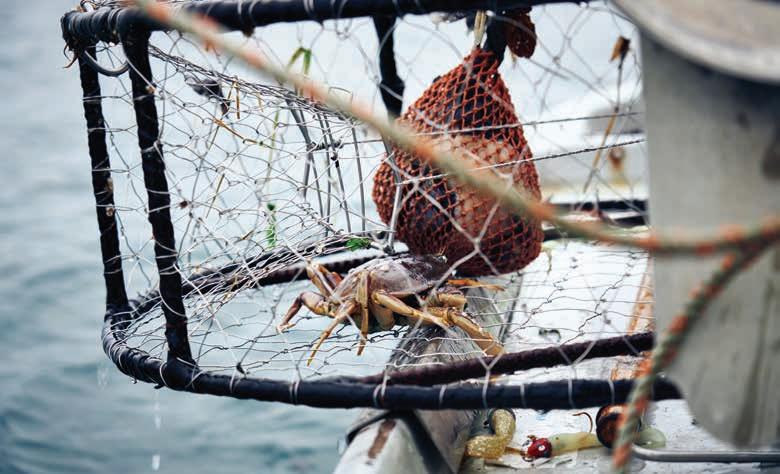
On the drive out to the Oregon Coast from McMinnville, gnarled
oaks drip with lichen and make way for cloud-blanketed shores. A fresh salinity lingers in the damp ocean air as we look out at Haystack Rock in the distance. Our group—which includes Harrison and assistant winemaker Mimi Adams—sets out on the Nestucca River in our crabbing boat. A single bald eagle flies overhead, and the Oregon air is so clean that it almost stings my Angeleno eyes. While in tasting rooms, I might geek

out on coastal influence and diurnal shifts, but here I actually feel the natural phenomena at work. It’s a visceral connection to what makes this winemaking region so special.
“Sometimes as a winemaking and hospitality community, we just stop short. We talk about the percentage of new oak and the wind and the soil, and that’s as far as we can go,” says Harrison. “But if you draw that experience on paper, erase the walls, and
pull people out onto the ocean and stand on the soil, all of a sudden the experience takes on a new meaning that you just can’t find indoors.”
We pull up our traps and eventually unload our haul of Dungeness crabs at Cape Lookout, where a lavish spread is set forth by the Antica Terra team. A giant picnic table lined with newspaper is decorated artistically with huge hunks of French butter dusted with fleur de sel, delicate
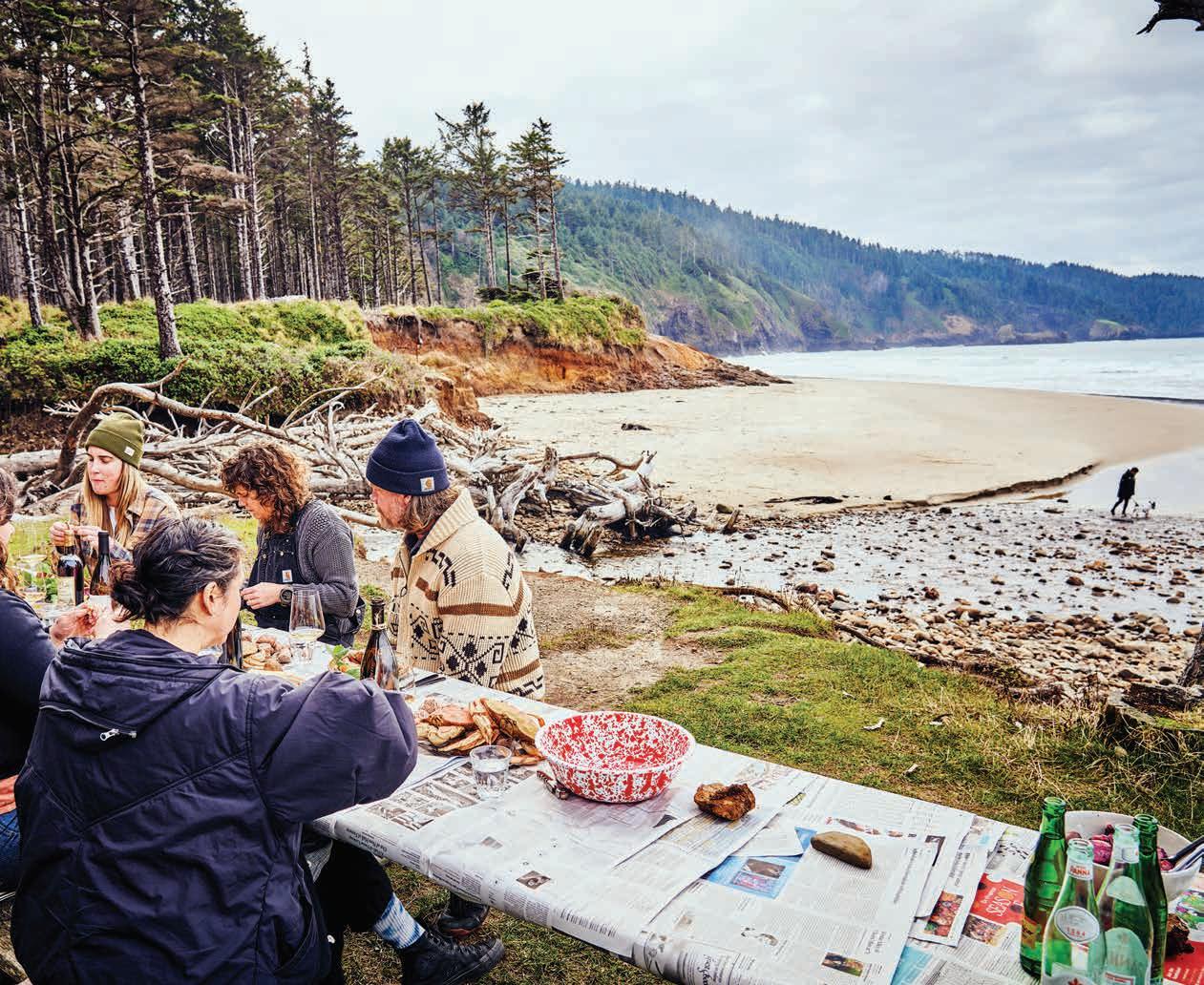
speckled Oregon chicories, French breakfast radishes, and copper saucier pots filled with melted butter for dipping, and the most perfect crusty sourdough bread. It’s almost too pretty to eat. Almost
There’s a real synergy between the salt air, the freshest seafood, and Antica Terra’s wines. After cracking open a claw and drenching it in butter, I take a sip of Harrison’s Aequorin Chardonnay, and a steely, saline minerality
shines through. The wine is named after jellyfish, which are able to navigate and thrive in the darkest abyss of the deep sea. Similarly, these wines are blended blind by Harrison and Adams. The result is a clear reflection of the landscape in a glass.
Making our way back to the heart of McMinnville, we check in at the new Tributary Hotel, located in a 100-year-old historic building with an ambitious, Michelin-worthy restaurant ōkta that owns and operates its own fully regenerative farm. Walking up the stairs into the cozy boutique hotel, guests are greeted by opulentyet-charming suites, each of which are named after a river in Oregon and
come with a cozy fireplace, oversize soaking tubs, well-curated bookshelves, and even better-stocked minibars. (Jose Gourmet tinned fish and artisan crisps? Yes please.)
Chef Matthew Lightner, an alum of Michelin-starred Atera, has literal boots on the ground overseeing the operation from seed to fork. While the tasting menu could be taken to big cities like New York or San Francisco and fare well, the experience is uniquely Oregonian.
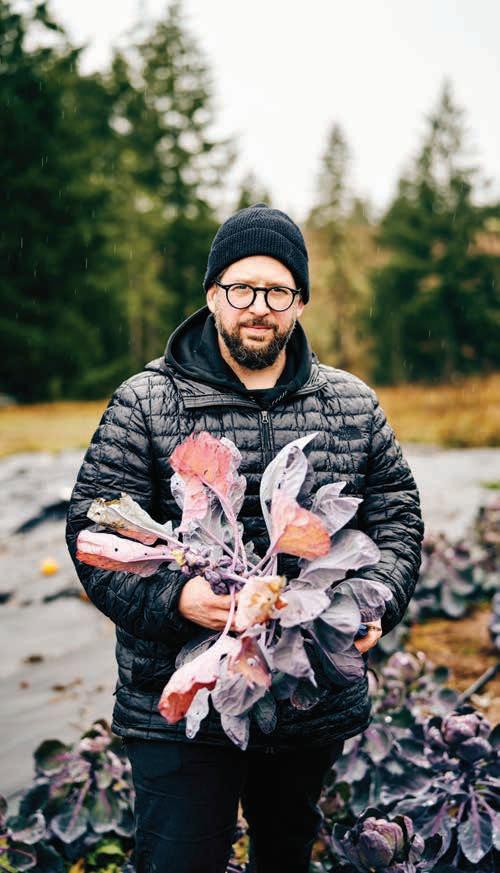
Each morning, a massive breakfast utilizing elements from the farm arrives at your door, and it is nothing short of life-changing. Smoky housecured rashers of bacon, breads and
From left: Chef Matthew Lightner on Tributary Hotel’s regenerative farm; Haley Byer baking for the property’s pastry program; a dish at ōkta using the farm’s produce; cozy bedding at Tributary Hotel; the dining room at ōkta.
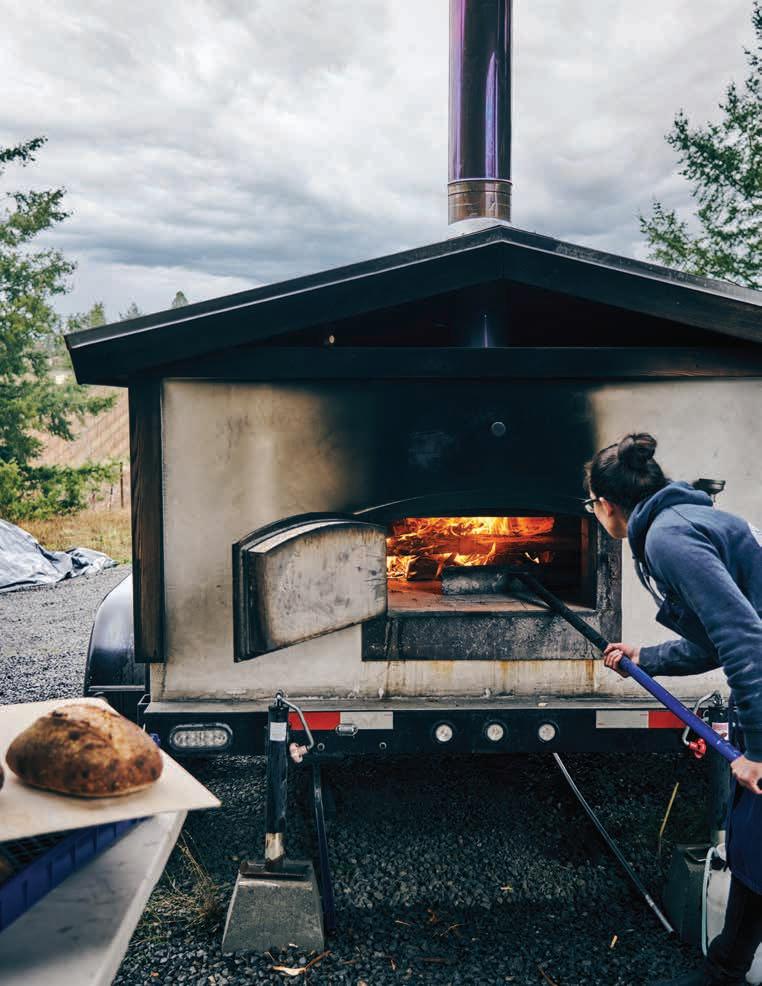
pastries that rival the finest French boulangerie, and stewed white beans with local chanterelles are just a few of the gems that made up the best breakfast of my entire life. It would be all too easy to stay inside by the fire while grazing over the spread. But walking the off-site farm with Lightner takes things to a whole different level.
As Smola-Folti told me when I first arrived: “If people can’t see, taste, feel, and touch the land, it’s hard to create an appreciation for regenerative agriculture and the products we produce as farmers. But when you can give people immersive experiences, you can change the world.”
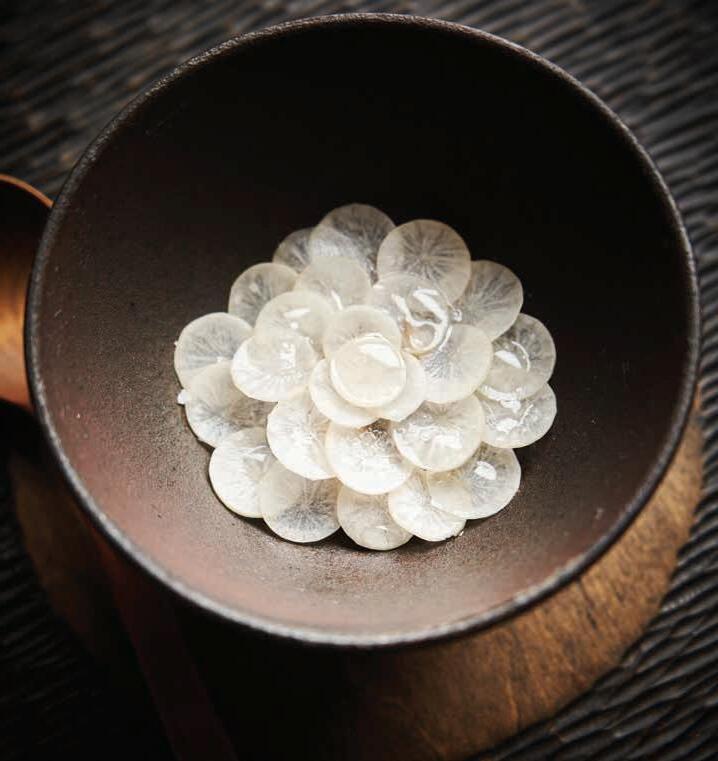

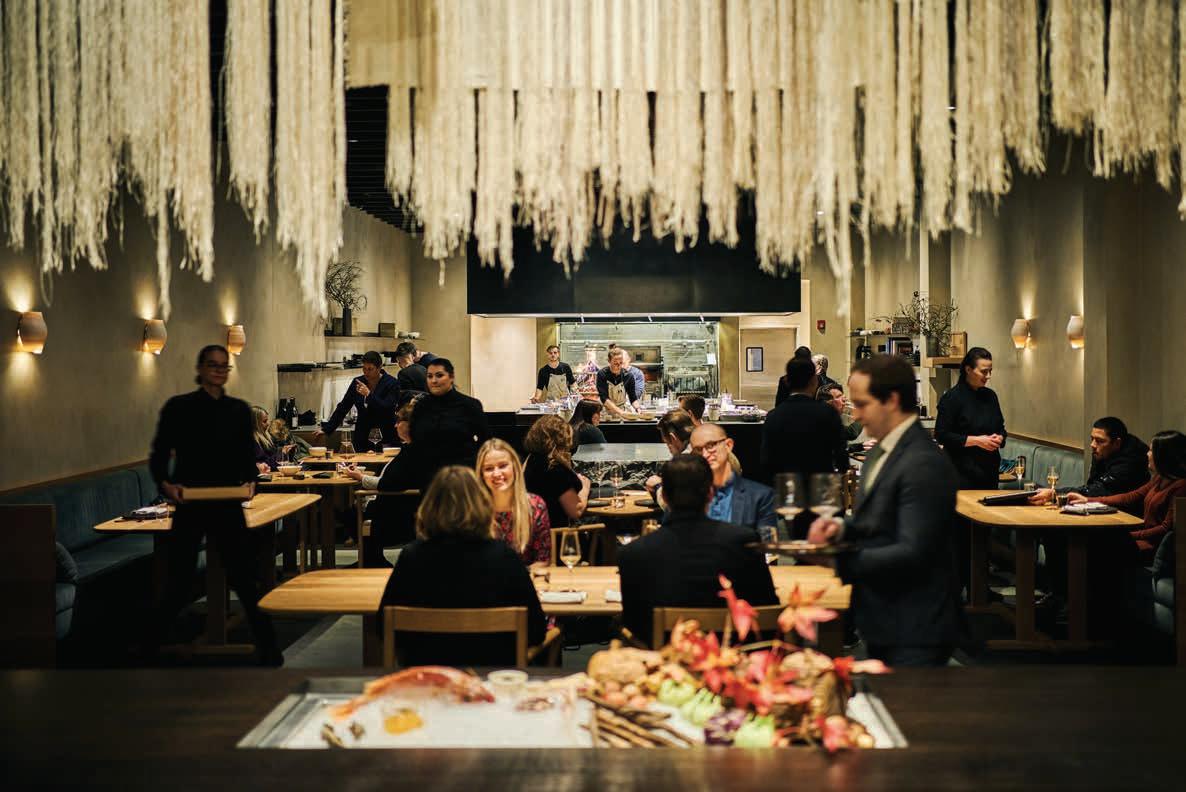
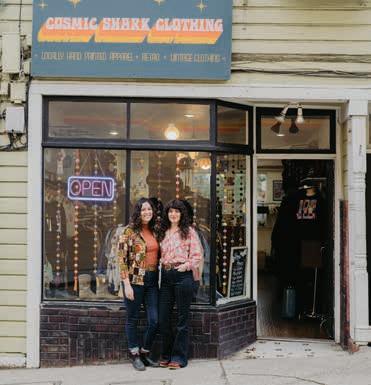
The insider: Anne
 L’Esperance Designer and Owner of An Ellipsis Design
L’Esperance Designer and Owner of An Ellipsis Design
Nestled in the Sierra Nevada foothills, Grass Valley and Nevada City have in been known for their Gold Rush history and proximity to epic outdoor adventure. Recently, two storied hotels—the Holbrooke and the National Exchange—have been revamped, drawing new attention to the area. Anne L’Esperance, the designer behind the projects, shares her favorite spots for travelers.
serves up great cocktails. The speakeasy vibes come equipped with ghost stories and tales of who and what used to run through the tunnels that are behind the back bar’s iron doors.”
Stop in at Heartwood , a “great, healthy lunch spot that serves bowls, salads, and soups.” Three Forks is a “local favorite with a great locally sourced menu that changes often. Baked goods, coffee, wood-fired pizza and beer. You can cover all three meals of the day here and find something new every time.”
Pop into the Golden Era. “They often have live music and make beautiful cocktails. I am definitely a fan of their whiskey sour, don’t miss it.” Iron Door is “historic and moody, and
The National Exchange Hotel , which locals refer to as “The Nash,” is “the spot for cozy conversations and late nights.”
Don’t miss out on dining at Lola, “where there is often a live pianist playing throughout the evening.”
The sister property of the Nash, The Holbrooke Hotel , has “somewhat more of a masculine aesthetic with worn leather couches, warm wool blankets, rough-hewn wood and original stone walls."


Take a trek through town and down to the Tribute Trail, which “memorializes the early contributions of native Nisenan and
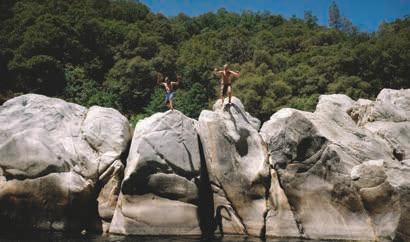
Chinese people to the history of the area.” A visit to the region “isn’t complete without a trip to the Yuba River. There are many places to find gorgeous blue swimming holes and trails that go along the water for miles. Do your research, park legally, be respectful to the land, and pack-in/ pack-out.”
Kitkitdizzi is “always a must when strolling down Broad Street. The space is always changing and the ladies’ keen eye for design is always drawing in passersby.” You’ll also want to hit some of the vintage shops in Grass Valley, like Sunchild’s Parlour and Cosmic Shark . The latter “not only has a killer selection of vintage clothes and footwear, they are a screenprinting company that puts out creative prints that make great takehome souvenirs.”
Iron Door Cosmic Shark Yuba River The National Exchange HotelThis month: Jackson Hole, WY
The insider:
Connie Kemmerer
Jackson Hole Mountain Resort
Co-owner and Via Ferrata Enthusiast
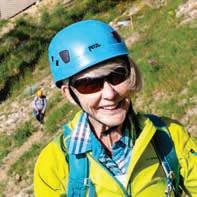
It’s no secret that Jackson Hole is one of best ski towns in the United States, but the Wyoming destination doesn’t just shut down when the snow stops falling. Adventurers visit throughout the spring and summer to hike, mountain bike, and try their luck at Jackson Hole Mountain Resort’s Via Ferrata, a fixedroute of rock climbing with roots dating back to World War I. We asked Connie Kemmerer about her favorite spots in and around her mountain hometown.
For “a modern, boutique hotel located at the base of Jackson Hole Mountain Resort, look no further than Hotel Terra .” Or stay at the Teton Mountain Lodge, for a Western feel with serious luxury. And for those looking for an action-sports-based offering, check out Continuum .”
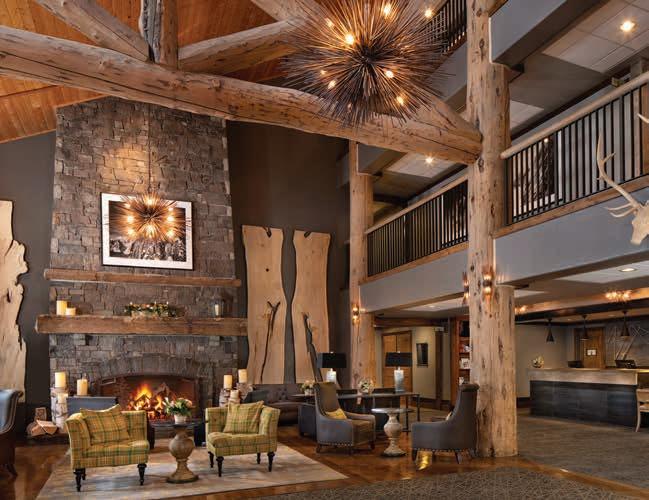

“Few restaurants in America offer the views like the
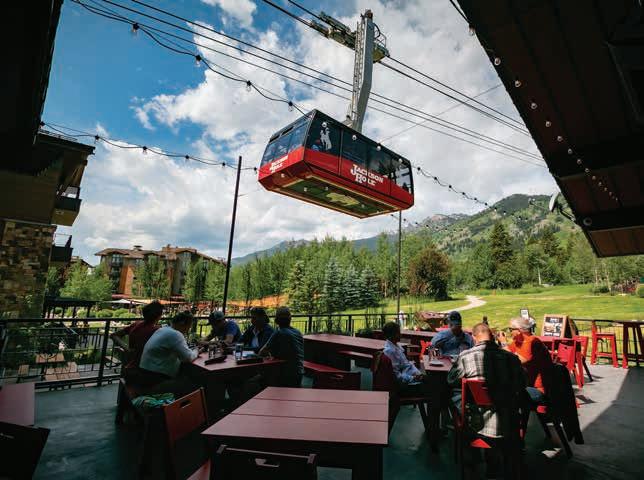
patio deck at Piste Mountain Bistro, located 2,700 vertical feet above the valley floor. And no trip to Jackson would be complete without experiencing a waffle at 10,000 feet at the historic Corbet Cabin .” After sweating it out on the mountain, unwind with a “cold beer to finish the day at RPK3.”
Though it might seem intimidating at first, “ the Via Ferrata at Jackson Hole Mountain Resort welcomes all comers with more than a dozen vertical routes, including three new routes opening this spring.” For hiking, “a favorite is Wild Flower Trail .”

Teton Village is a onestop shop for all your adventures. “ Teton Village Sports carries rentals of both e-bikes and pedals, perfect for a scenic trip under the Tetons. Augment any climbing gear you might need at Teton Mountaineering .” Or, if you’d rather see the region on wheels, check out “Jackson Hole Sports or Hoback Sports, , located in the town of Jackson, the go-to bike shop for locals.”
The Via Ferrata Teton Mountain Lodge RPK3 RPK3This month: Reno, NV
Even in Reno’s funky and fashionable Midtown neighborhood, Natural Selection stands out. Emily Felch and mother Marcy’s curiosity shop is full of taxidermy, carnivorous plants, bones, and skulls. Emily’s Reno tips are as varied as the stock in her shop.

The insider: Emily Felch Co-owner of The Natural Selection Store
Perenn has raised the bar on boules and baguettes in Reno. “I definitely recommend stopping by and picking up a danish or a kouign amann,” says Felch. A family favorite for Thai food is Midtown’s Moo Dang . “It's so good that my dad and sister eat there twice a week. The drunken noodles with moo dang pork are spicy and delicious.”

For a good plain cup of joe, Magpie Coffee Roasters is a local haunt.
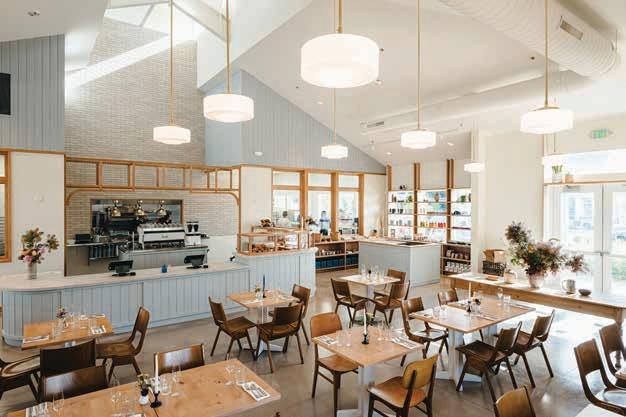
“No frills, frappes, or super-sugary drinks,” says Felch. “Just good coffee.” After a long day at the shop among the animals and cacti, Felch repairs to Death and Taxes, Reno’s foremost craft cocktail bar, tricked out in triple black. “It’s goth kid’s dream bar,” says Felch. “Exquisite style and even better cocktails.”
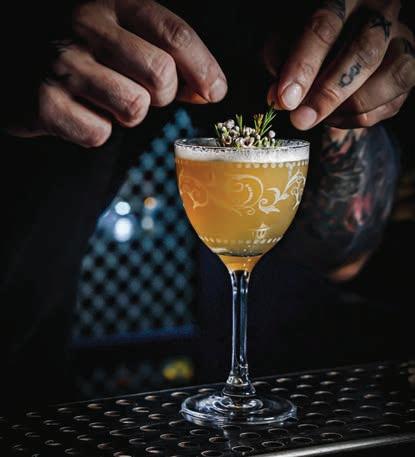
Reno Rodeo is a landmark event in the area. “Call us a little Wild West,” says Felch. “But there’s something really great about cattle roping and some good ol’ classic American culture.” For

contemporary counter culture she frequents
The Holland Project
“They host bands big and small, local art shows, and other indie events with a punk rock attitude.” But Reno’s not all rodeos and rock for Felch, who de-stresses at Healing One Float Center. “Although laying in a sensory deprivation tank may sound intimidating, it’s a great way to meditate and relax,” she says.
“Sensory deprivation lowers the cortisol levels, meaning you’ll find yourself much more at ease.”
Felch cites the Wilbur D. May Museum at Rancho San Rafael, the former home of a turn-of-thecentury rancher, adventurer, and philanthropist, as a major influence on her work. “There’s a trophy room with tons of crazy artifacts Wilbur May collected over the years. It's pretty much what I want my future house to look like.” She also recommends Rancho San Rafael’s arboretum for a gentle walk, the Nevada Museum of Art for contemporary traveling shows, and the Discovery Museum for kids.




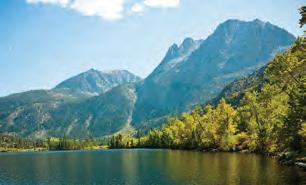






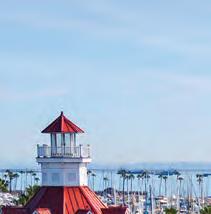


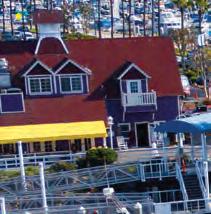
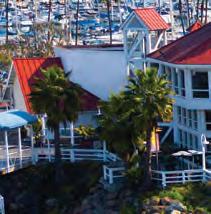
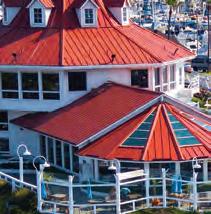

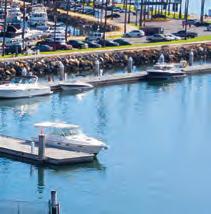



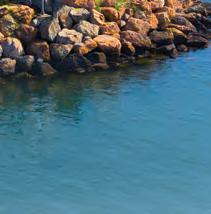




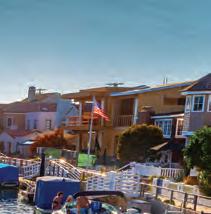

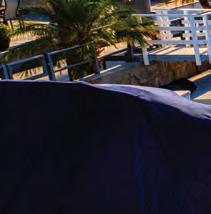







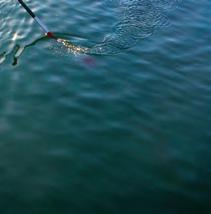






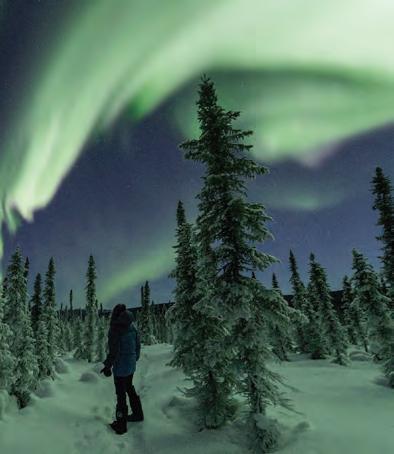

















Three rivers and seven wilderness areas meet in Missoula, Montana, a small town with extraordinary personality and transcendent charm. It’s ecstasy for the outdoorsy—an essential escape to the fresh mountain air. A chance to rest and renew, unplug from the everyday and plug into nature. Be nourished and eat well in this hip little community and culinary hot spot where local food reigns, and soak in the serenity of some of the world’s most soul-stirring landscapes. Book your stay and plan your getaway to Missoula, Montana.








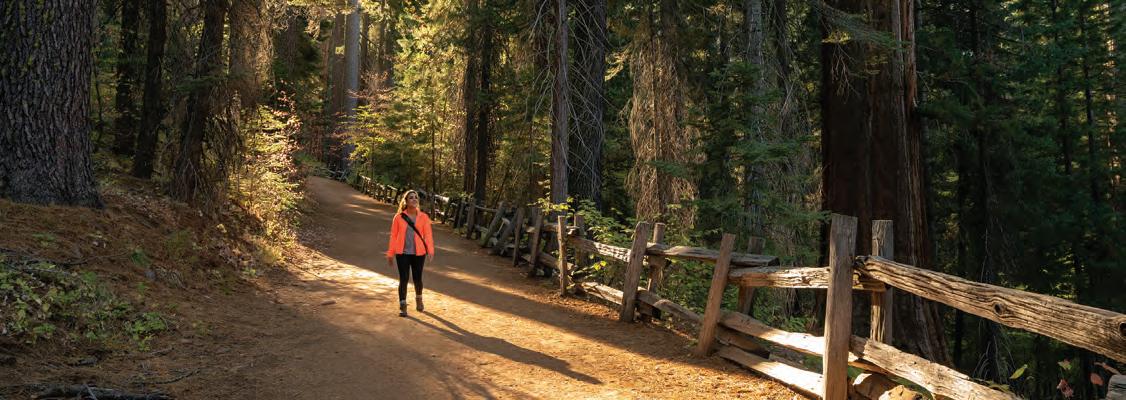

Sensory immersion artist Jobi Manson leads bespoke water healing experiences that encourage meditators to embrace the nature within.
Interview by KRISTA SIMMONSAs the founder of Sefari and the one of the Masters in Residence at select Auberge properties, Jobi Manson is passionate about creating unique, water-based healing experiences both in the sea and in hot springs, helping her clients emerge anew.

Tell us a little about hydrotherapy. What does that mean exactly?
Forms of hydrotherapy have been around for thousands of years. Using water as a healing space is one of the oldest ways that cultures have ritualized the experience of connection and purification. My work is dedicated to exploring the experience of healing and regeneration by placing the body into the flowing moving cycle of change that exists in water, and helping someone be with that change.
The easiest way to explain it is that it’s a form of elemental meditation—the practice of cultivating intentional connection with the natural world. I am fascinated by the way that humans can hold knowledge in the form of memory. These journeys open up the space for memories, where we hold our lived experience. It’s how our body holds one’s record of life.
Why were you drawn to doing your work in nature, in the ocean or hot springs, instead of in a pool? Surely there have to be plenty of those in SoCal where you work.
I feel that it’s really hard to relate to what we don’t feel; nature helps open the body in mysterious and powerful ways, and when we are open and connected, we are experiencing what it feels like to be alive.
Water is a very special and particular environment to work in. Without getting into the very complex physics and science, water is alive, and it’s alive because it’s an elemental force. The structure and integrity of water— and working in natural water sources that are uncompromised by human impact—is really important. The conditions of relaxation and ease of immersing in a body of water relaxes our muscles and shifts our circulation.
There’s been a lot said about the Blue Mind, and how being around water is incredibly therapeutic for the mind. Is that something you see in your work? Absolutely, that’s a huge part of my work. When I work with someone, I look to create a deep experience of relaxation so they can have the clear space of presence to think, to feel, to be. And there’s something very unique that
happens to the body when it’s in a body of water.
The changes that our body experiences on the physiological level when we immerse ourselves are immense. It shifts the state of the mind, and in that shifting, in that delta, new thoughts, new connections, new ideas come, and creativity emerges.
Walk us through what hydrotherapy will look like with you?
The kind of Sefari that happens in the ocean starts at sunrise because when we attune to the light cycles of nature, meaning we rise with the light, we tune into a biorhythm and attune our natural clocks. We meet on the beach, and spent a little time surveying the inner and outer landscape. There’s conversation and dialogue around where someone is presently, and where they’re seeking to go.
And then we go out together into the unknown space of the sea and we spend time there. And we spend time journeying in a guided meditation and visualization and in that time the unknown around you and within you presents itself. We discover and become more aware of what’s happening around us and within us.
Once that’s complete, we come in and essentially reflect on what emerged. A lot of times people find me in a state of transition and are seeking greater clarity in an area of their life— whether that be a relationship or work or with a family situation or with finances. Ultimately, it allows for clarity by creating a new space to see clearly, and being still enough for the dust to settle.
one year.
“ U sing water as a healing space is one of the oldest ways that cultures have ritualized the experience of connection and purification.”

The west rim is heart-pounding, soul-searching, bucket-listchecking adrenaline rushes you’ve never felt or seen before, including one of the largest glass cantilever bridges in the world that will have you stepping 4,000 feet out over the Grand Canyon floor. Skywalk is just one of the ways you can jolt your senses and ignite your spirit at Grand Canyon West. Plan your adventure today.
